Employee Retention Strategies in Logistics
VerifiedAdded on 2020/02/24
|40
|11358
|347
AI Summary
This assignment delves into the critical topic of employee retention within the Singaporean logistics industry. It examines various factors that contribute to or hinder employee retention, focusing on the unique challenges and opportunities presented by this sector. The goal is to analyze effective strategies for improving employee retention in the context of the Singaporean logistics industry.
Contribute Materials
Your contribution can guide someone’s learning journey. Share your
documents today.
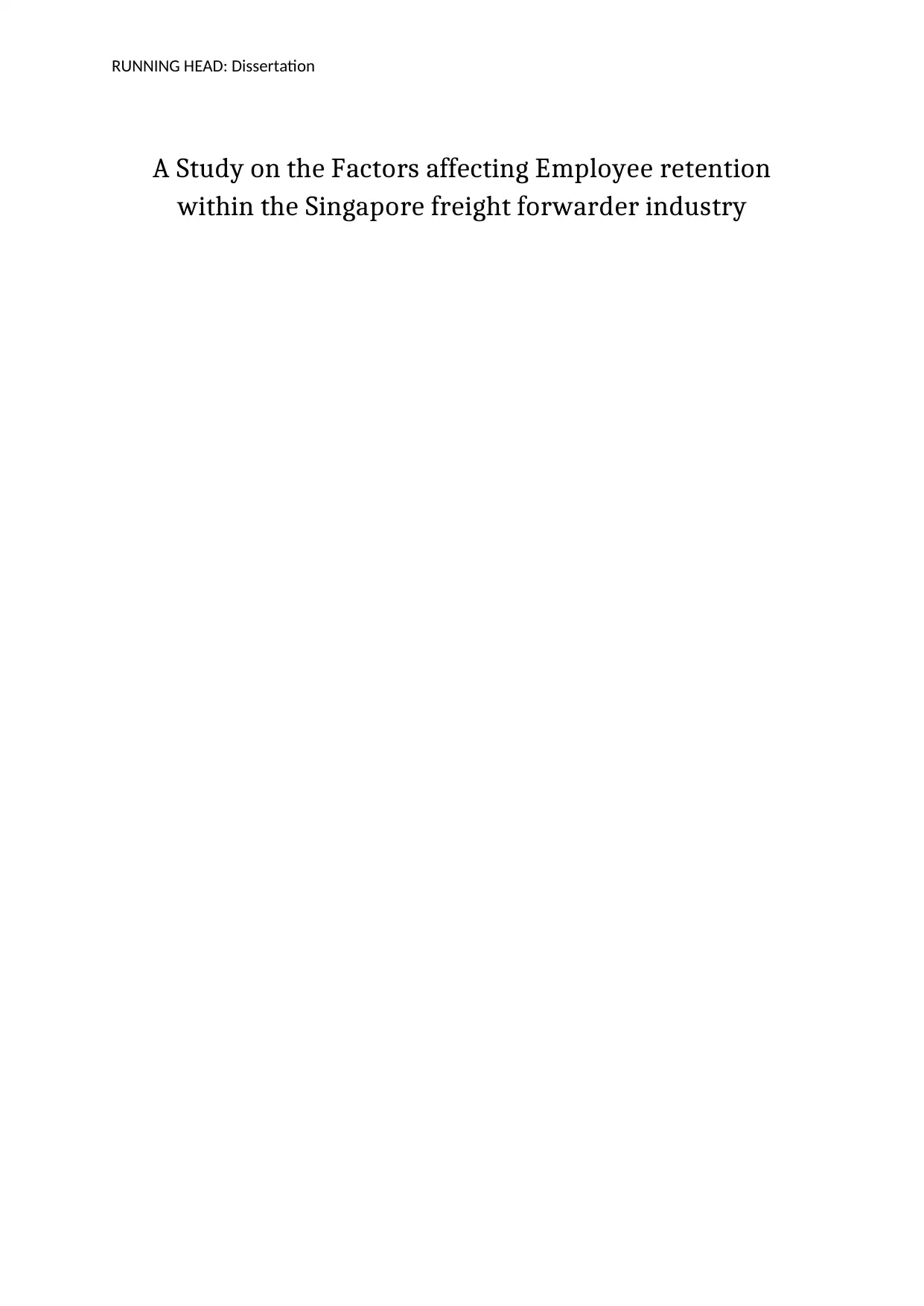
RUNNING HEAD: Dissertation
A Study on the Factors affecting Employee retention
within the Singapore freight forwarder industry
A Study on the Factors affecting Employee retention
within the Singapore freight forwarder industry
Secure Best Marks with AI Grader
Need help grading? Try our AI Grader for instant feedback on your assignments.
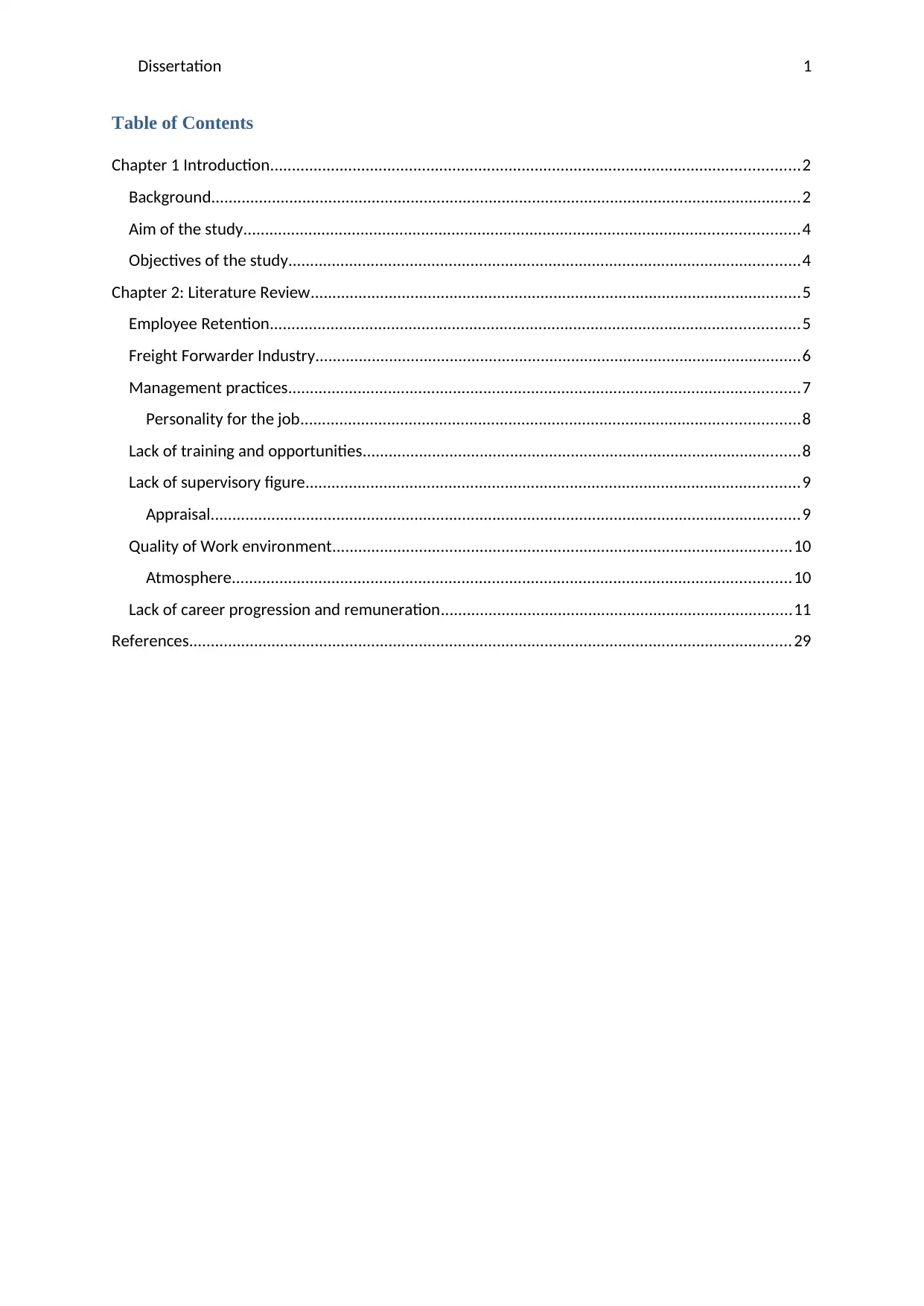
Dissertation 1
Table of Contents
Chapter 1 Introduction..........................................................................................................................2
Background........................................................................................................................................2
Aim of the study................................................................................................................................4
Objectives of the study......................................................................................................................4
Chapter 2: Literature Review.................................................................................................................5
Employee Retention..........................................................................................................................5
Freight Forwarder Industry................................................................................................................6
Management practices......................................................................................................................7
Personality for the job...................................................................................................................8
Lack of training and opportunities.....................................................................................................8
Lack of supervisory figure..................................................................................................................9
Appraisal........................................................................................................................................9
Quality of Work environment..........................................................................................................10
Atmosphere.................................................................................................................................10
Lack of career progression and remuneration.................................................................................11
References...........................................................................................................................................29
Table of Contents
Chapter 1 Introduction..........................................................................................................................2
Background........................................................................................................................................2
Aim of the study................................................................................................................................4
Objectives of the study......................................................................................................................4
Chapter 2: Literature Review.................................................................................................................5
Employee Retention..........................................................................................................................5
Freight Forwarder Industry................................................................................................................6
Management practices......................................................................................................................7
Personality for the job...................................................................................................................8
Lack of training and opportunities.....................................................................................................8
Lack of supervisory figure..................................................................................................................9
Appraisal........................................................................................................................................9
Quality of Work environment..........................................................................................................10
Atmosphere.................................................................................................................................10
Lack of career progression and remuneration.................................................................................11
References...........................................................................................................................................29
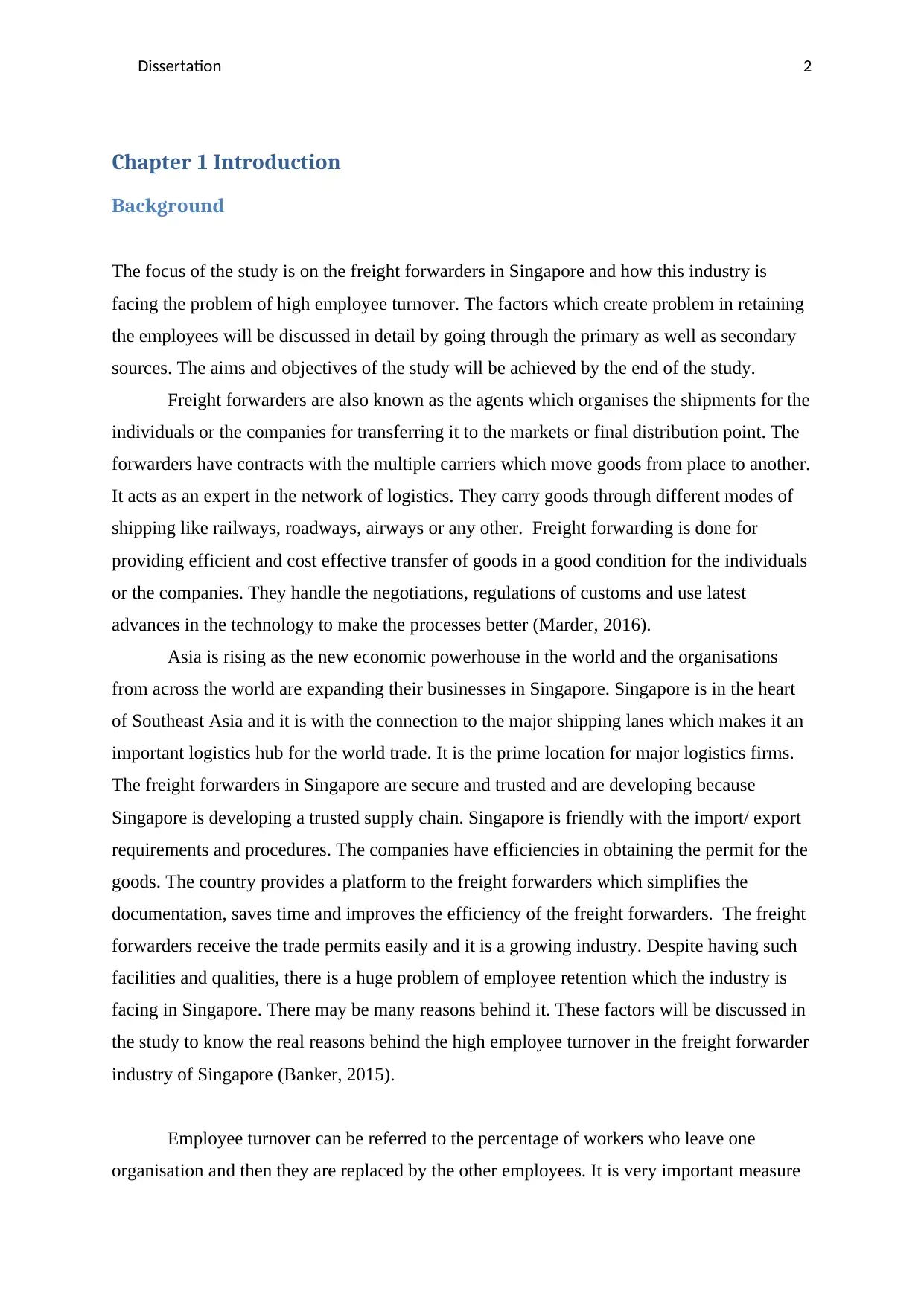
Dissertation 2
Chapter 1 Introduction
Background
The focus of the study is on the freight forwarders in Singapore and how this industry is
facing the problem of high employee turnover. The factors which create problem in retaining
the employees will be discussed in detail by going through the primary as well as secondary
sources. The aims and objectives of the study will be achieved by the end of the study.
Freight forwarders are also known as the agents which organises the shipments for the
individuals or the companies for transferring it to the markets or final distribution point. The
forwarders have contracts with the multiple carriers which move goods from place to another.
It acts as an expert in the network of logistics. They carry goods through different modes of
shipping like railways, roadways, airways or any other. Freight forwarding is done for
providing efficient and cost effective transfer of goods in a good condition for the individuals
or the companies. They handle the negotiations, regulations of customs and use latest
advances in the technology to make the processes better (Marder, 2016).
Asia is rising as the new economic powerhouse in the world and the organisations
from across the world are expanding their businesses in Singapore. Singapore is in the heart
of Southeast Asia and it is with the connection to the major shipping lanes which makes it an
important logistics hub for the world trade. It is the prime location for major logistics firms.
The freight forwarders in Singapore are secure and trusted and are developing because
Singapore is developing a trusted supply chain. Singapore is friendly with the import/ export
requirements and procedures. The companies have efficiencies in obtaining the permit for the
goods. The country provides a platform to the freight forwarders which simplifies the
documentation, saves time and improves the efficiency of the freight forwarders. The freight
forwarders receive the trade permits easily and it is a growing industry. Despite having such
facilities and qualities, there is a huge problem of employee retention which the industry is
facing in Singapore. There may be many reasons behind it. These factors will be discussed in
the study to know the real reasons behind the high employee turnover in the freight forwarder
industry of Singapore (Banker, 2015).
Employee turnover can be referred to the percentage of workers who leave one
organisation and then they are replaced by the other employees. It is very important measure
Chapter 1 Introduction
Background
The focus of the study is on the freight forwarders in Singapore and how this industry is
facing the problem of high employee turnover. The factors which create problem in retaining
the employees will be discussed in detail by going through the primary as well as secondary
sources. The aims and objectives of the study will be achieved by the end of the study.
Freight forwarders are also known as the agents which organises the shipments for the
individuals or the companies for transferring it to the markets or final distribution point. The
forwarders have contracts with the multiple carriers which move goods from place to another.
It acts as an expert in the network of logistics. They carry goods through different modes of
shipping like railways, roadways, airways or any other. Freight forwarding is done for
providing efficient and cost effective transfer of goods in a good condition for the individuals
or the companies. They handle the negotiations, regulations of customs and use latest
advances in the technology to make the processes better (Marder, 2016).
Asia is rising as the new economic powerhouse in the world and the organisations
from across the world are expanding their businesses in Singapore. Singapore is in the heart
of Southeast Asia and it is with the connection to the major shipping lanes which makes it an
important logistics hub for the world trade. It is the prime location for major logistics firms.
The freight forwarders in Singapore are secure and trusted and are developing because
Singapore is developing a trusted supply chain. Singapore is friendly with the import/ export
requirements and procedures. The companies have efficiencies in obtaining the permit for the
goods. The country provides a platform to the freight forwarders which simplifies the
documentation, saves time and improves the efficiency of the freight forwarders. The freight
forwarders receive the trade permits easily and it is a growing industry. Despite having such
facilities and qualities, there is a huge problem of employee retention which the industry is
facing in Singapore. There may be many reasons behind it. These factors will be discussed in
the study to know the real reasons behind the high employee turnover in the freight forwarder
industry of Singapore (Banker, 2015).
Employee turnover can be referred to the percentage of workers who leave one
organisation and then they are replaced by the other employees. It is very important measure
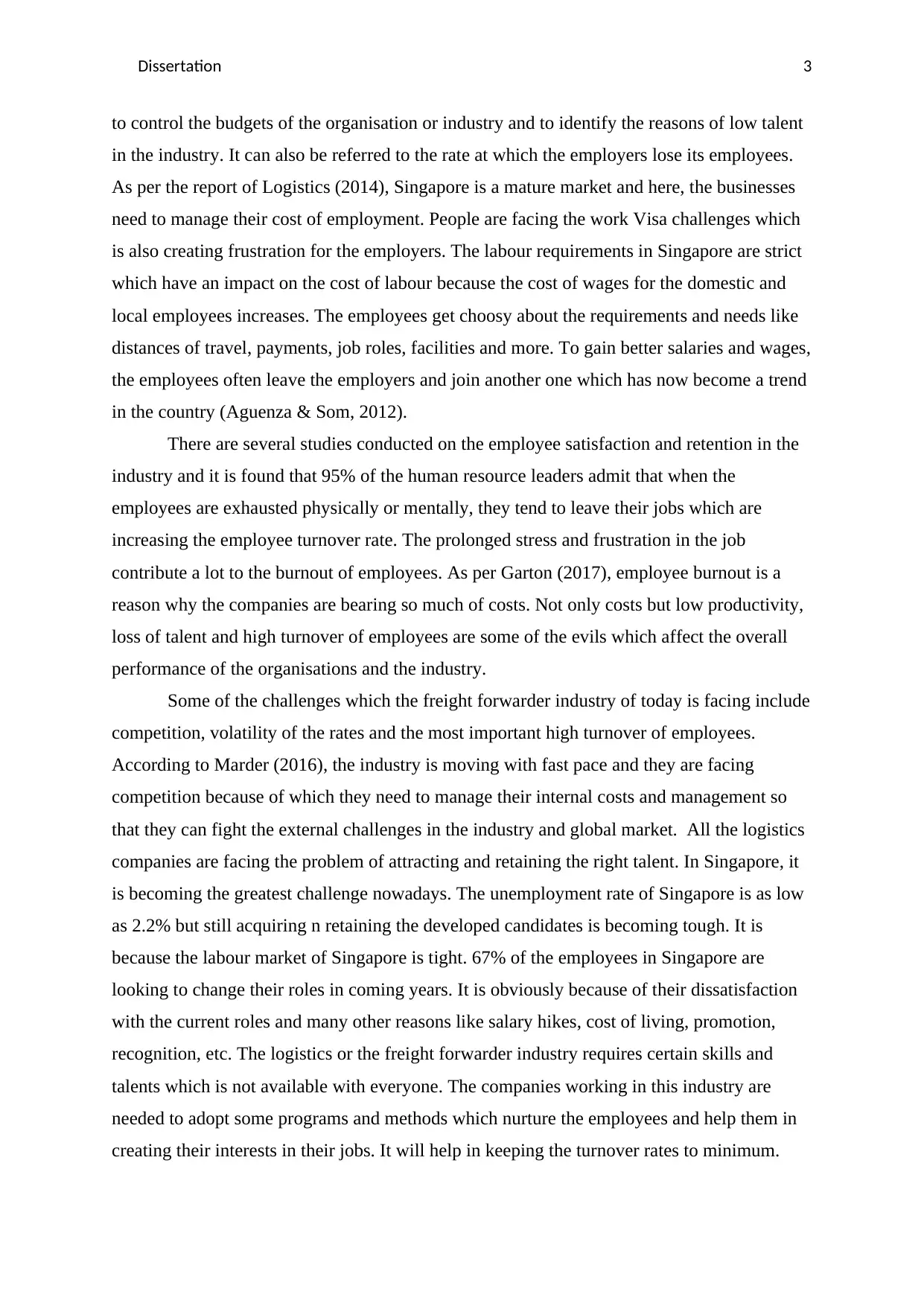
Dissertation 3
to control the budgets of the organisation or industry and to identify the reasons of low talent
in the industry. It can also be referred to the rate at which the employers lose its employees.
As per the report of Logistics (2014), Singapore is a mature market and here, the businesses
need to manage their cost of employment. People are facing the work Visa challenges which
is also creating frustration for the employers. The labour requirements in Singapore are strict
which have an impact on the cost of labour because the cost of wages for the domestic and
local employees increases. The employees get choosy about the requirements and needs like
distances of travel, payments, job roles, facilities and more. To gain better salaries and wages,
the employees often leave the employers and join another one which has now become a trend
in the country (Aguenza & Som, 2012).
There are several studies conducted on the employee satisfaction and retention in the
industry and it is found that 95% of the human resource leaders admit that when the
employees are exhausted physically or mentally, they tend to leave their jobs which are
increasing the employee turnover rate. The prolonged stress and frustration in the job
contribute a lot to the burnout of employees. As per Garton (2017), employee burnout is a
reason why the companies are bearing so much of costs. Not only costs but low productivity,
loss of talent and high turnover of employees are some of the evils which affect the overall
performance of the organisations and the industry.
Some of the challenges which the freight forwarder industry of today is facing include
competition, volatility of the rates and the most important high turnover of employees.
According to Marder (2016), the industry is moving with fast pace and they are facing
competition because of which they need to manage their internal costs and management so
that they can fight the external challenges in the industry and global market. All the logistics
companies are facing the problem of attracting and retaining the right talent. In Singapore, it
is becoming the greatest challenge nowadays. The unemployment rate of Singapore is as low
as 2.2% but still acquiring n retaining the developed candidates is becoming tough. It is
because the labour market of Singapore is tight. 67% of the employees in Singapore are
looking to change their roles in coming years. It is obviously because of their dissatisfaction
with the current roles and many other reasons like salary hikes, cost of living, promotion,
recognition, etc. The logistics or the freight forwarder industry requires certain skills and
talents which is not available with everyone. The companies working in this industry are
needed to adopt some programs and methods which nurture the employees and help them in
creating their interests in their jobs. It will help in keeping the turnover rates to minimum.
to control the budgets of the organisation or industry and to identify the reasons of low talent
in the industry. It can also be referred to the rate at which the employers lose its employees.
As per the report of Logistics (2014), Singapore is a mature market and here, the businesses
need to manage their cost of employment. People are facing the work Visa challenges which
is also creating frustration for the employers. The labour requirements in Singapore are strict
which have an impact on the cost of labour because the cost of wages for the domestic and
local employees increases. The employees get choosy about the requirements and needs like
distances of travel, payments, job roles, facilities and more. To gain better salaries and wages,
the employees often leave the employers and join another one which has now become a trend
in the country (Aguenza & Som, 2012).
There are several studies conducted on the employee satisfaction and retention in the
industry and it is found that 95% of the human resource leaders admit that when the
employees are exhausted physically or mentally, they tend to leave their jobs which are
increasing the employee turnover rate. The prolonged stress and frustration in the job
contribute a lot to the burnout of employees. As per Garton (2017), employee burnout is a
reason why the companies are bearing so much of costs. Not only costs but low productivity,
loss of talent and high turnover of employees are some of the evils which affect the overall
performance of the organisations and the industry.
Some of the challenges which the freight forwarder industry of today is facing include
competition, volatility of the rates and the most important high turnover of employees.
According to Marder (2016), the industry is moving with fast pace and they are facing
competition because of which they need to manage their internal costs and management so
that they can fight the external challenges in the industry and global market. All the logistics
companies are facing the problem of attracting and retaining the right talent. In Singapore, it
is becoming the greatest challenge nowadays. The unemployment rate of Singapore is as low
as 2.2% but still acquiring n retaining the developed candidates is becoming tough. It is
because the labour market of Singapore is tight. 67% of the employees in Singapore are
looking to change their roles in coming years. It is obviously because of their dissatisfaction
with the current roles and many other reasons like salary hikes, cost of living, promotion,
recognition, etc. The logistics or the freight forwarder industry requires certain skills and
talents which is not available with everyone. The companies working in this industry are
needed to adopt some programs and methods which nurture the employees and help them in
creating their interests in their jobs. It will help in keeping the turnover rates to minimum.
Secure Best Marks with AI Grader
Need help grading? Try our AI Grader for instant feedback on your assignments.
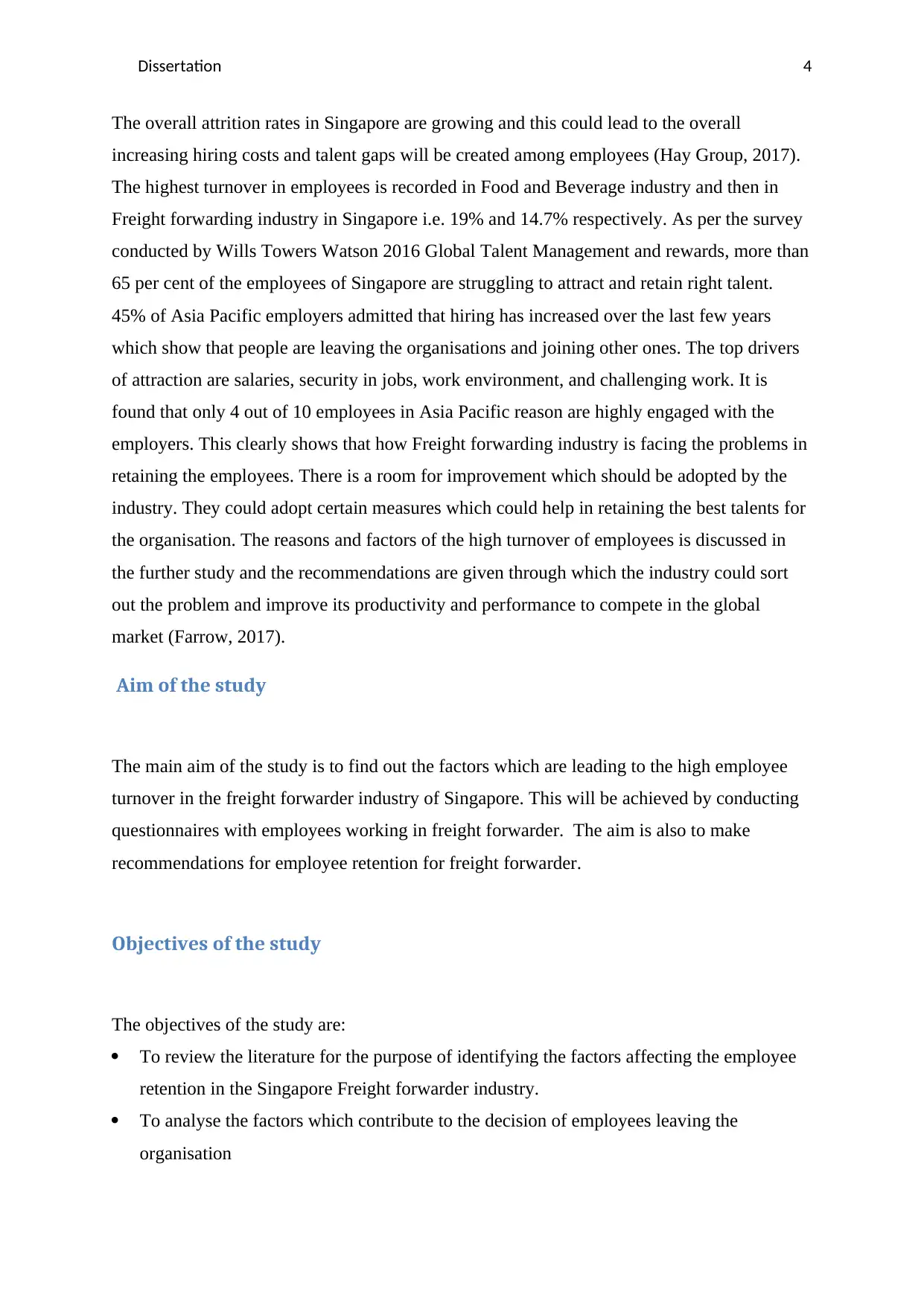
Dissertation 4
The overall attrition rates in Singapore are growing and this could lead to the overall
increasing hiring costs and talent gaps will be created among employees (Hay Group, 2017).
The highest turnover in employees is recorded in Food and Beverage industry and then in
Freight forwarding industry in Singapore i.e. 19% and 14.7% respectively. As per the survey
conducted by Wills Towers Watson 2016 Global Talent Management and rewards, more than
65 per cent of the employees of Singapore are struggling to attract and retain right talent.
45% of Asia Pacific employers admitted that hiring has increased over the last few years
which show that people are leaving the organisations and joining other ones. The top drivers
of attraction are salaries, security in jobs, work environment, and challenging work. It is
found that only 4 out of 10 employees in Asia Pacific reason are highly engaged with the
employers. This clearly shows that how Freight forwarding industry is facing the problems in
retaining the employees. There is a room for improvement which should be adopted by the
industry. They could adopt certain measures which could help in retaining the best talents for
the organisation. The reasons and factors of the high turnover of employees is discussed in
the further study and the recommendations are given through which the industry could sort
out the problem and improve its productivity and performance to compete in the global
market (Farrow, 2017).
Aim of the study
The main aim of the study is to find out the factors which are leading to the high employee
turnover in the freight forwarder industry of Singapore. This will be achieved by conducting
questionnaires with employees working in freight forwarder. The aim is also to make
recommendations for employee retention for freight forwarder.
Objectives of the study
The objectives of the study are:
To review the literature for the purpose of identifying the factors affecting the employee
retention in the Singapore Freight forwarder industry.
To analyse the factors which contribute to the decision of employees leaving the
organisation
The overall attrition rates in Singapore are growing and this could lead to the overall
increasing hiring costs and talent gaps will be created among employees (Hay Group, 2017).
The highest turnover in employees is recorded in Food and Beverage industry and then in
Freight forwarding industry in Singapore i.e. 19% and 14.7% respectively. As per the survey
conducted by Wills Towers Watson 2016 Global Talent Management and rewards, more than
65 per cent of the employees of Singapore are struggling to attract and retain right talent.
45% of Asia Pacific employers admitted that hiring has increased over the last few years
which show that people are leaving the organisations and joining other ones. The top drivers
of attraction are salaries, security in jobs, work environment, and challenging work. It is
found that only 4 out of 10 employees in Asia Pacific reason are highly engaged with the
employers. This clearly shows that how Freight forwarding industry is facing the problems in
retaining the employees. There is a room for improvement which should be adopted by the
industry. They could adopt certain measures which could help in retaining the best talents for
the organisation. The reasons and factors of the high turnover of employees is discussed in
the further study and the recommendations are given through which the industry could sort
out the problem and improve its productivity and performance to compete in the global
market (Farrow, 2017).
Aim of the study
The main aim of the study is to find out the factors which are leading to the high employee
turnover in the freight forwarder industry of Singapore. This will be achieved by conducting
questionnaires with employees working in freight forwarder. The aim is also to make
recommendations for employee retention for freight forwarder.
Objectives of the study
The objectives of the study are:
To review the literature for the purpose of identifying the factors affecting the employee
retention in the Singapore Freight forwarder industry.
To analyse the factors which contribute to the decision of employees leaving the
organisation

Dissertation 5
To make recommendations to the freight forwarders for improving the employee
retention
To make recommendations to the freight forwarders for improving the employee
retention
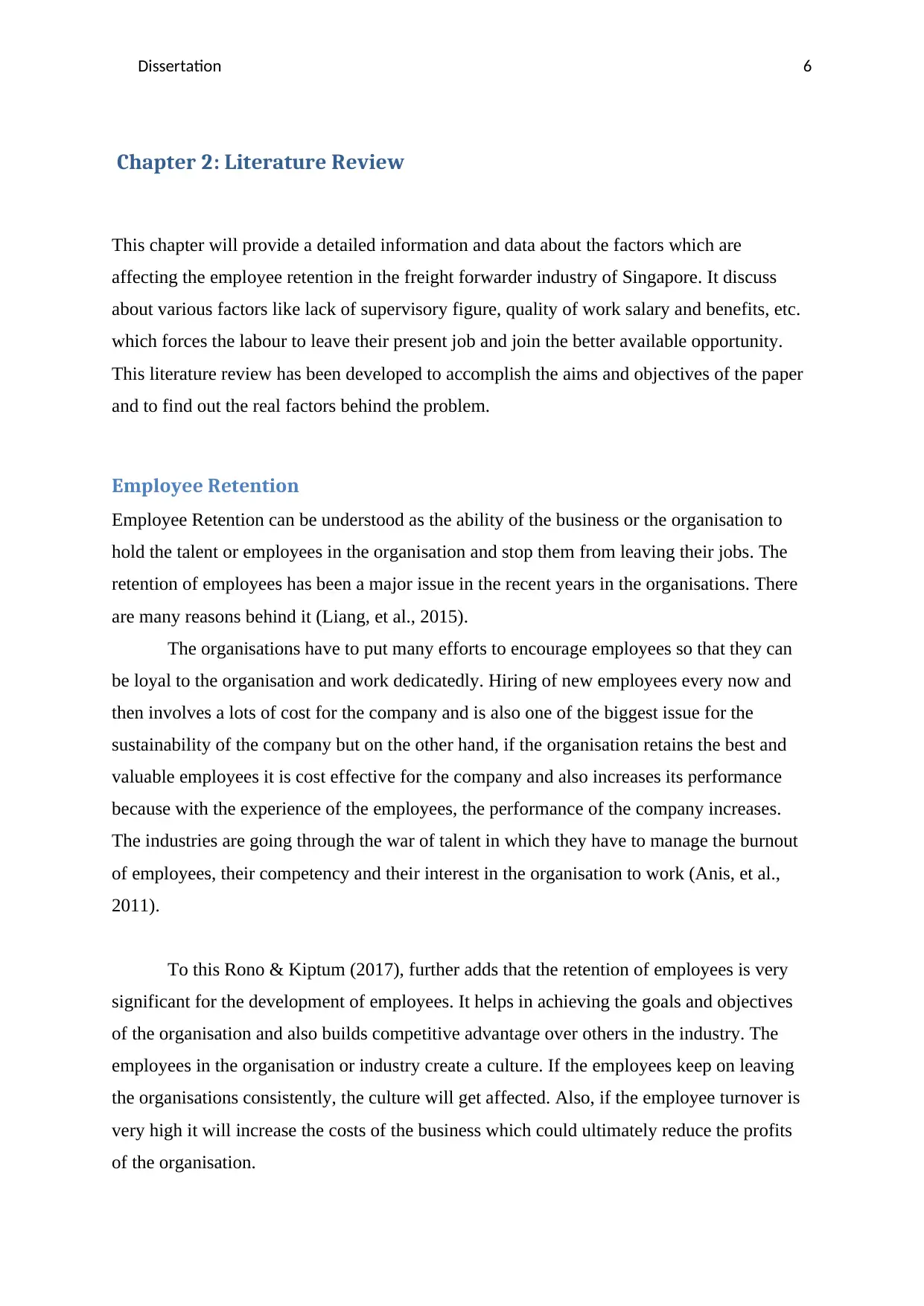
Dissertation 6
Chapter 2: Literature Review
This chapter will provide a detailed information and data about the factors which are
affecting the employee retention in the freight forwarder industry of Singapore. It discuss
about various factors like lack of supervisory figure, quality of work salary and benefits, etc.
which forces the labour to leave their present job and join the better available opportunity.
This literature review has been developed to accomplish the aims and objectives of the paper
and to find out the real factors behind the problem.
Employee Retention
Employee Retention can be understood as the ability of the business or the organisation to
hold the talent or employees in the organisation and stop them from leaving their jobs. The
retention of employees has been a major issue in the recent years in the organisations. There
are many reasons behind it (Liang, et al., 2015).
The organisations have to put many efforts to encourage employees so that they can
be loyal to the organisation and work dedicatedly. Hiring of new employees every now and
then involves a lots of cost for the company and is also one of the biggest issue for the
sustainability of the company but on the other hand, if the organisation retains the best and
valuable employees it is cost effective for the company and also increases its performance
because with the experience of the employees, the performance of the company increases.
The industries are going through the war of talent in which they have to manage the burnout
of employees, their competency and their interest in the organisation to work (Anis, et al.,
2011).
To this Rono & Kiptum (2017), further adds that the retention of employees is very
significant for the development of employees. It helps in achieving the goals and objectives
of the organisation and also builds competitive advantage over others in the industry. The
employees in the organisation or industry create a culture. If the employees keep on leaving
the organisations consistently, the culture will get affected. Also, if the employee turnover is
very high it will increase the costs of the business which could ultimately reduce the profits
of the organisation.
Chapter 2: Literature Review
This chapter will provide a detailed information and data about the factors which are
affecting the employee retention in the freight forwarder industry of Singapore. It discuss
about various factors like lack of supervisory figure, quality of work salary and benefits, etc.
which forces the labour to leave their present job and join the better available opportunity.
This literature review has been developed to accomplish the aims and objectives of the paper
and to find out the real factors behind the problem.
Employee Retention
Employee Retention can be understood as the ability of the business or the organisation to
hold the talent or employees in the organisation and stop them from leaving their jobs. The
retention of employees has been a major issue in the recent years in the organisations. There
are many reasons behind it (Liang, et al., 2015).
The organisations have to put many efforts to encourage employees so that they can
be loyal to the organisation and work dedicatedly. Hiring of new employees every now and
then involves a lots of cost for the company and is also one of the biggest issue for the
sustainability of the company but on the other hand, if the organisation retains the best and
valuable employees it is cost effective for the company and also increases its performance
because with the experience of the employees, the performance of the company increases.
The industries are going through the war of talent in which they have to manage the burnout
of employees, their competency and their interest in the organisation to work (Anis, et al.,
2011).
To this Rono & Kiptum (2017), further adds that the retention of employees is very
significant for the development of employees. It helps in achieving the goals and objectives
of the organisation and also builds competitive advantage over others in the industry. The
employees in the organisation or industry create a culture. If the employees keep on leaving
the organisations consistently, the culture will get affected. Also, if the employee turnover is
very high it will increase the costs of the business which could ultimately reduce the profits
of the organisation.
Paraphrase This Document
Need a fresh take? Get an instant paraphrase of this document with our AI Paraphraser
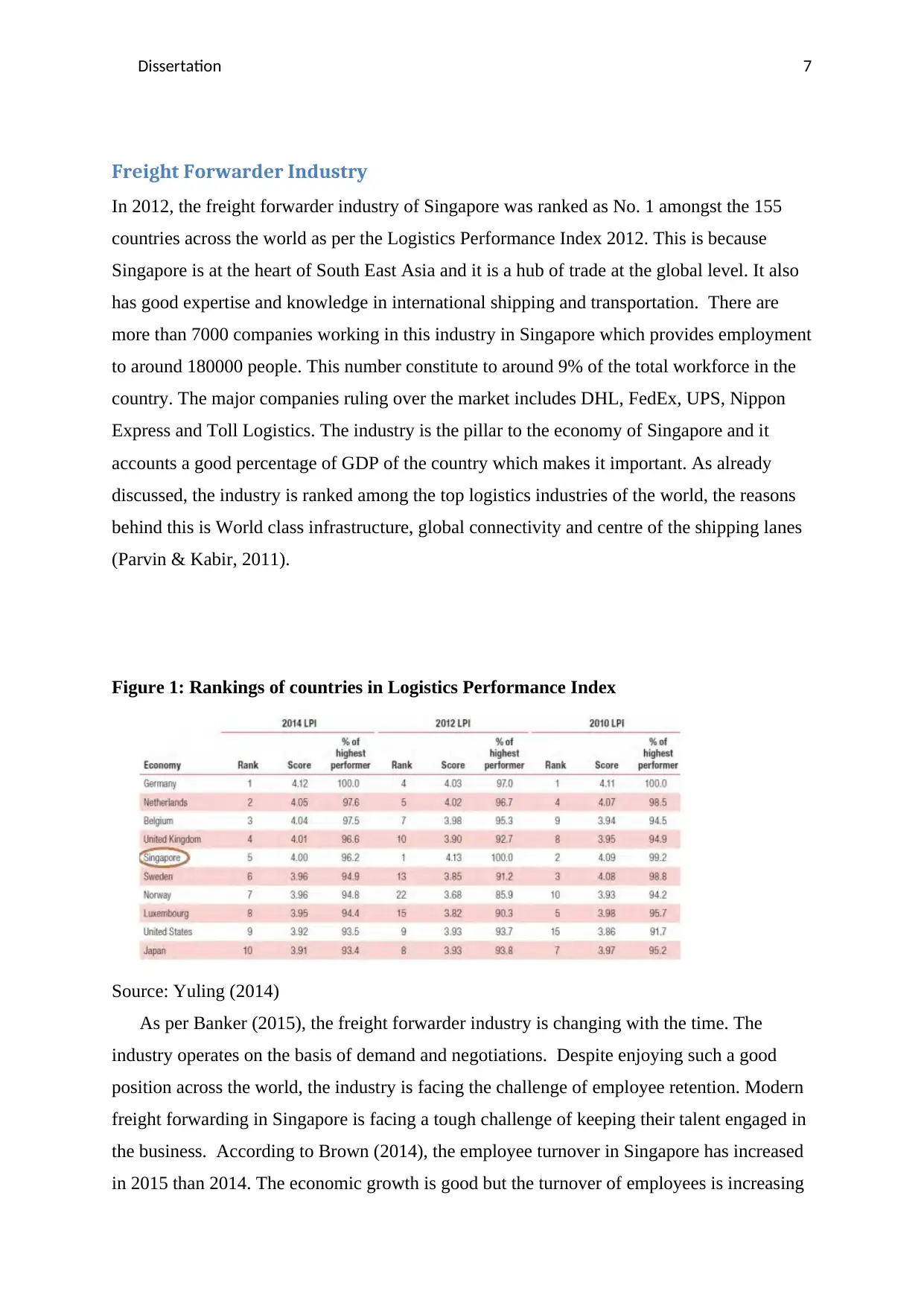
Dissertation 7
Freight Forwarder Industry
In 2012, the freight forwarder industry of Singapore was ranked as No. 1 amongst the 155
countries across the world as per the Logistics Performance Index 2012. This is because
Singapore is at the heart of South East Asia and it is a hub of trade at the global level. It also
has good expertise and knowledge in international shipping and transportation. There are
more than 7000 companies working in this industry in Singapore which provides employment
to around 180000 people. This number constitute to around 9% of the total workforce in the
country. The major companies ruling over the market includes DHL, FedEx, UPS, Nippon
Express and Toll Logistics. The industry is the pillar to the economy of Singapore and it
accounts a good percentage of GDP of the country which makes it important. As already
discussed, the industry is ranked among the top logistics industries of the world, the reasons
behind this is World class infrastructure, global connectivity and centre of the shipping lanes
(Parvin & Kabir, 2011).
Figure 1: Rankings of countries in Logistics Performance Index
Source: Yuling (2014)
As per Banker (2015), the freight forwarder industry is changing with the time. The
industry operates on the basis of demand and negotiations. Despite enjoying such a good
position across the world, the industry is facing the challenge of employee retention. Modern
freight forwarding in Singapore is facing a tough challenge of keeping their talent engaged in
the business. According to Brown (2014), the employee turnover in Singapore has increased
in 2015 than 2014. The economic growth is good but the turnover of employees is increasing
Freight Forwarder Industry
In 2012, the freight forwarder industry of Singapore was ranked as No. 1 amongst the 155
countries across the world as per the Logistics Performance Index 2012. This is because
Singapore is at the heart of South East Asia and it is a hub of trade at the global level. It also
has good expertise and knowledge in international shipping and transportation. There are
more than 7000 companies working in this industry in Singapore which provides employment
to around 180000 people. This number constitute to around 9% of the total workforce in the
country. The major companies ruling over the market includes DHL, FedEx, UPS, Nippon
Express and Toll Logistics. The industry is the pillar to the economy of Singapore and it
accounts a good percentage of GDP of the country which makes it important. As already
discussed, the industry is ranked among the top logistics industries of the world, the reasons
behind this is World class infrastructure, global connectivity and centre of the shipping lanes
(Parvin & Kabir, 2011).
Figure 1: Rankings of countries in Logistics Performance Index
Source: Yuling (2014)
As per Banker (2015), the freight forwarder industry is changing with the time. The
industry operates on the basis of demand and negotiations. Despite enjoying such a good
position across the world, the industry is facing the challenge of employee retention. Modern
freight forwarding in Singapore is facing a tough challenge of keeping their talent engaged in
the business. According to Brown (2014), the employee turnover in Singapore has increased
in 2015 than 2014. The economic growth is good but the turnover of employees is increasing
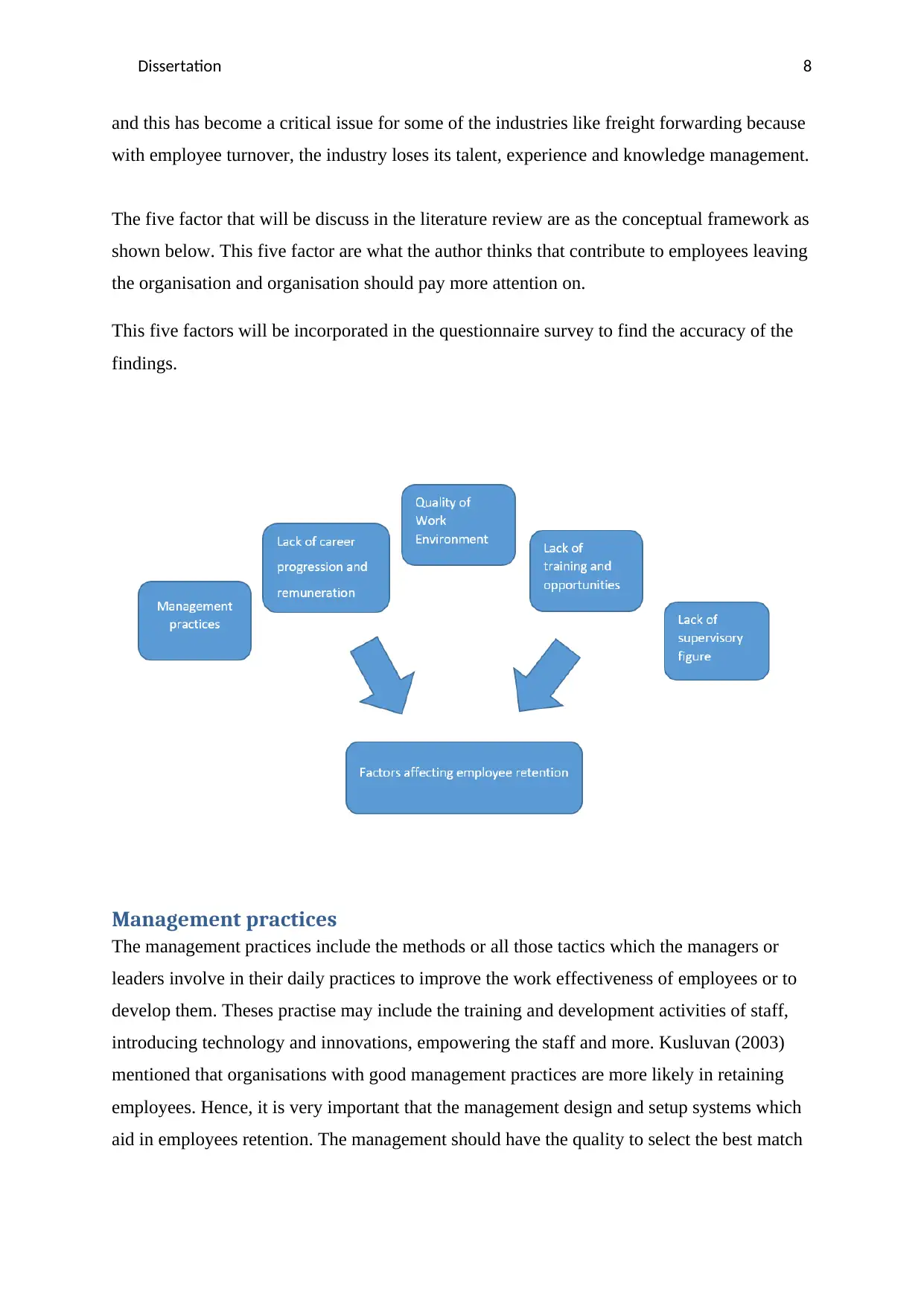
Dissertation 8
and this has become a critical issue for some of the industries like freight forwarding because
with employee turnover, the industry loses its talent, experience and knowledge management.
The five factor that will be discuss in the literature review are as the conceptual framework as
shown below. This five factor are what the author thinks that contribute to employees leaving
the organisation and organisation should pay more attention on.
This five factors will be incorporated in the questionnaire survey to find the accuracy of the
findings.
Management practices
The management practices include the methods or all those tactics which the managers or
leaders involve in their daily practices to improve the work effectiveness of employees or to
develop them. Theses practise may include the training and development activities of staff,
introducing technology and innovations, empowering the staff and more. Kusluvan (2003)
mentioned that organisations with good management practices are more likely in retaining
employees. Hence, it is very important that the management design and setup systems which
aid in employees retention. The management should have the quality to select the best match
and this has become a critical issue for some of the industries like freight forwarding because
with employee turnover, the industry loses its talent, experience and knowledge management.
The five factor that will be discuss in the literature review are as the conceptual framework as
shown below. This five factor are what the author thinks that contribute to employees leaving
the organisation and organisation should pay more attention on.
This five factors will be incorporated in the questionnaire survey to find the accuracy of the
findings.
Management practices
The management practices include the methods or all those tactics which the managers or
leaders involve in their daily practices to improve the work effectiveness of employees or to
develop them. Theses practise may include the training and development activities of staff,
introducing technology and innovations, empowering the staff and more. Kusluvan (2003)
mentioned that organisations with good management practices are more likely in retaining
employees. Hence, it is very important that the management design and setup systems which
aid in employees retention. The management should have the quality to select the best match
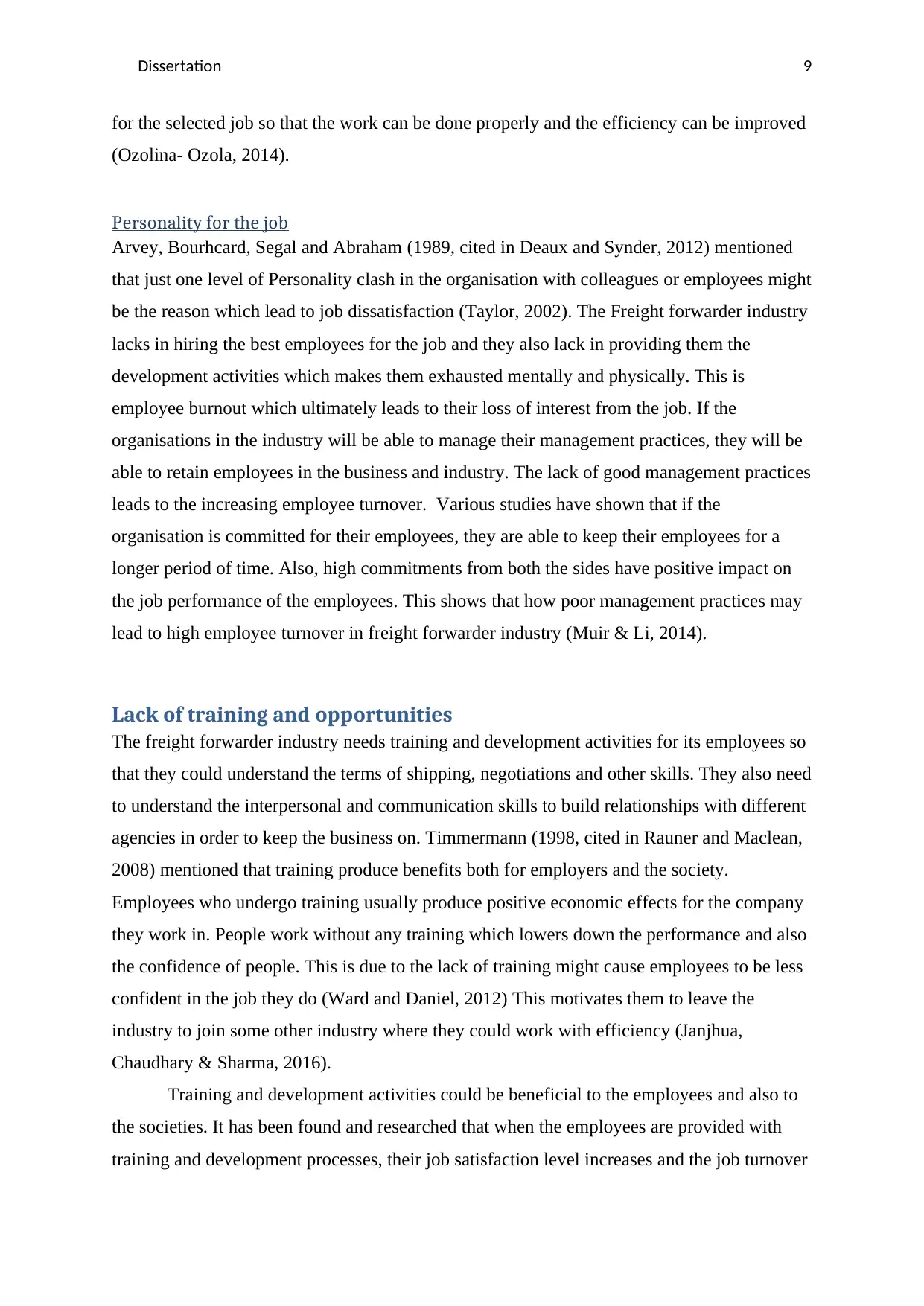
Dissertation 9
for the selected job so that the work can be done properly and the efficiency can be improved
(Ozolina- Ozola, 2014).
Personality for the job
Arvey, Bourhcard, Segal and Abraham (1989, cited in Deaux and Synder, 2012) mentioned
that just one level of Personality clash in the organisation with colleagues or employees might
be the reason which lead to job dissatisfaction (Taylor, 2002). The Freight forwarder industry
lacks in hiring the best employees for the job and they also lack in providing them the
development activities which makes them exhausted mentally and physically. This is
employee burnout which ultimately leads to their loss of interest from the job. If the
organisations in the industry will be able to manage their management practices, they will be
able to retain employees in the business and industry. The lack of good management practices
leads to the increasing employee turnover. Various studies have shown that if the
organisation is committed for their employees, they are able to keep their employees for a
longer period of time. Also, high commitments from both the sides have positive impact on
the job performance of the employees. This shows that how poor management practices may
lead to high employee turnover in freight forwarder industry (Muir & Li, 2014).
Lack of training and opportunities
The freight forwarder industry needs training and development activities for its employees so
that they could understand the terms of shipping, negotiations and other skills. They also need
to understand the interpersonal and communication skills to build relationships with different
agencies in order to keep the business on. Timmermann (1998, cited in Rauner and Maclean,
2008) mentioned that training produce benefits both for employers and the society.
Employees who undergo training usually produce positive economic effects for the company
they work in. People work without any training which lowers down the performance and also
the confidence of people. This is due to the lack of training might cause employees to be less
confident in the job they do (Ward and Daniel, 2012) This motivates them to leave the
industry to join some other industry where they could work with efficiency (Janjhua,
Chaudhary & Sharma, 2016).
Training and development activities could be beneficial to the employees and also to
the societies. It has been found and researched that when the employees are provided with
training and development processes, their job satisfaction level increases and the job turnover
for the selected job so that the work can be done properly and the efficiency can be improved
(Ozolina- Ozola, 2014).
Personality for the job
Arvey, Bourhcard, Segal and Abraham (1989, cited in Deaux and Synder, 2012) mentioned
that just one level of Personality clash in the organisation with colleagues or employees might
be the reason which lead to job dissatisfaction (Taylor, 2002). The Freight forwarder industry
lacks in hiring the best employees for the job and they also lack in providing them the
development activities which makes them exhausted mentally and physically. This is
employee burnout which ultimately leads to their loss of interest from the job. If the
organisations in the industry will be able to manage their management practices, they will be
able to retain employees in the business and industry. The lack of good management practices
leads to the increasing employee turnover. Various studies have shown that if the
organisation is committed for their employees, they are able to keep their employees for a
longer period of time. Also, high commitments from both the sides have positive impact on
the job performance of the employees. This shows that how poor management practices may
lead to high employee turnover in freight forwarder industry (Muir & Li, 2014).
Lack of training and opportunities
The freight forwarder industry needs training and development activities for its employees so
that they could understand the terms of shipping, negotiations and other skills. They also need
to understand the interpersonal and communication skills to build relationships with different
agencies in order to keep the business on. Timmermann (1998, cited in Rauner and Maclean,
2008) mentioned that training produce benefits both for employers and the society.
Employees who undergo training usually produce positive economic effects for the company
they work in. People work without any training which lowers down the performance and also
the confidence of people. This is due to the lack of training might cause employees to be less
confident in the job they do (Ward and Daniel, 2012) This motivates them to leave the
industry to join some other industry where they could work with efficiency (Janjhua,
Chaudhary & Sharma, 2016).
Training and development activities could be beneficial to the employees and also to
the societies. It has been found and researched that when the employees are provided with
training and development processes, their job satisfaction level increases and the job turnover
Secure Best Marks with AI Grader
Need help grading? Try our AI Grader for instant feedback on your assignments.
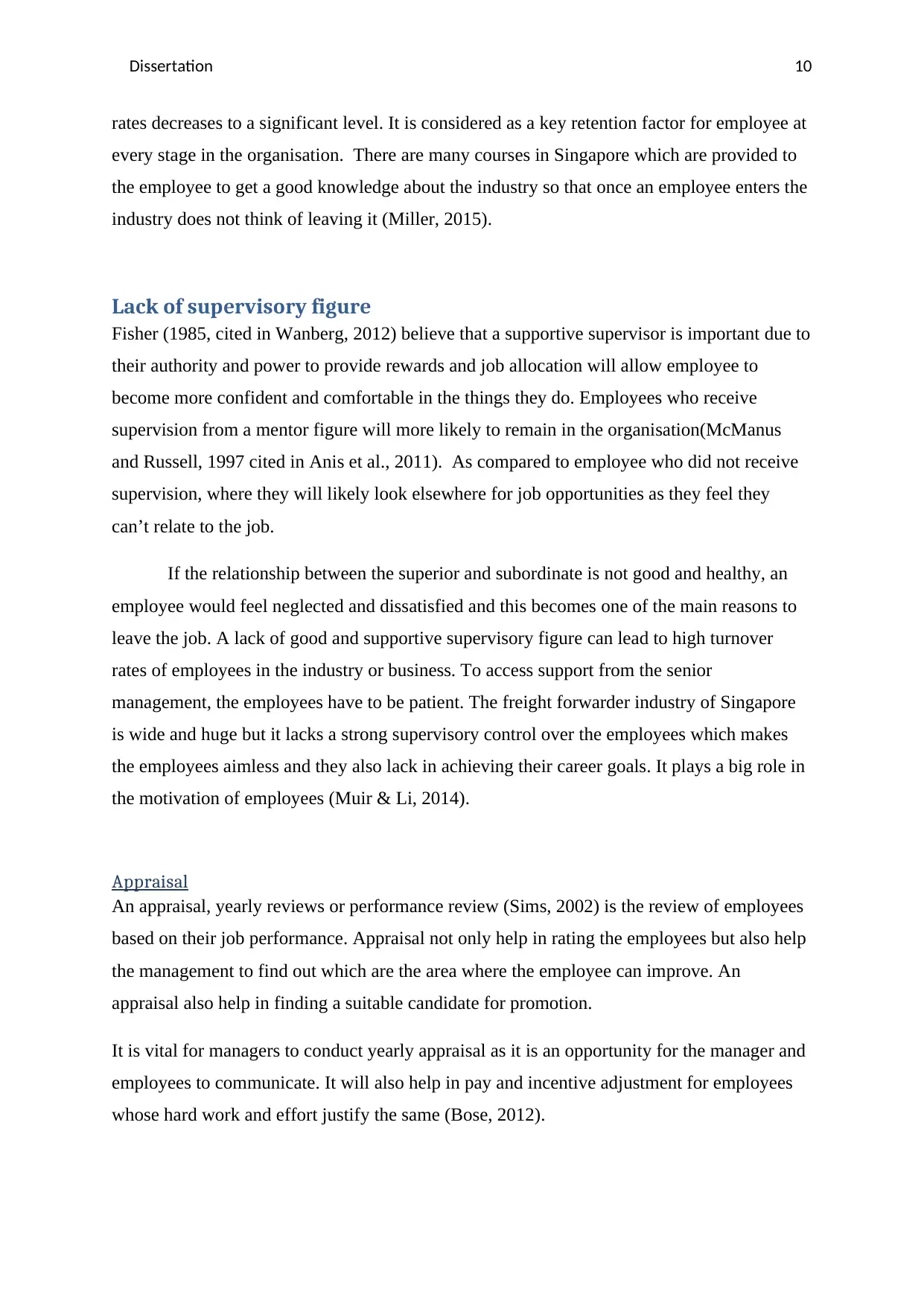
Dissertation 10
rates decreases to a significant level. It is considered as a key retention factor for employee at
every stage in the organisation. There are many courses in Singapore which are provided to
the employee to get a good knowledge about the industry so that once an employee enters the
industry does not think of leaving it (Miller, 2015).
Lack of supervisory figure
Fisher (1985, cited in Wanberg, 2012) believe that a supportive supervisor is important due to
their authority and power to provide rewards and job allocation will allow employee to
become more confident and comfortable in the things they do. Employees who receive
supervision from a mentor figure will more likely to remain in the organisation(McManus
and Russell, 1997 cited in Anis et al., 2011). As compared to employee who did not receive
supervision, where they will likely look elsewhere for job opportunities as they feel they
can’t relate to the job.
If the relationship between the superior and subordinate is not good and healthy, an
employee would feel neglected and dissatisfied and this becomes one of the main reasons to
leave the job. A lack of good and supportive supervisory figure can lead to high turnover
rates of employees in the industry or business. To access support from the senior
management, the employees have to be patient. The freight forwarder industry of Singapore
is wide and huge but it lacks a strong supervisory control over the employees which makes
the employees aimless and they also lack in achieving their career goals. It plays a big role in
the motivation of employees (Muir & Li, 2014).
Appraisal
An appraisal, yearly reviews or performance review (Sims, 2002) is the review of employees
based on their job performance. Appraisal not only help in rating the employees but also help
the management to find out which are the area where the employee can improve. An
appraisal also help in finding a suitable candidate for promotion.
It is vital for managers to conduct yearly appraisal as it is an opportunity for the manager and
employees to communicate. It will also help in pay and incentive adjustment for employees
whose hard work and effort justify the same (Bose, 2012).
rates decreases to a significant level. It is considered as a key retention factor for employee at
every stage in the organisation. There are many courses in Singapore which are provided to
the employee to get a good knowledge about the industry so that once an employee enters the
industry does not think of leaving it (Miller, 2015).
Lack of supervisory figure
Fisher (1985, cited in Wanberg, 2012) believe that a supportive supervisor is important due to
their authority and power to provide rewards and job allocation will allow employee to
become more confident and comfortable in the things they do. Employees who receive
supervision from a mentor figure will more likely to remain in the organisation(McManus
and Russell, 1997 cited in Anis et al., 2011). As compared to employee who did not receive
supervision, where they will likely look elsewhere for job opportunities as they feel they
can’t relate to the job.
If the relationship between the superior and subordinate is not good and healthy, an
employee would feel neglected and dissatisfied and this becomes one of the main reasons to
leave the job. A lack of good and supportive supervisory figure can lead to high turnover
rates of employees in the industry or business. To access support from the senior
management, the employees have to be patient. The freight forwarder industry of Singapore
is wide and huge but it lacks a strong supervisory control over the employees which makes
the employees aimless and they also lack in achieving their career goals. It plays a big role in
the motivation of employees (Muir & Li, 2014).
Appraisal
An appraisal, yearly reviews or performance review (Sims, 2002) is the review of employees
based on their job performance. Appraisal not only help in rating the employees but also help
the management to find out which are the area where the employee can improve. An
appraisal also help in finding a suitable candidate for promotion.
It is vital for managers to conduct yearly appraisal as it is an opportunity for the manager and
employees to communicate. It will also help in pay and incentive adjustment for employees
whose hard work and effort justify the same (Bose, 2012).
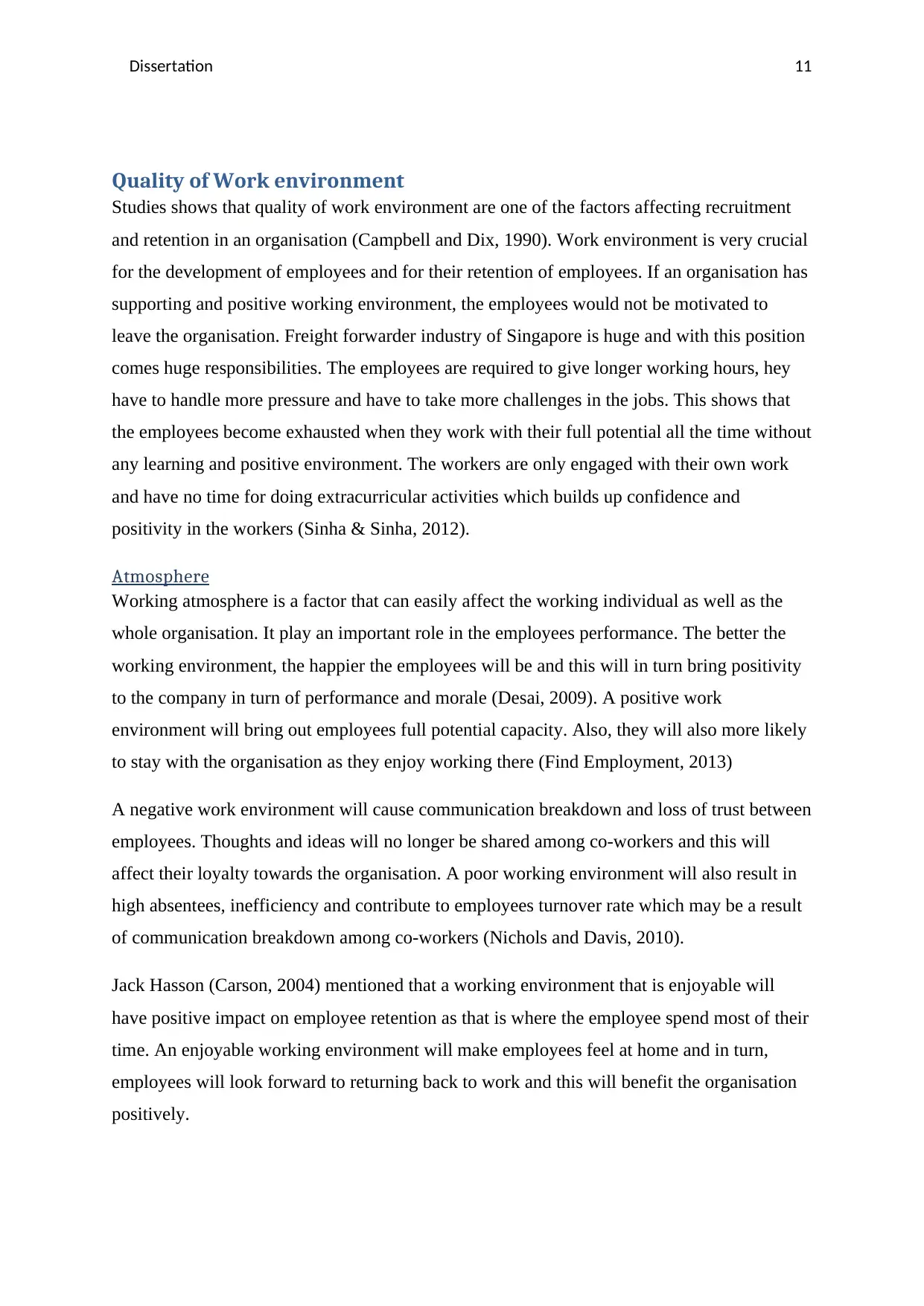
Dissertation 11
Quality of Work environment
Studies shows that quality of work environment are one of the factors affecting recruitment
and retention in an organisation (Campbell and Dix, 1990). Work environment is very crucial
for the development of employees and for their retention of employees. If an organisation has
supporting and positive working environment, the employees would not be motivated to
leave the organisation. Freight forwarder industry of Singapore is huge and with this position
comes huge responsibilities. The employees are required to give longer working hours, hey
have to handle more pressure and have to take more challenges in the jobs. This shows that
the employees become exhausted when they work with their full potential all the time without
any learning and positive environment. The workers are only engaged with their own work
and have no time for doing extracurricular activities which builds up confidence and
positivity in the workers (Sinha & Sinha, 2012).
Atmosphere
Working atmosphere is a factor that can easily affect the working individual as well as the
whole organisation. It play an important role in the employees performance. The better the
working environment, the happier the employees will be and this will in turn bring positivity
to the company in turn of performance and morale (Desai, 2009). A positive work
environment will bring out employees full potential capacity. Also, they will also more likely
to stay with the organisation as they enjoy working there (Find Employment, 2013)
A negative work environment will cause communication breakdown and loss of trust between
employees. Thoughts and ideas will no longer be shared among co-workers and this will
affect their loyalty towards the organisation. A poor working environment will also result in
high absentees, inefficiency and contribute to employees turnover rate which may be a result
of communication breakdown among co-workers (Nichols and Davis, 2010).
Jack Hasson (Carson, 2004) mentioned that a working environment that is enjoyable will
have positive impact on employee retention as that is where the employee spend most of their
time. An enjoyable working environment will make employees feel at home and in turn,
employees will look forward to returning back to work and this will benefit the organisation
positively.
Quality of Work environment
Studies shows that quality of work environment are one of the factors affecting recruitment
and retention in an organisation (Campbell and Dix, 1990). Work environment is very crucial
for the development of employees and for their retention of employees. If an organisation has
supporting and positive working environment, the employees would not be motivated to
leave the organisation. Freight forwarder industry of Singapore is huge and with this position
comes huge responsibilities. The employees are required to give longer working hours, hey
have to handle more pressure and have to take more challenges in the jobs. This shows that
the employees become exhausted when they work with their full potential all the time without
any learning and positive environment. The workers are only engaged with their own work
and have no time for doing extracurricular activities which builds up confidence and
positivity in the workers (Sinha & Sinha, 2012).
Atmosphere
Working atmosphere is a factor that can easily affect the working individual as well as the
whole organisation. It play an important role in the employees performance. The better the
working environment, the happier the employees will be and this will in turn bring positivity
to the company in turn of performance and morale (Desai, 2009). A positive work
environment will bring out employees full potential capacity. Also, they will also more likely
to stay with the organisation as they enjoy working there (Find Employment, 2013)
A negative work environment will cause communication breakdown and loss of trust between
employees. Thoughts and ideas will no longer be shared among co-workers and this will
affect their loyalty towards the organisation. A poor working environment will also result in
high absentees, inefficiency and contribute to employees turnover rate which may be a result
of communication breakdown among co-workers (Nichols and Davis, 2010).
Jack Hasson (Carson, 2004) mentioned that a working environment that is enjoyable will
have positive impact on employee retention as that is where the employee spend most of their
time. An enjoyable working environment will make employees feel at home and in turn,
employees will look forward to returning back to work and this will benefit the organisation
positively.
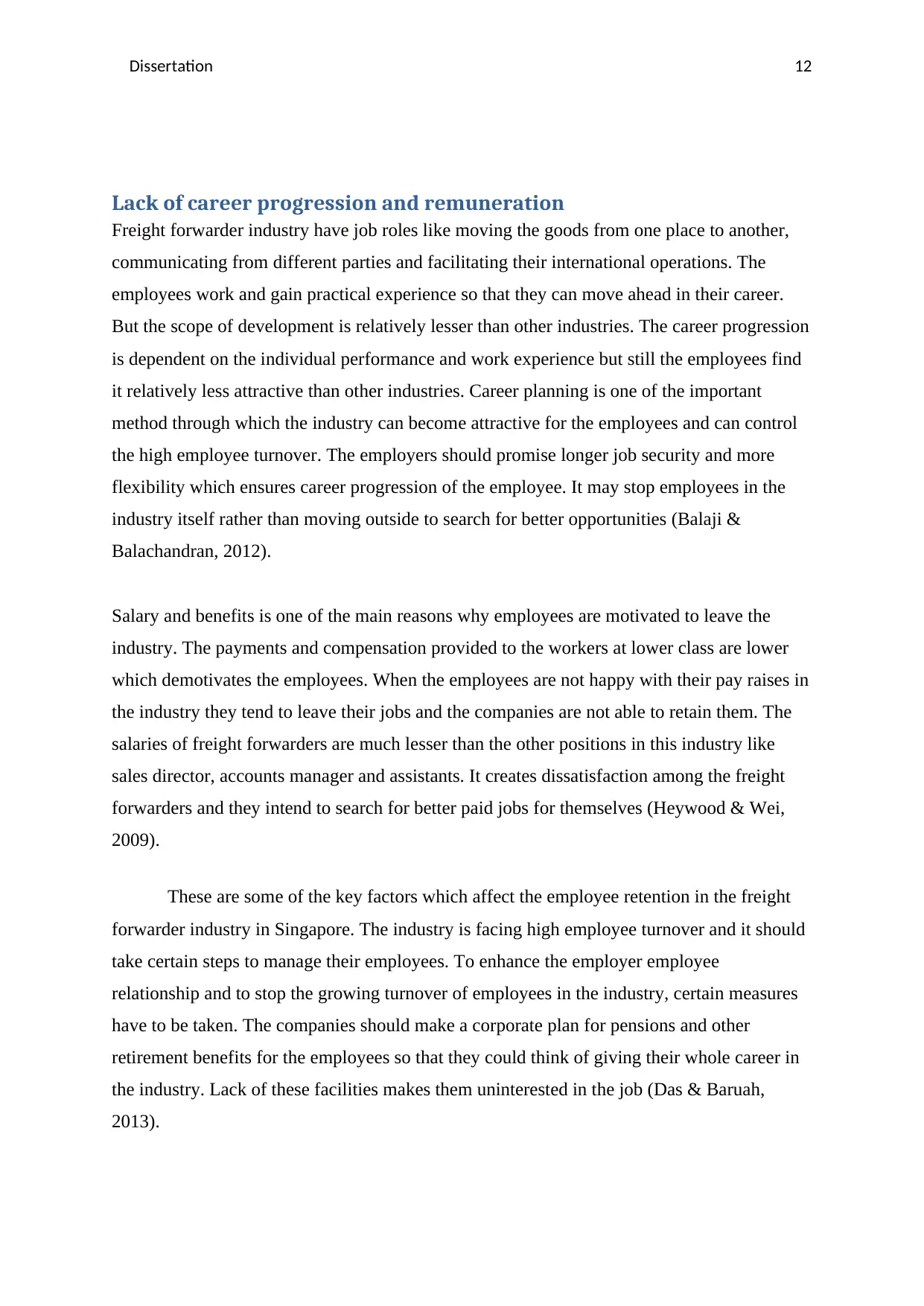
Dissertation 12
Lack of career progression and remuneration
Freight forwarder industry have job roles like moving the goods from one place to another,
communicating from different parties and facilitating their international operations. The
employees work and gain practical experience so that they can move ahead in their career.
But the scope of development is relatively lesser than other industries. The career progression
is dependent on the individual performance and work experience but still the employees find
it relatively less attractive than other industries. Career planning is one of the important
method through which the industry can become attractive for the employees and can control
the high employee turnover. The employers should promise longer job security and more
flexibility which ensures career progression of the employee. It may stop employees in the
industry itself rather than moving outside to search for better opportunities (Balaji &
Balachandran, 2012).
Salary and benefits is one of the main reasons why employees are motivated to leave the
industry. The payments and compensation provided to the workers at lower class are lower
which demotivates the employees. When the employees are not happy with their pay raises in
the industry they tend to leave their jobs and the companies are not able to retain them. The
salaries of freight forwarders are much lesser than the other positions in this industry like
sales director, accounts manager and assistants. It creates dissatisfaction among the freight
forwarders and they intend to search for better paid jobs for themselves (Heywood & Wei,
2009).
These are some of the key factors which affect the employee retention in the freight
forwarder industry in Singapore. The industry is facing high employee turnover and it should
take certain steps to manage their employees. To enhance the employer employee
relationship and to stop the growing turnover of employees in the industry, certain measures
have to be taken. The companies should make a corporate plan for pensions and other
retirement benefits for the employees so that they could think of giving their whole career in
the industry. Lack of these facilities makes them uninterested in the job (Das & Baruah,
2013).
Lack of career progression and remuneration
Freight forwarder industry have job roles like moving the goods from one place to another,
communicating from different parties and facilitating their international operations. The
employees work and gain practical experience so that they can move ahead in their career.
But the scope of development is relatively lesser than other industries. The career progression
is dependent on the individual performance and work experience but still the employees find
it relatively less attractive than other industries. Career planning is one of the important
method through which the industry can become attractive for the employees and can control
the high employee turnover. The employers should promise longer job security and more
flexibility which ensures career progression of the employee. It may stop employees in the
industry itself rather than moving outside to search for better opportunities (Balaji &
Balachandran, 2012).
Salary and benefits is one of the main reasons why employees are motivated to leave the
industry. The payments and compensation provided to the workers at lower class are lower
which demotivates the employees. When the employees are not happy with their pay raises in
the industry they tend to leave their jobs and the companies are not able to retain them. The
salaries of freight forwarders are much lesser than the other positions in this industry like
sales director, accounts manager and assistants. It creates dissatisfaction among the freight
forwarders and they intend to search for better paid jobs for themselves (Heywood & Wei,
2009).
These are some of the key factors which affect the employee retention in the freight
forwarder industry in Singapore. The industry is facing high employee turnover and it should
take certain steps to manage their employees. To enhance the employer employee
relationship and to stop the growing turnover of employees in the industry, certain measures
have to be taken. The companies should make a corporate plan for pensions and other
retirement benefits for the employees so that they could think of giving their whole career in
the industry. Lack of these facilities makes them uninterested in the job (Das & Baruah,
2013).
Paraphrase This Document
Need a fresh take? Get an instant paraphrase of this document with our AI Paraphraser
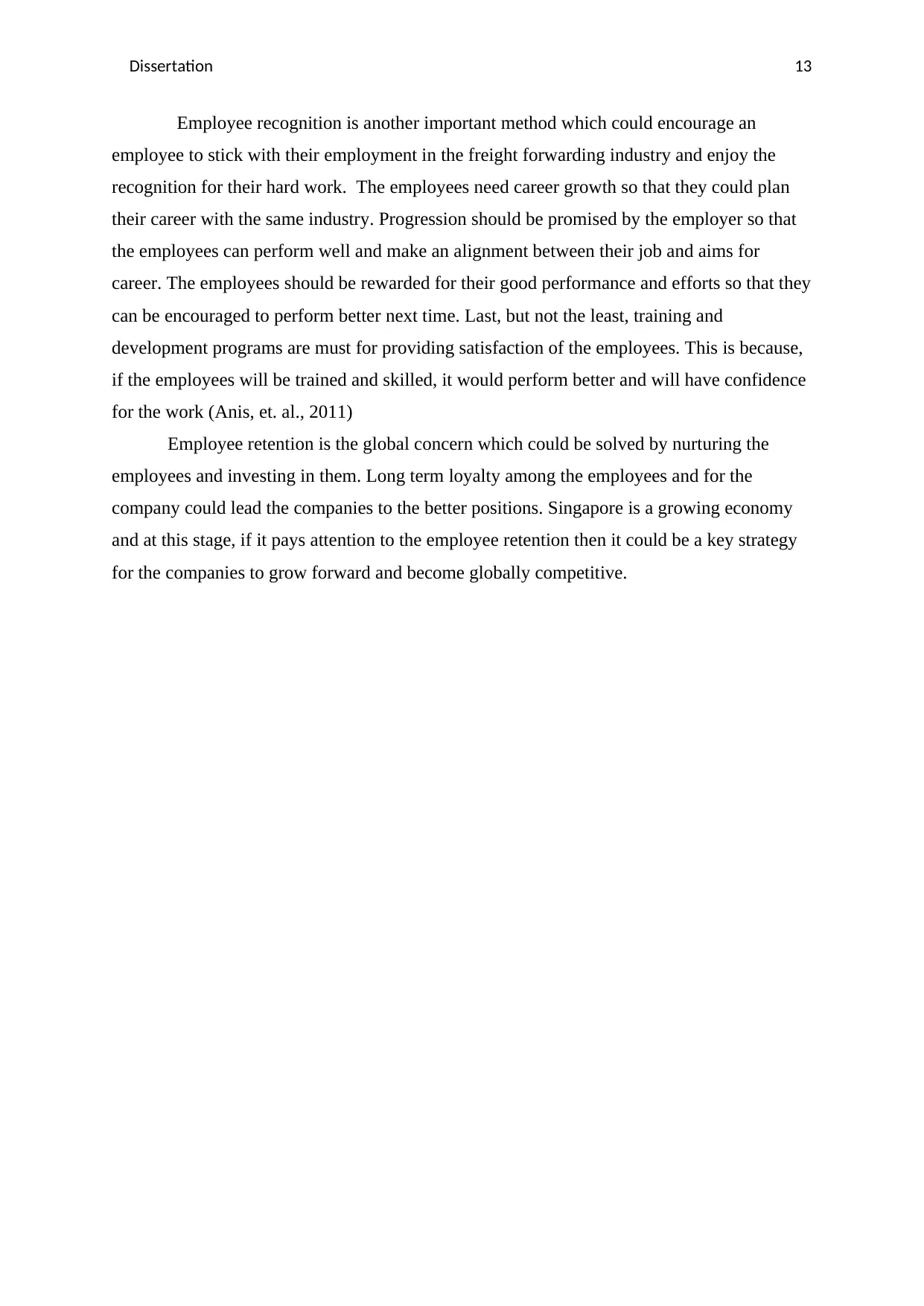
Dissertation 13
Employee recognition is another important method which could encourage an
employee to stick with their employment in the freight forwarding industry and enjoy the
recognition for their hard work. The employees need career growth so that they could plan
their career with the same industry. Progression should be promised by the employer so that
the employees can perform well and make an alignment between their job and aims for
career. The employees should be rewarded for their good performance and efforts so that they
can be encouraged to perform better next time. Last, but not the least, training and
development programs are must for providing satisfaction of the employees. This is because,
if the employees will be trained and skilled, it would perform better and will have confidence
for the work (Anis, et. al., 2011)
Employee retention is the global concern which could be solved by nurturing the
employees and investing in them. Long term loyalty among the employees and for the
company could lead the companies to the better positions. Singapore is a growing economy
and at this stage, if it pays attention to the employee retention then it could be a key strategy
for the companies to grow forward and become globally competitive.
Employee recognition is another important method which could encourage an
employee to stick with their employment in the freight forwarding industry and enjoy the
recognition for their hard work. The employees need career growth so that they could plan
their career with the same industry. Progression should be promised by the employer so that
the employees can perform well and make an alignment between their job and aims for
career. The employees should be rewarded for their good performance and efforts so that they
can be encouraged to perform better next time. Last, but not the least, training and
development programs are must for providing satisfaction of the employees. This is because,
if the employees will be trained and skilled, it would perform better and will have confidence
for the work (Anis, et. al., 2011)
Employee retention is the global concern which could be solved by nurturing the
employees and investing in them. Long term loyalty among the employees and for the
company could lead the companies to the better positions. Singapore is a growing economy
and at this stage, if it pays attention to the employee retention then it could be a key strategy
for the companies to grow forward and become globally competitive.
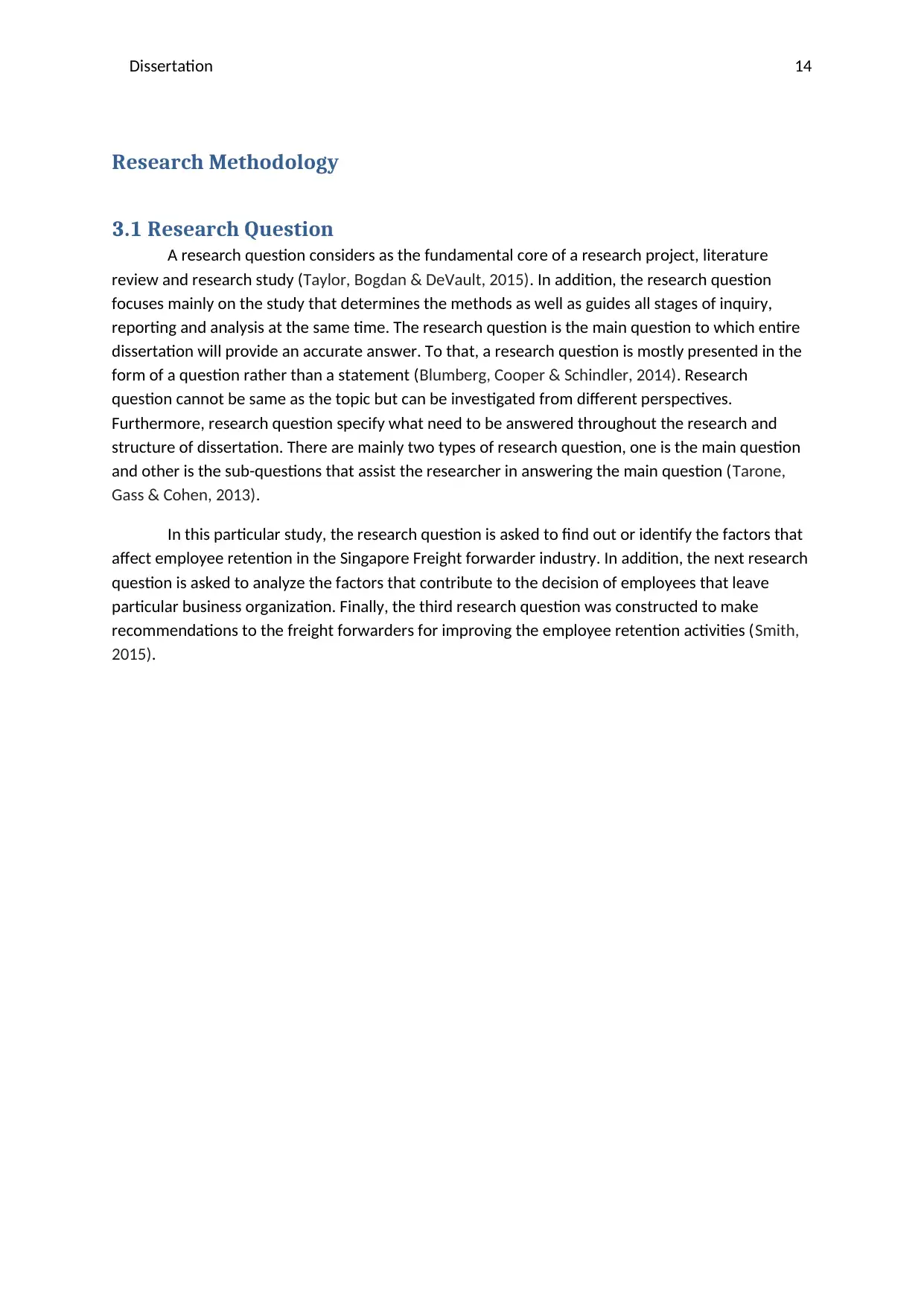
Dissertation 14
Research Methodology
3.1 Research Question
A research question considers as the fundamental core of a research project, literature
review and research study (Taylor, Bogdan & DeVault, 2015). In addition, the research question
focuses mainly on the study that determines the methods as well as guides all stages of inquiry,
reporting and analysis at the same time. The research question is the main question to which entire
dissertation will provide an accurate answer. To that, a research question is mostly presented in the
form of a question rather than a statement (Blumberg, Cooper & Schindler, 2014). Research
question cannot be same as the topic but can be investigated from different perspectives.
Furthermore, research question specify what need to be answered throughout the research and
structure of dissertation. There are mainly two types of research question, one is the main question
and other is the sub-questions that assist the researcher in answering the main question (Tarone,
Gass & Cohen, 2013).
In this particular study, the research question is asked to find out or identify the factors that
affect employee retention in the Singapore Freight forwarder industry. In addition, the next research
question is asked to analyze the factors that contribute to the decision of employees that leave
particular business organization. Finally, the third research question was constructed to make
recommendations to the freight forwarders for improving the employee retention activities (Smith,
2015).
Research Methodology
3.1 Research Question
A research question considers as the fundamental core of a research project, literature
review and research study (Taylor, Bogdan & DeVault, 2015). In addition, the research question
focuses mainly on the study that determines the methods as well as guides all stages of inquiry,
reporting and analysis at the same time. The research question is the main question to which entire
dissertation will provide an accurate answer. To that, a research question is mostly presented in the
form of a question rather than a statement (Blumberg, Cooper & Schindler, 2014). Research
question cannot be same as the topic but can be investigated from different perspectives.
Furthermore, research question specify what need to be answered throughout the research and
structure of dissertation. There are mainly two types of research question, one is the main question
and other is the sub-questions that assist the researcher in answering the main question (Tarone,
Gass & Cohen, 2013).
In this particular study, the research question is asked to find out or identify the factors that
affect employee retention in the Singapore Freight forwarder industry. In addition, the next research
question is asked to analyze the factors that contribute to the decision of employees that leave
particular business organization. Finally, the third research question was constructed to make
recommendations to the freight forwarders for improving the employee retention activities (Smith,
2015).
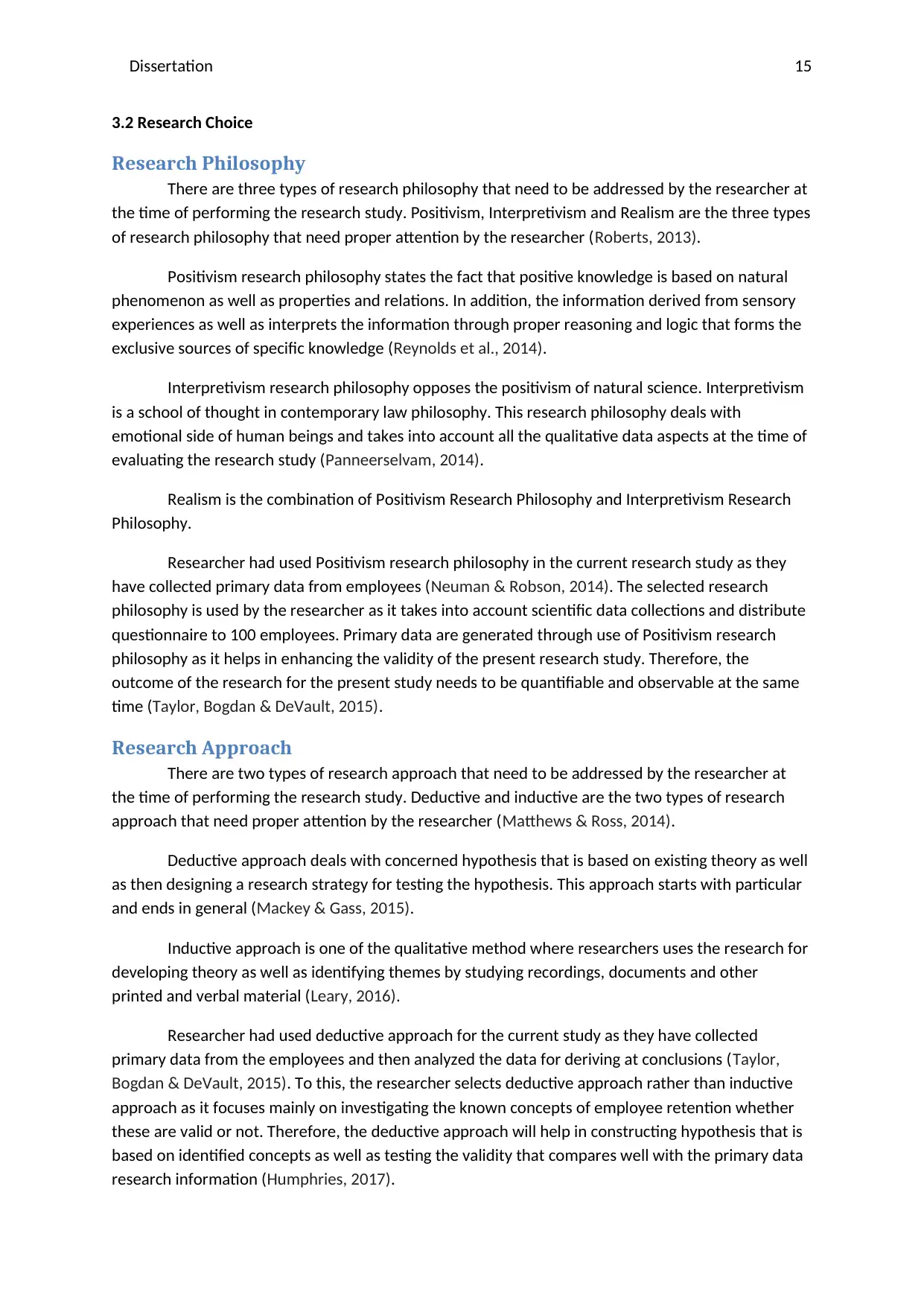
Dissertation 15
3.2 Research Choice
Research Philosophy
There are three types of research philosophy that need to be addressed by the researcher at
the time of performing the research study. Positivism, Interpretivism and Realism are the three types
of research philosophy that need proper attention by the researcher (Roberts, 2013).
Positivism research philosophy states the fact that positive knowledge is based on natural
phenomenon as well as properties and relations. In addition, the information derived from sensory
experiences as well as interprets the information through proper reasoning and logic that forms the
exclusive sources of specific knowledge (Reynolds et al., 2014).
Interpretivism research philosophy opposes the positivism of natural science. Interpretivism
is a school of thought in contemporary law philosophy. This research philosophy deals with
emotional side of human beings and takes into account all the qualitative data aspects at the time of
evaluating the research study (Panneerselvam, 2014).
Realism is the combination of Positivism Research Philosophy and Interpretivism Research
Philosophy.
Researcher had used Positivism research philosophy in the current research study as they
have collected primary data from employees (Neuman & Robson, 2014). The selected research
philosophy is used by the researcher as it takes into account scientific data collections and distribute
questionnaire to 100 employees. Primary data are generated through use of Positivism research
philosophy as it helps in enhancing the validity of the present research study. Therefore, the
outcome of the research for the present study needs to be quantifiable and observable at the same
time (Taylor, Bogdan & DeVault, 2015).
Research Approach
There are two types of research approach that need to be addressed by the researcher at
the time of performing the research study. Deductive and inductive are the two types of research
approach that need proper attention by the researcher (Matthews & Ross, 2014).
Deductive approach deals with concerned hypothesis that is based on existing theory as well
as then designing a research strategy for testing the hypothesis. This approach starts with particular
and ends in general (Mackey & Gass, 2015).
Inductive approach is one of the qualitative method where researchers uses the research for
developing theory as well as identifying themes by studying recordings, documents and other
printed and verbal material (Leary, 2016).
Researcher had used deductive approach for the current study as they have collected
primary data from the employees and then analyzed the data for deriving at conclusions (Taylor,
Bogdan & DeVault, 2015). To this, the researcher selects deductive approach rather than inductive
approach as it focuses mainly on investigating the known concepts of employee retention whether
these are valid or not. Therefore, the deductive approach will help in constructing hypothesis that is
based on identified concepts as well as testing the validity that compares well with the primary data
research information (Humphries, 2017).
3.2 Research Choice
Research Philosophy
There are three types of research philosophy that need to be addressed by the researcher at
the time of performing the research study. Positivism, Interpretivism and Realism are the three types
of research philosophy that need proper attention by the researcher (Roberts, 2013).
Positivism research philosophy states the fact that positive knowledge is based on natural
phenomenon as well as properties and relations. In addition, the information derived from sensory
experiences as well as interprets the information through proper reasoning and logic that forms the
exclusive sources of specific knowledge (Reynolds et al., 2014).
Interpretivism research philosophy opposes the positivism of natural science. Interpretivism
is a school of thought in contemporary law philosophy. This research philosophy deals with
emotional side of human beings and takes into account all the qualitative data aspects at the time of
evaluating the research study (Panneerselvam, 2014).
Realism is the combination of Positivism Research Philosophy and Interpretivism Research
Philosophy.
Researcher had used Positivism research philosophy in the current research study as they
have collected primary data from employees (Neuman & Robson, 2014). The selected research
philosophy is used by the researcher as it takes into account scientific data collections and distribute
questionnaire to 100 employees. Primary data are generated through use of Positivism research
philosophy as it helps in enhancing the validity of the present research study. Therefore, the
outcome of the research for the present study needs to be quantifiable and observable at the same
time (Taylor, Bogdan & DeVault, 2015).
Research Approach
There are two types of research approach that need to be addressed by the researcher at
the time of performing the research study. Deductive and inductive are the two types of research
approach that need proper attention by the researcher (Matthews & Ross, 2014).
Deductive approach deals with concerned hypothesis that is based on existing theory as well
as then designing a research strategy for testing the hypothesis. This approach starts with particular
and ends in general (Mackey & Gass, 2015).
Inductive approach is one of the qualitative method where researchers uses the research for
developing theory as well as identifying themes by studying recordings, documents and other
printed and verbal material (Leary, 2016).
Researcher had used deductive approach for the current study as they have collected
primary data from the employees and then analyzed the data for deriving at conclusions (Taylor,
Bogdan & DeVault, 2015). To this, the researcher selects deductive approach rather than inductive
approach as it focuses mainly on investigating the known concepts of employee retention whether
these are valid or not. Therefore, the deductive approach will help in constructing hypothesis that is
based on identified concepts as well as testing the validity that compares well with the primary data
research information (Humphries, 2017).
Secure Best Marks with AI Grader
Need help grading? Try our AI Grader for instant feedback on your assignments.
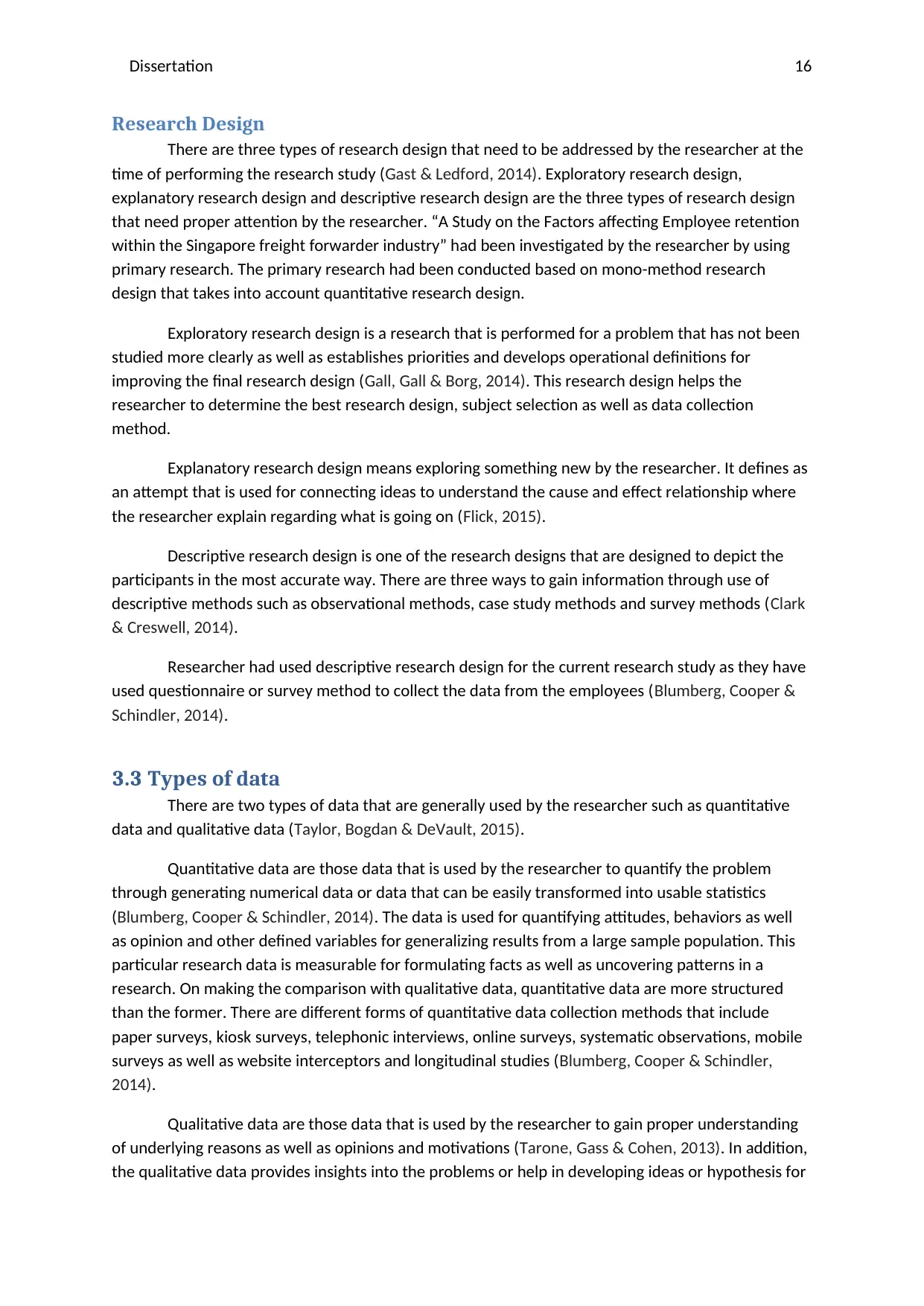
Dissertation 16
Research Design
There are three types of research design that need to be addressed by the researcher at the
time of performing the research study (Gast & Ledford, 2014). Exploratory research design,
explanatory research design and descriptive research design are the three types of research design
that need proper attention by the researcher. “A Study on the Factors affecting Employee retention
within the Singapore freight forwarder industry” had been investigated by the researcher by using
primary research. The primary research had been conducted based on mono-method research
design that takes into account quantitative research design.
Exploratory research design is a research that is performed for a problem that has not been
studied more clearly as well as establishes priorities and develops operational definitions for
improving the final research design (Gall, Gall & Borg, 2014). This research design helps the
researcher to determine the best research design, subject selection as well as data collection
method.
Explanatory research design means exploring something new by the researcher. It defines as
an attempt that is used for connecting ideas to understand the cause and effect relationship where
the researcher explain regarding what is going on (Flick, 2015).
Descriptive research design is one of the research designs that are designed to depict the
participants in the most accurate way. There are three ways to gain information through use of
descriptive methods such as observational methods, case study methods and survey methods (Clark
& Creswell, 2014).
Researcher had used descriptive research design for the current research study as they have
used questionnaire or survey method to collect the data from the employees (Blumberg, Cooper &
Schindler, 2014).
3.3 Types of data
There are two types of data that are generally used by the researcher such as quantitative
data and qualitative data (Taylor, Bogdan & DeVault, 2015).
Quantitative data are those data that is used by the researcher to quantify the problem
through generating numerical data or data that can be easily transformed into usable statistics
(Blumberg, Cooper & Schindler, 2014). The data is used for quantifying attitudes, behaviors as well
as opinion and other defined variables for generalizing results from a large sample population. This
particular research data is measurable for formulating facts as well as uncovering patterns in a
research. On making the comparison with qualitative data, quantitative data are more structured
than the former. There are different forms of quantitative data collection methods that include
paper surveys, kiosk surveys, telephonic interviews, online surveys, systematic observations, mobile
surveys as well as website interceptors and longitudinal studies (Blumberg, Cooper & Schindler,
2014).
Qualitative data are those data that is used by the researcher to gain proper understanding
of underlying reasons as well as opinions and motivations (Tarone, Gass & Cohen, 2013). In addition,
the qualitative data provides insights into the problems or help in developing ideas or hypothesis for
Research Design
There are three types of research design that need to be addressed by the researcher at the
time of performing the research study (Gast & Ledford, 2014). Exploratory research design,
explanatory research design and descriptive research design are the three types of research design
that need proper attention by the researcher. “A Study on the Factors affecting Employee retention
within the Singapore freight forwarder industry” had been investigated by the researcher by using
primary research. The primary research had been conducted based on mono-method research
design that takes into account quantitative research design.
Exploratory research design is a research that is performed for a problem that has not been
studied more clearly as well as establishes priorities and develops operational definitions for
improving the final research design (Gall, Gall & Borg, 2014). This research design helps the
researcher to determine the best research design, subject selection as well as data collection
method.
Explanatory research design means exploring something new by the researcher. It defines as
an attempt that is used for connecting ideas to understand the cause and effect relationship where
the researcher explain regarding what is going on (Flick, 2015).
Descriptive research design is one of the research designs that are designed to depict the
participants in the most accurate way. There are three ways to gain information through use of
descriptive methods such as observational methods, case study methods and survey methods (Clark
& Creswell, 2014).
Researcher had used descriptive research design for the current research study as they have
used questionnaire or survey method to collect the data from the employees (Blumberg, Cooper &
Schindler, 2014).
3.3 Types of data
There are two types of data that are generally used by the researcher such as quantitative
data and qualitative data (Taylor, Bogdan & DeVault, 2015).
Quantitative data are those data that is used by the researcher to quantify the problem
through generating numerical data or data that can be easily transformed into usable statistics
(Blumberg, Cooper & Schindler, 2014). The data is used for quantifying attitudes, behaviors as well
as opinion and other defined variables for generalizing results from a large sample population. This
particular research data is measurable for formulating facts as well as uncovering patterns in a
research. On making the comparison with qualitative data, quantitative data are more structured
than the former. There are different forms of quantitative data collection methods that include
paper surveys, kiosk surveys, telephonic interviews, online surveys, systematic observations, mobile
surveys as well as website interceptors and longitudinal studies (Blumberg, Cooper & Schindler,
2014).
Qualitative data are those data that is used by the researcher to gain proper understanding
of underlying reasons as well as opinions and motivations (Tarone, Gass & Cohen, 2013). In addition,
the qualitative data provides insights into the problems or help in developing ideas or hypothesis for
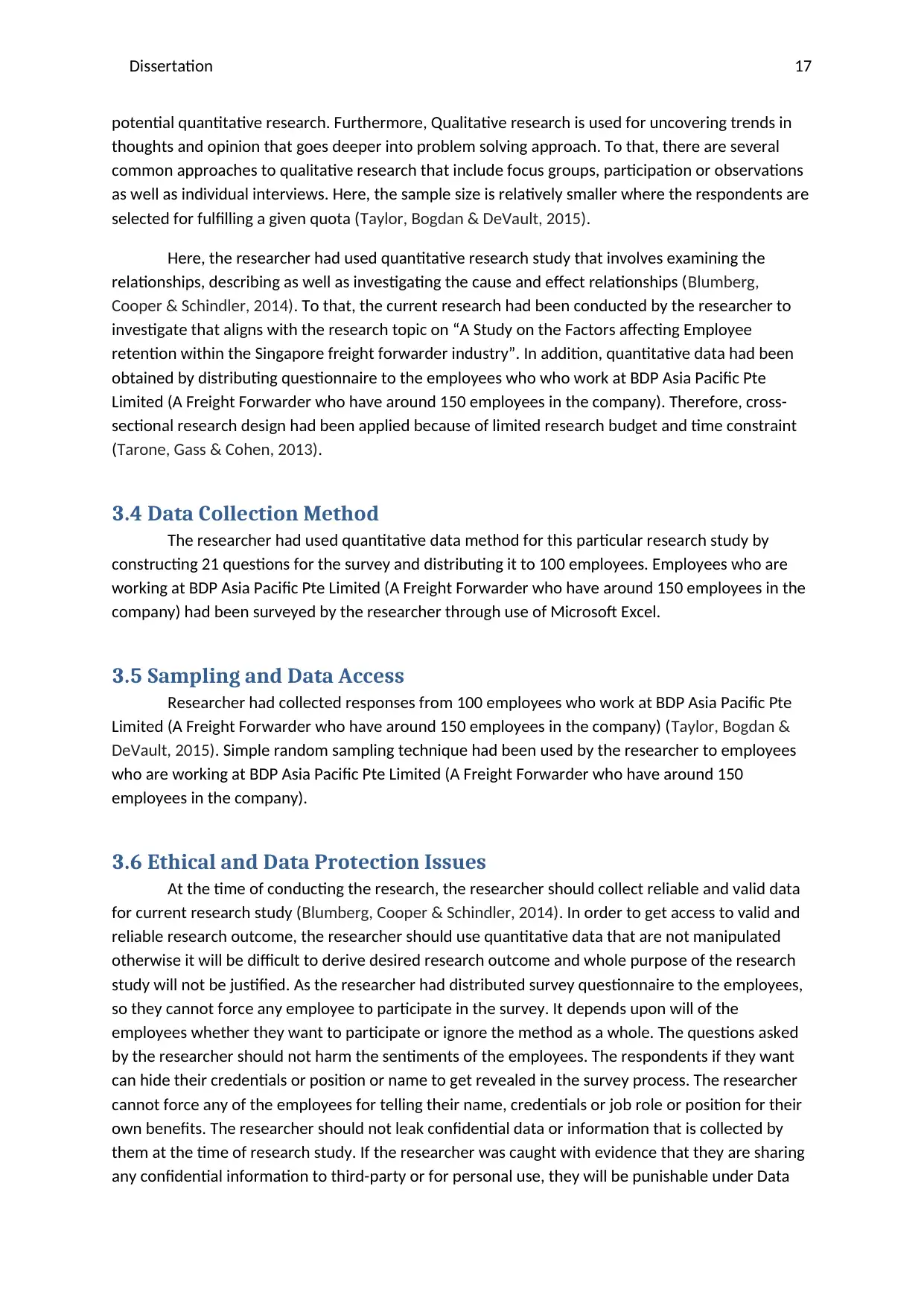
Dissertation 17
potential quantitative research. Furthermore, Qualitative research is used for uncovering trends in
thoughts and opinion that goes deeper into problem solving approach. To that, there are several
common approaches to qualitative research that include focus groups, participation or observations
as well as individual interviews. Here, the sample size is relatively smaller where the respondents are
selected for fulfilling a given quota (Taylor, Bogdan & DeVault, 2015).
Here, the researcher had used quantitative research study that involves examining the
relationships, describing as well as investigating the cause and effect relationships (Blumberg,
Cooper & Schindler, 2014). To that, the current research had been conducted by the researcher to
investigate that aligns with the research topic on “A Study on the Factors affecting Employee
retention within the Singapore freight forwarder industry”. In addition, quantitative data had been
obtained by distributing questionnaire to the employees who who work at BDP Asia Pacific Pte
Limited (A Freight Forwarder who have around 150 employees in the company). Therefore, cross-
sectional research design had been applied because of limited research budget and time constraint
(Tarone, Gass & Cohen, 2013).
3.4 Data Collection Method
The researcher had used quantitative data method for this particular research study by
constructing 21 questions for the survey and distributing it to 100 employees. Employees who are
working at BDP Asia Pacific Pte Limited (A Freight Forwarder who have around 150 employees in the
company) had been surveyed by the researcher through use of Microsoft Excel.
3.5 Sampling and Data Access
Researcher had collected responses from 100 employees who work at BDP Asia Pacific Pte
Limited (A Freight Forwarder who have around 150 employees in the company) (Taylor, Bogdan &
DeVault, 2015). Simple random sampling technique had been used by the researcher to employees
who are working at BDP Asia Pacific Pte Limited (A Freight Forwarder who have around 150
employees in the company).
3.6 Ethical and Data Protection Issues
At the time of conducting the research, the researcher should collect reliable and valid data
for current research study (Blumberg, Cooper & Schindler, 2014). In order to get access to valid and
reliable research outcome, the researcher should use quantitative data that are not manipulated
otherwise it will be difficult to derive desired research outcome and whole purpose of the research
study will not be justified. As the researcher had distributed survey questionnaire to the employees,
so they cannot force any employee to participate in the survey. It depends upon will of the
employees whether they want to participate or ignore the method as a whole. The questions asked
by the researcher should not harm the sentiments of the employees. The respondents if they want
can hide their credentials or position or name to get revealed in the survey process. The researcher
cannot force any of the employees for telling their name, credentials or job role or position for their
own benefits. The researcher should not leak confidential data or information that is collected by
them at the time of research study. If the researcher was caught with evidence that they are sharing
any confidential information to third-party or for personal use, they will be punishable under Data
potential quantitative research. Furthermore, Qualitative research is used for uncovering trends in
thoughts and opinion that goes deeper into problem solving approach. To that, there are several
common approaches to qualitative research that include focus groups, participation or observations
as well as individual interviews. Here, the sample size is relatively smaller where the respondents are
selected for fulfilling a given quota (Taylor, Bogdan & DeVault, 2015).
Here, the researcher had used quantitative research study that involves examining the
relationships, describing as well as investigating the cause and effect relationships (Blumberg,
Cooper & Schindler, 2014). To that, the current research had been conducted by the researcher to
investigate that aligns with the research topic on “A Study on the Factors affecting Employee
retention within the Singapore freight forwarder industry”. In addition, quantitative data had been
obtained by distributing questionnaire to the employees who who work at BDP Asia Pacific Pte
Limited (A Freight Forwarder who have around 150 employees in the company). Therefore, cross-
sectional research design had been applied because of limited research budget and time constraint
(Tarone, Gass & Cohen, 2013).
3.4 Data Collection Method
The researcher had used quantitative data method for this particular research study by
constructing 21 questions for the survey and distributing it to 100 employees. Employees who are
working at BDP Asia Pacific Pte Limited (A Freight Forwarder who have around 150 employees in the
company) had been surveyed by the researcher through use of Microsoft Excel.
3.5 Sampling and Data Access
Researcher had collected responses from 100 employees who work at BDP Asia Pacific Pte
Limited (A Freight Forwarder who have around 150 employees in the company) (Taylor, Bogdan &
DeVault, 2015). Simple random sampling technique had been used by the researcher to employees
who are working at BDP Asia Pacific Pte Limited (A Freight Forwarder who have around 150
employees in the company).
3.6 Ethical and Data Protection Issues
At the time of conducting the research, the researcher should collect reliable and valid data
for current research study (Blumberg, Cooper & Schindler, 2014). In order to get access to valid and
reliable research outcome, the researcher should use quantitative data that are not manipulated
otherwise it will be difficult to derive desired research outcome and whole purpose of the research
study will not be justified. As the researcher had distributed survey questionnaire to the employees,
so they cannot force any employee to participate in the survey. It depends upon will of the
employees whether they want to participate or ignore the method as a whole. The questions asked
by the researcher should not harm the sentiments of the employees. The respondents if they want
can hide their credentials or position or name to get revealed in the survey process. The researcher
cannot force any of the employees for telling their name, credentials or job role or position for their
own benefits. The researcher should not leak confidential data or information that is collected by
them at the time of research study. If the researcher was caught with evidence that they are sharing
any confidential information to third-party or for personal use, they will be punishable under Data
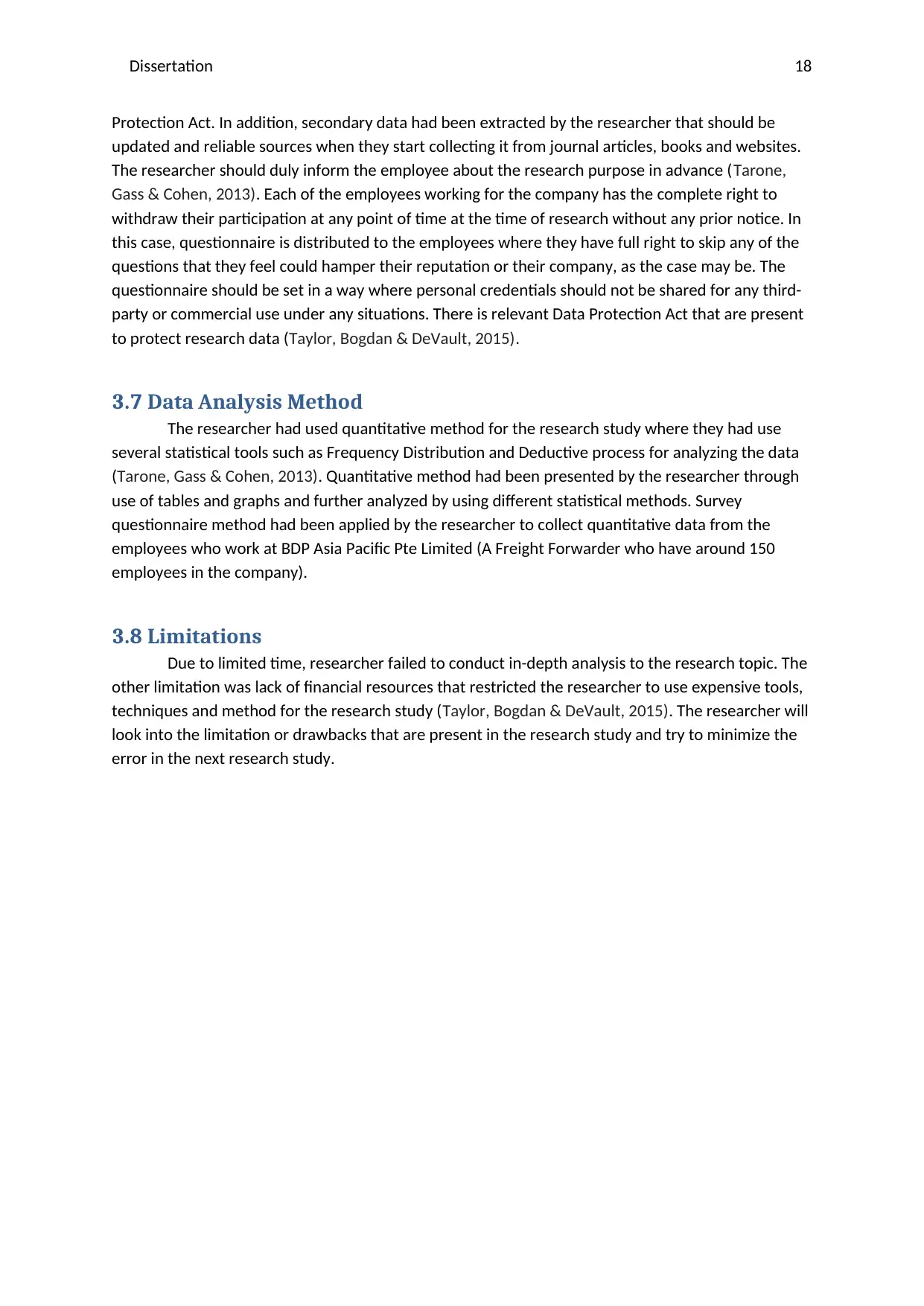
Dissertation 18
Protection Act. In addition, secondary data had been extracted by the researcher that should be
updated and reliable sources when they start collecting it from journal articles, books and websites.
The researcher should duly inform the employee about the research purpose in advance (Tarone,
Gass & Cohen, 2013). Each of the employees working for the company has the complete right to
withdraw their participation at any point of time at the time of research without any prior notice. In
this case, questionnaire is distributed to the employees where they have full right to skip any of the
questions that they feel could hamper their reputation or their company, as the case may be. The
questionnaire should be set in a way where personal credentials should not be shared for any third-
party or commercial use under any situations. There is relevant Data Protection Act that are present
to protect research data (Taylor, Bogdan & DeVault, 2015).
3.7 Data Analysis Method
The researcher had used quantitative method for the research study where they had use
several statistical tools such as Frequency Distribution and Deductive process for analyzing the data
(Tarone, Gass & Cohen, 2013). Quantitative method had been presented by the researcher through
use of tables and graphs and further analyzed by using different statistical methods. Survey
questionnaire method had been applied by the researcher to collect quantitative data from the
employees who work at BDP Asia Pacific Pte Limited (A Freight Forwarder who have around 150
employees in the company).
3.8 Limitations
Due to limited time, researcher failed to conduct in-depth analysis to the research topic. The
other limitation was lack of financial resources that restricted the researcher to use expensive tools,
techniques and method for the research study (Taylor, Bogdan & DeVault, 2015). The researcher will
look into the limitation or drawbacks that are present in the research study and try to minimize the
error in the next research study.
Protection Act. In addition, secondary data had been extracted by the researcher that should be
updated and reliable sources when they start collecting it from journal articles, books and websites.
The researcher should duly inform the employee about the research purpose in advance (Tarone,
Gass & Cohen, 2013). Each of the employees working for the company has the complete right to
withdraw their participation at any point of time at the time of research without any prior notice. In
this case, questionnaire is distributed to the employees where they have full right to skip any of the
questions that they feel could hamper their reputation or their company, as the case may be. The
questionnaire should be set in a way where personal credentials should not be shared for any third-
party or commercial use under any situations. There is relevant Data Protection Act that are present
to protect research data (Taylor, Bogdan & DeVault, 2015).
3.7 Data Analysis Method
The researcher had used quantitative method for the research study where they had use
several statistical tools such as Frequency Distribution and Deductive process for analyzing the data
(Tarone, Gass & Cohen, 2013). Quantitative method had been presented by the researcher through
use of tables and graphs and further analyzed by using different statistical methods. Survey
questionnaire method had been applied by the researcher to collect quantitative data from the
employees who work at BDP Asia Pacific Pte Limited (A Freight Forwarder who have around 150
employees in the company).
3.8 Limitations
Due to limited time, researcher failed to conduct in-depth analysis to the research topic. The
other limitation was lack of financial resources that restricted the researcher to use expensive tools,
techniques and method for the research study (Taylor, Bogdan & DeVault, 2015). The researcher will
look into the limitation or drawbacks that are present in the research study and try to minimize the
error in the next research study.
Paraphrase This Document
Need a fresh take? Get an instant paraphrase of this document with our AI Paraphraser
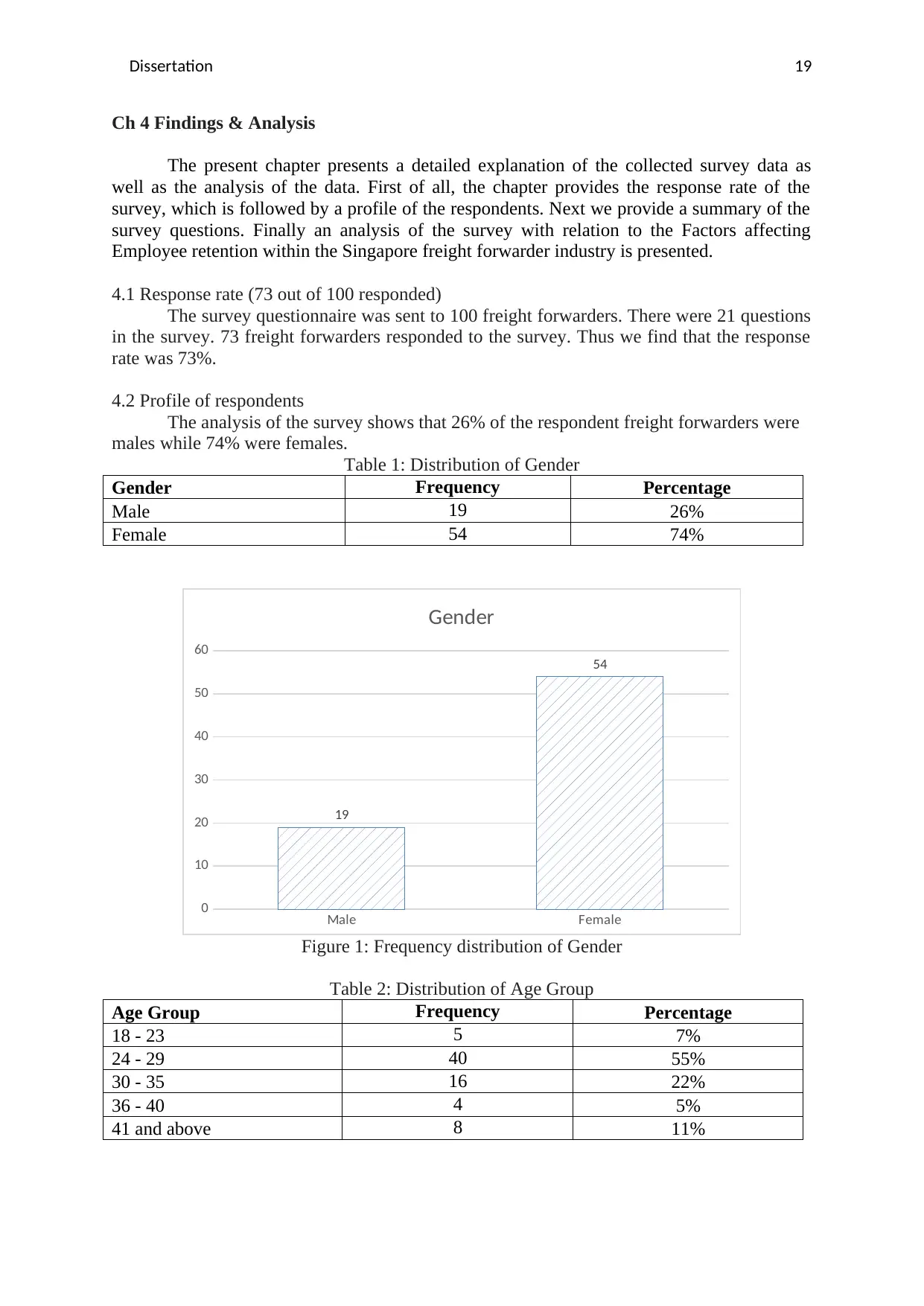
Dissertation 19
Ch 4 Findings & Analysis
The present chapter presents a detailed explanation of the collected survey data as
well as the analysis of the data. First of all, the chapter provides the response rate of the
survey, which is followed by a profile of the respondents. Next we provide a summary of the
survey questions. Finally an analysis of the survey with relation to the Factors affecting
Employee retention within the Singapore freight forwarder industry is presented.
4.1 Response rate (73 out of 100 responded)
The survey questionnaire was sent to 100 freight forwarders. There were 21 questions
in the survey. 73 freight forwarders responded to the survey. Thus we find that the response
rate was 73%.
4.2 Profile of respondents
The analysis of the survey shows that 26% of the respondent freight forwarders were
males while 74% were females.
Table 1: Distribution of Gender
Gender Frequency Percentage
Male 19 26%
Female 54 74%
Male Female
0
10
20
30
40
50
60
19
54
Gender
Figure 1: Frequency distribution of Gender
Table 2: Distribution of Age Group
Age Group Frequency Percentage
18 - 23 5 7%
24 - 29 40 55%
30 - 35 16 22%
36 - 40 4 5%
41 and above 8 11%
Ch 4 Findings & Analysis
The present chapter presents a detailed explanation of the collected survey data as
well as the analysis of the data. First of all, the chapter provides the response rate of the
survey, which is followed by a profile of the respondents. Next we provide a summary of the
survey questions. Finally an analysis of the survey with relation to the Factors affecting
Employee retention within the Singapore freight forwarder industry is presented.
4.1 Response rate (73 out of 100 responded)
The survey questionnaire was sent to 100 freight forwarders. There were 21 questions
in the survey. 73 freight forwarders responded to the survey. Thus we find that the response
rate was 73%.
4.2 Profile of respondents
The analysis of the survey shows that 26% of the respondent freight forwarders were
males while 74% were females.
Table 1: Distribution of Gender
Gender Frequency Percentage
Male 19 26%
Female 54 74%
Male Female
0
10
20
30
40
50
60
19
54
Gender
Figure 1: Frequency distribution of Gender
Table 2: Distribution of Age Group
Age Group Frequency Percentage
18 - 23 5 7%
24 - 29 40 55%
30 - 35 16 22%
36 - 40 4 5%
41 and above 8 11%
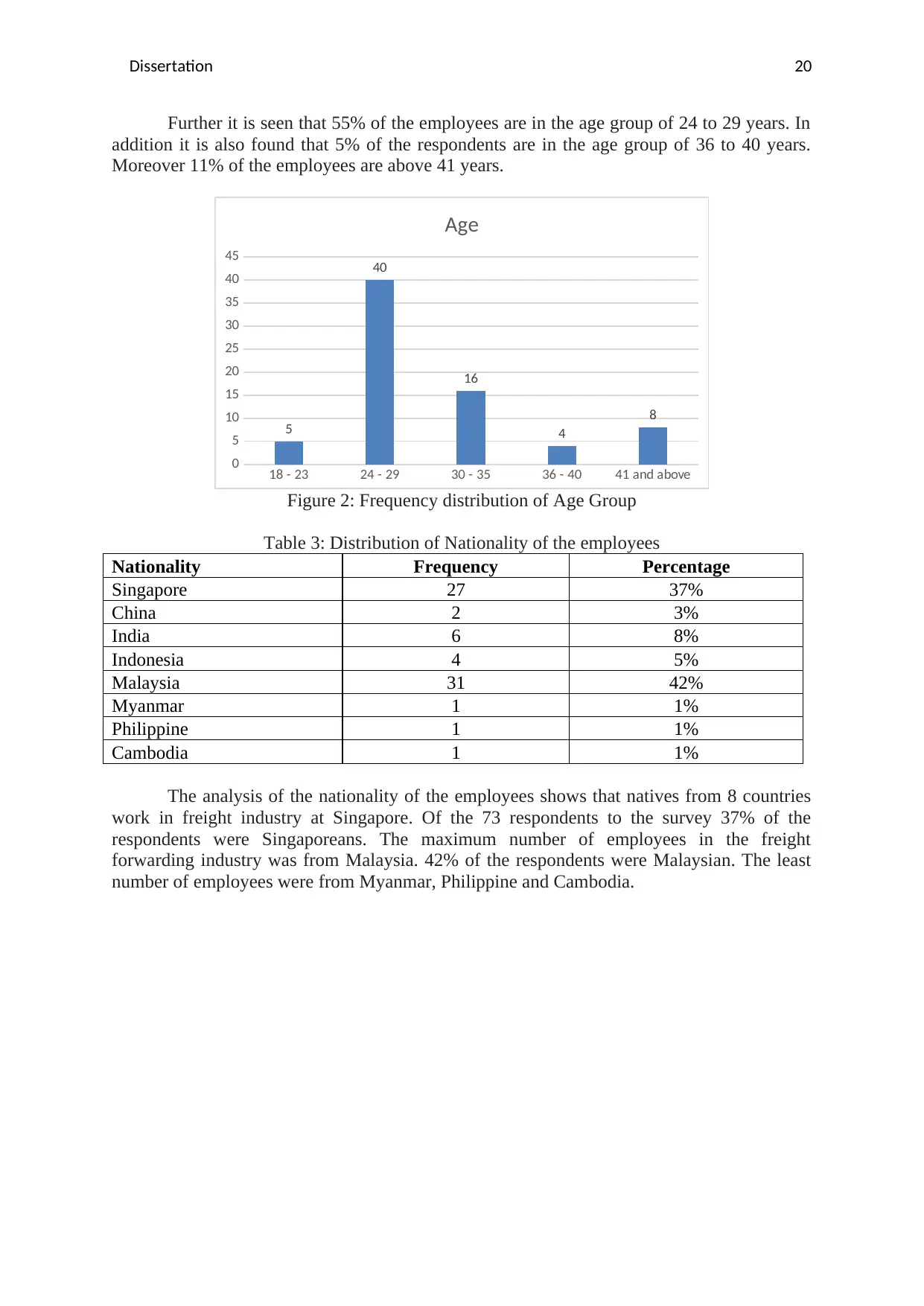
Dissertation 20
Further it is seen that 55% of the employees are in the age group of 24 to 29 years. In
addition it is also found that 5% of the respondents are in the age group of 36 to 40 years.
Moreover 11% of the employees are above 41 years.
18 - 23 24 - 29 30 - 35 36 - 40 41 and above
0
5
10
15
20
25
30
35
40
45
5
40
16
4
8
Age
Figure 2: Frequency distribution of Age Group
Table 3: Distribution of Nationality of the employees
Nationality Frequency Percentage
Singapore 27 37%
China 2 3%
India 6 8%
Indonesia 4 5%
Malaysia 31 42%
Myanmar 1 1%
Philippine 1 1%
Cambodia 1 1%
The analysis of the nationality of the employees shows that natives from 8 countries
work in freight industry at Singapore. Of the 73 respondents to the survey 37% of the
respondents were Singaporeans. The maximum number of employees in the freight
forwarding industry was from Malaysia. 42% of the respondents were Malaysian. The least
number of employees were from Myanmar, Philippine and Cambodia.
Further it is seen that 55% of the employees are in the age group of 24 to 29 years. In
addition it is also found that 5% of the respondents are in the age group of 36 to 40 years.
Moreover 11% of the employees are above 41 years.
18 - 23 24 - 29 30 - 35 36 - 40 41 and above
0
5
10
15
20
25
30
35
40
45
5
40
16
4
8
Age
Figure 2: Frequency distribution of Age Group
Table 3: Distribution of Nationality of the employees
Nationality Frequency Percentage
Singapore 27 37%
China 2 3%
India 6 8%
Indonesia 4 5%
Malaysia 31 42%
Myanmar 1 1%
Philippine 1 1%
Cambodia 1 1%
The analysis of the nationality of the employees shows that natives from 8 countries
work in freight industry at Singapore. Of the 73 respondents to the survey 37% of the
respondents were Singaporeans. The maximum number of employees in the freight
forwarding industry was from Malaysia. 42% of the respondents were Malaysian. The least
number of employees were from Myanmar, Philippine and Cambodia.
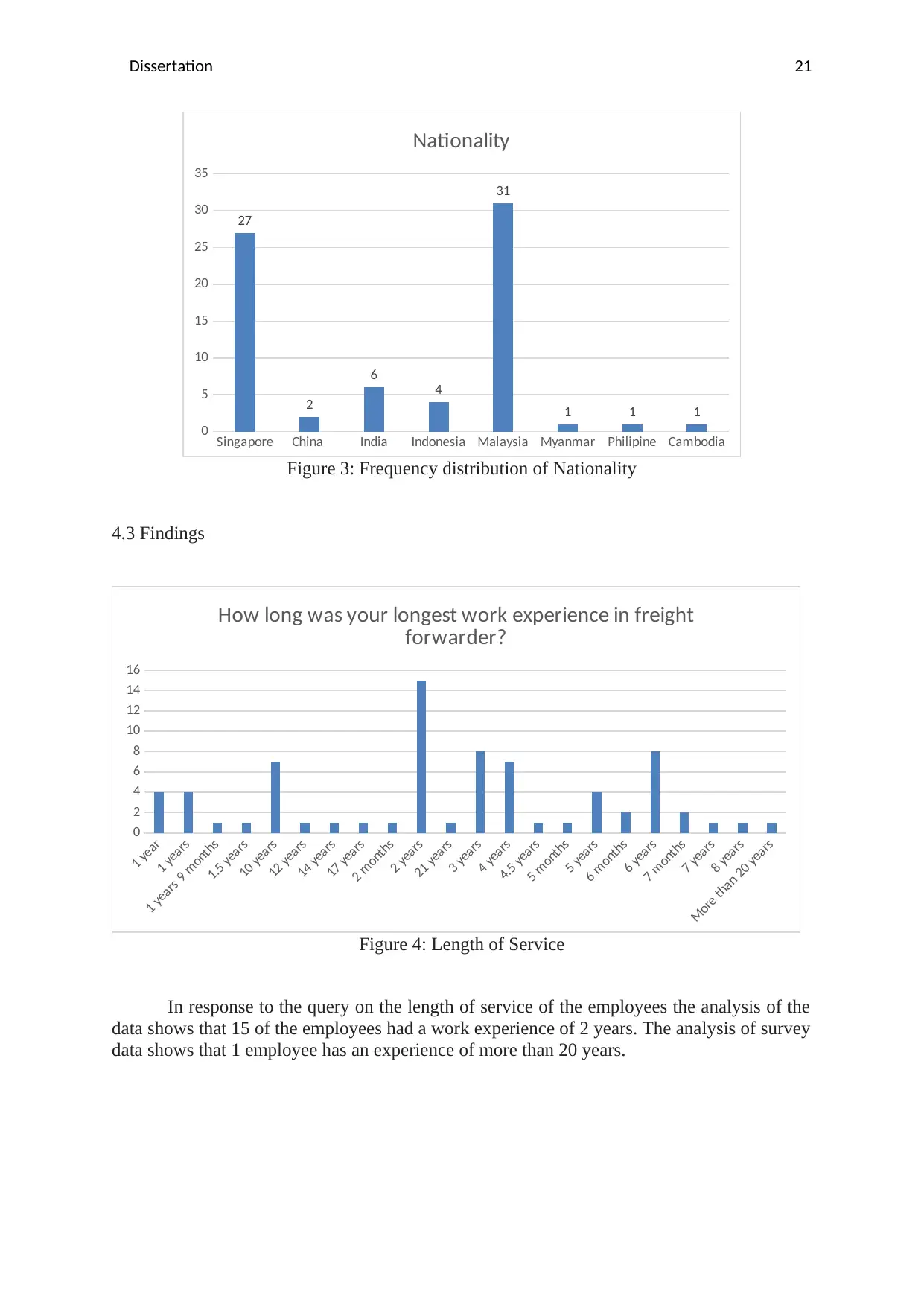
Dissertation 21
Singapore China India Indonesia Malaysia Myanmar Philipine Cambodia
0
5
10
15
20
25
30
35
27
2
6
4
31
1 1 1
Nationality
Figure 3: Frequency distribution of Nationality
4.3 Findings
1 year
1 years
1 years 9 months
1.5 years
10 years
12 years
14 years
17 years
2 months
2 years
21 years
3 years
4 years
4.5 years
5 months
5 years
6 months
6 years
7 months
7 years
8 years
More than 20 years
0
2
4
6
8
10
12
14
16
How long was your longest work experience in freight
forwarder?
Figure 4: Length of Service
In response to the query on the length of service of the employees the analysis of the
data shows that 15 of the employees had a work experience of 2 years. The analysis of survey
data shows that 1 employee has an experience of more than 20 years.
Singapore China India Indonesia Malaysia Myanmar Philipine Cambodia
0
5
10
15
20
25
30
35
27
2
6
4
31
1 1 1
Nationality
Figure 3: Frequency distribution of Nationality
4.3 Findings
1 year
1 years
1 years 9 months
1.5 years
10 years
12 years
14 years
17 years
2 months
2 years
21 years
3 years
4 years
4.5 years
5 months
5 years
6 months
6 years
7 months
7 years
8 years
More than 20 years
0
2
4
6
8
10
12
14
16
How long was your longest work experience in freight
forwarder?
Figure 4: Length of Service
In response to the query on the length of service of the employees the analysis of the
data shows that 15 of the employees had a work experience of 2 years. The analysis of survey
data shows that 1 employee has an experience of more than 20 years.
Secure Best Marks with AI Grader
Need help grading? Try our AI Grader for instant feedback on your assignments.
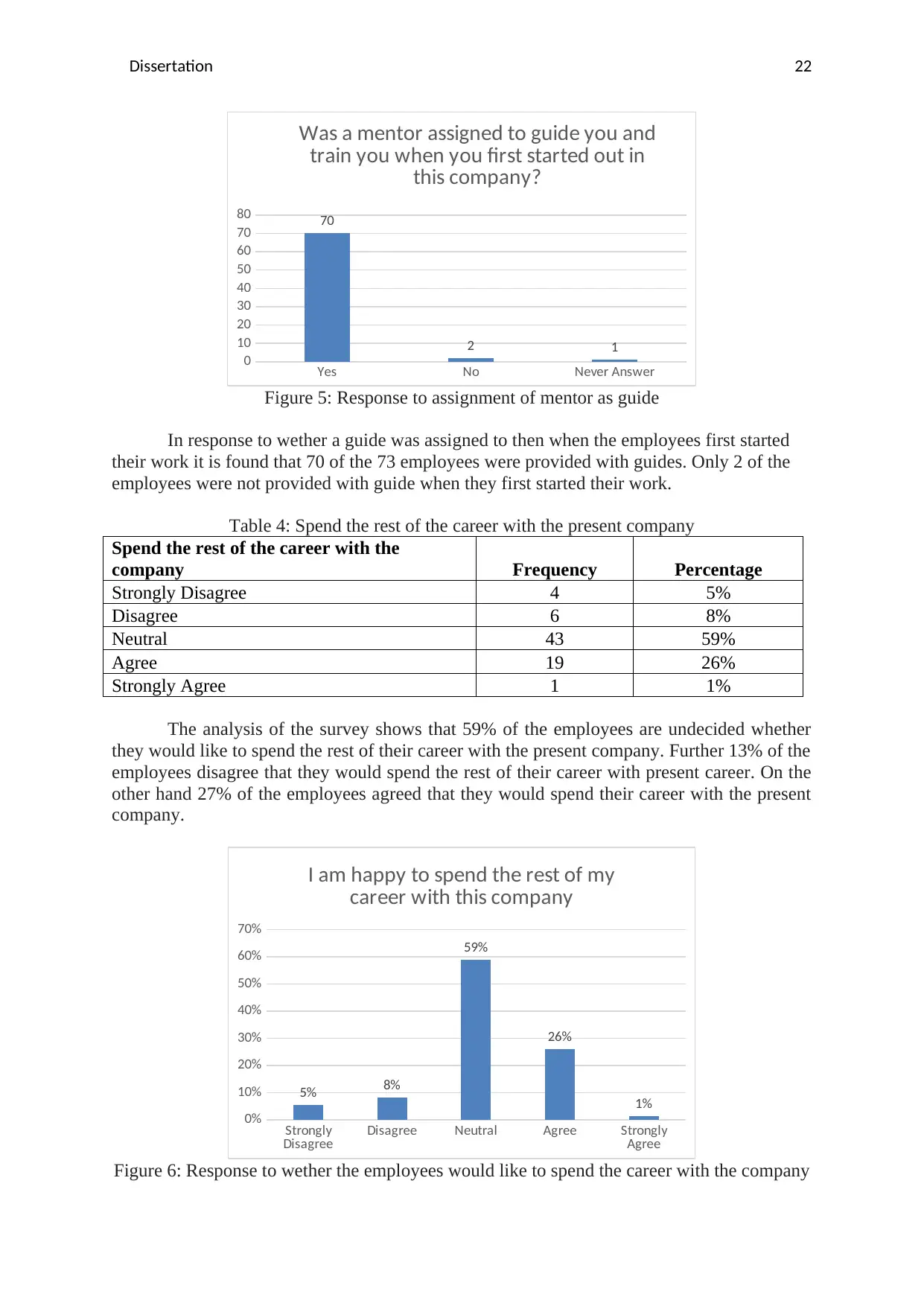
Dissertation 22
Yes No Never Answer
0
10
20
30
40
50
60
70
80 70
2 1
Was a mentor assigned to guide you and
train you when you first started out in
this company?
Figure 5: Response to assignment of mentor as guide
In response to wether a guide was assigned to then when the employees first started
their work it is found that 70 of the 73 employees were provided with guides. Only 2 of the
employees were not provided with guide when they first started their work.
Table 4: Spend the rest of the career with the present company
Spend the rest of the career with the
company Frequency Percentage
Strongly Disagree 4 5%
Disagree 6 8%
Neutral 43 59%
Agree 19 26%
Strongly Agree 1 1%
The analysis of the survey shows that 59% of the employees are undecided whether
they would like to spend the rest of their career with the present company. Further 13% of the
employees disagree that they would spend the rest of their career with present career. On the
other hand 27% of the employees agreed that they would spend their career with the present
company.
Strongly
Disagree Disagree Neutral Agree Strongly
Agree
0%
10%
20%
30%
40%
50%
60%
70%
5% 8%
59%
26%
1%
I am happy to spend the rest of my
career with this company
Figure 6: Response to wether the employees would like to spend the career with the company
Yes No Never Answer
0
10
20
30
40
50
60
70
80 70
2 1
Was a mentor assigned to guide you and
train you when you first started out in
this company?
Figure 5: Response to assignment of mentor as guide
In response to wether a guide was assigned to then when the employees first started
their work it is found that 70 of the 73 employees were provided with guides. Only 2 of the
employees were not provided with guide when they first started their work.
Table 4: Spend the rest of the career with the present company
Spend the rest of the career with the
company Frequency Percentage
Strongly Disagree 4 5%
Disagree 6 8%
Neutral 43 59%
Agree 19 26%
Strongly Agree 1 1%
The analysis of the survey shows that 59% of the employees are undecided whether
they would like to spend the rest of their career with the present company. Further 13% of the
employees disagree that they would spend the rest of their career with present career. On the
other hand 27% of the employees agreed that they would spend their career with the present
company.
Strongly
Disagree Disagree Neutral Agree Strongly
Agree
0%
10%
20%
30%
40%
50%
60%
70%
5% 8%
59%
26%
1%
I am happy to spend the rest of my
career with this company
Figure 6: Response to wether the employees would like to spend the career with the company
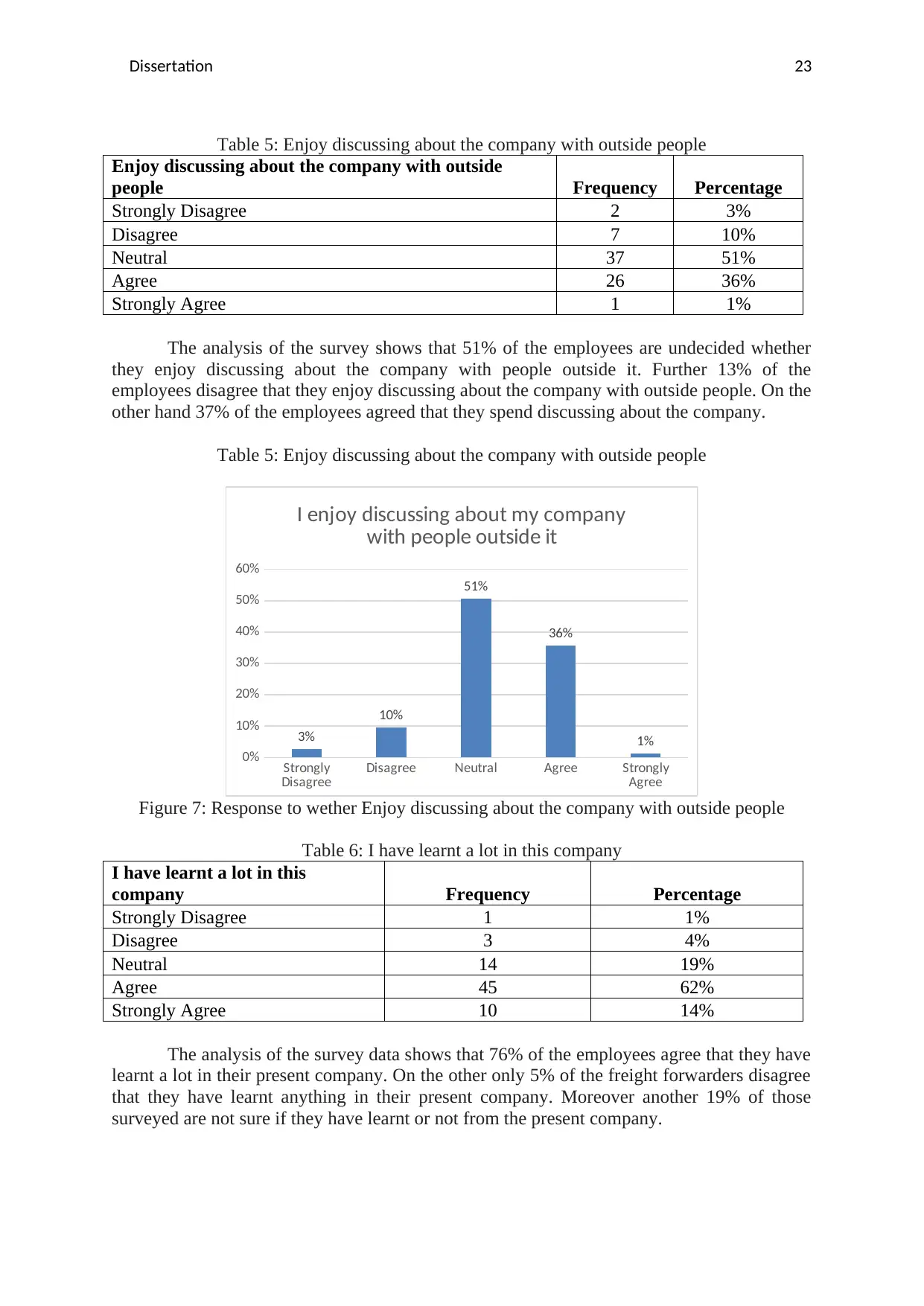
Dissertation 23
Table 5: Enjoy discussing about the company with outside people
Enjoy discussing about the company with outside
people Frequency Percentage
Strongly Disagree 2 3%
Disagree 7 10%
Neutral 37 51%
Agree 26 36%
Strongly Agree 1 1%
The analysis of the survey shows that 51% of the employees are undecided whether
they enjoy discussing about the company with people outside it. Further 13% of the
employees disagree that they enjoy discussing about the company with outside people. On the
other hand 37% of the employees agreed that they spend discussing about the company.
Table 5: Enjoy discussing about the company with outside people
Strongly
Disagree Disagree Neutral Agree Strongly
Agree
0%
10%
20%
30%
40%
50%
60%
3%
10%
51%
36%
1%
I enjoy discussing about my company
with people outside it
Figure 7: Response to wether Enjoy discussing about the company with outside people
Table 6: I have learnt a lot in this company
I have learnt a lot in this
company Frequency Percentage
Strongly Disagree 1 1%
Disagree 3 4%
Neutral 14 19%
Agree 45 62%
Strongly Agree 10 14%
The analysis of the survey data shows that 76% of the employees agree that they have
learnt a lot in their present company. On the other only 5% of the freight forwarders disagree
that they have learnt anything in their present company. Moreover another 19% of those
surveyed are not sure if they have learnt or not from the present company.
Table 5: Enjoy discussing about the company with outside people
Enjoy discussing about the company with outside
people Frequency Percentage
Strongly Disagree 2 3%
Disagree 7 10%
Neutral 37 51%
Agree 26 36%
Strongly Agree 1 1%
The analysis of the survey shows that 51% of the employees are undecided whether
they enjoy discussing about the company with people outside it. Further 13% of the
employees disagree that they enjoy discussing about the company with outside people. On the
other hand 37% of the employees agreed that they spend discussing about the company.
Table 5: Enjoy discussing about the company with outside people
Strongly
Disagree Disagree Neutral Agree Strongly
Agree
0%
10%
20%
30%
40%
50%
60%
3%
10%
51%
36%
1%
I enjoy discussing about my company
with people outside it
Figure 7: Response to wether Enjoy discussing about the company with outside people
Table 6: I have learnt a lot in this company
I have learnt a lot in this
company Frequency Percentage
Strongly Disagree 1 1%
Disagree 3 4%
Neutral 14 19%
Agree 45 62%
Strongly Agree 10 14%
The analysis of the survey data shows that 76% of the employees agree that they have
learnt a lot in their present company. On the other only 5% of the freight forwarders disagree
that they have learnt anything in their present company. Moreover another 19% of those
surveyed are not sure if they have learnt or not from the present company.
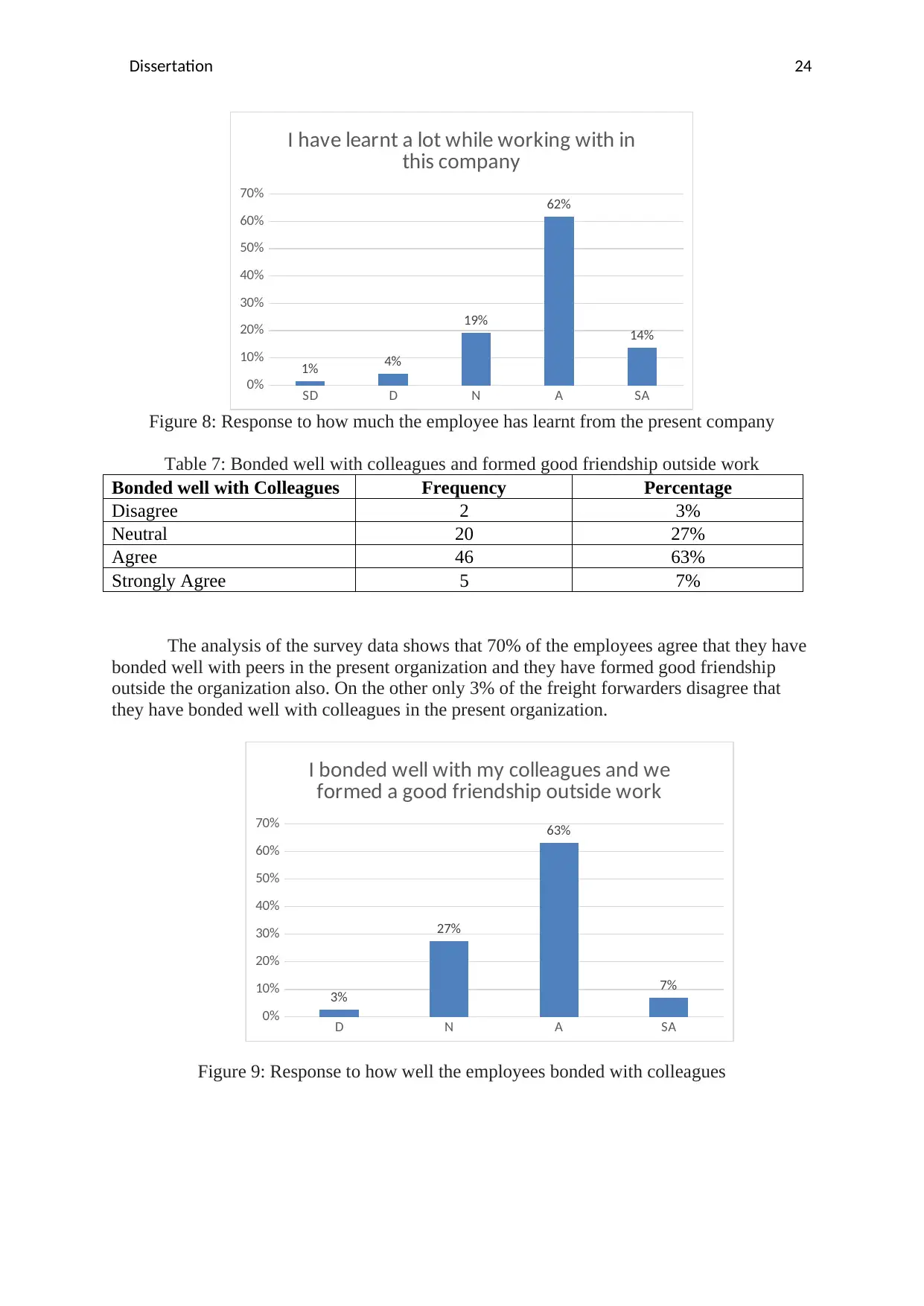
Dissertation 24
SD D N A SA
0%
10%
20%
30%
40%
50%
60%
70%
1% 4%
19%
62%
14%
I have learnt a lot while working with in
this company
Figure 8: Response to how much the employee has learnt from the present company
Table 7: Bonded well with colleagues and formed good friendship outside work
Bonded well with Colleagues Frequency Percentage
Disagree 2 3%
Neutral 20 27%
Agree 46 63%
Strongly Agree 5 7%
The analysis of the survey data shows that 70% of the employees agree that they have
bonded well with peers in the present organization and they have formed good friendship
outside the organization also. On the other only 3% of the freight forwarders disagree that
they have bonded well with colleagues in the present organization.
D N A SA
0%
10%
20%
30%
40%
50%
60%
70%
3%
27%
63%
7%
I bonded well with my colleagues and we
formed a good friendship outside work
Figure 9: Response to how well the employees bonded with colleagues
SD D N A SA
0%
10%
20%
30%
40%
50%
60%
70%
1% 4%
19%
62%
14%
I have learnt a lot while working with in
this company
Figure 8: Response to how much the employee has learnt from the present company
Table 7: Bonded well with colleagues and formed good friendship outside work
Bonded well with Colleagues Frequency Percentage
Disagree 2 3%
Neutral 20 27%
Agree 46 63%
Strongly Agree 5 7%
The analysis of the survey data shows that 70% of the employees agree that they have
bonded well with peers in the present organization and they have formed good friendship
outside the organization also. On the other only 3% of the freight forwarders disagree that
they have bonded well with colleagues in the present organization.
D N A SA
0%
10%
20%
30%
40%
50%
60%
70%
3%
27%
63%
7%
I bonded well with my colleagues and we
formed a good friendship outside work
Figure 9: Response to how well the employees bonded with colleagues
Paraphrase This Document
Need a fresh take? Get an instant paraphrase of this document with our AI Paraphraser
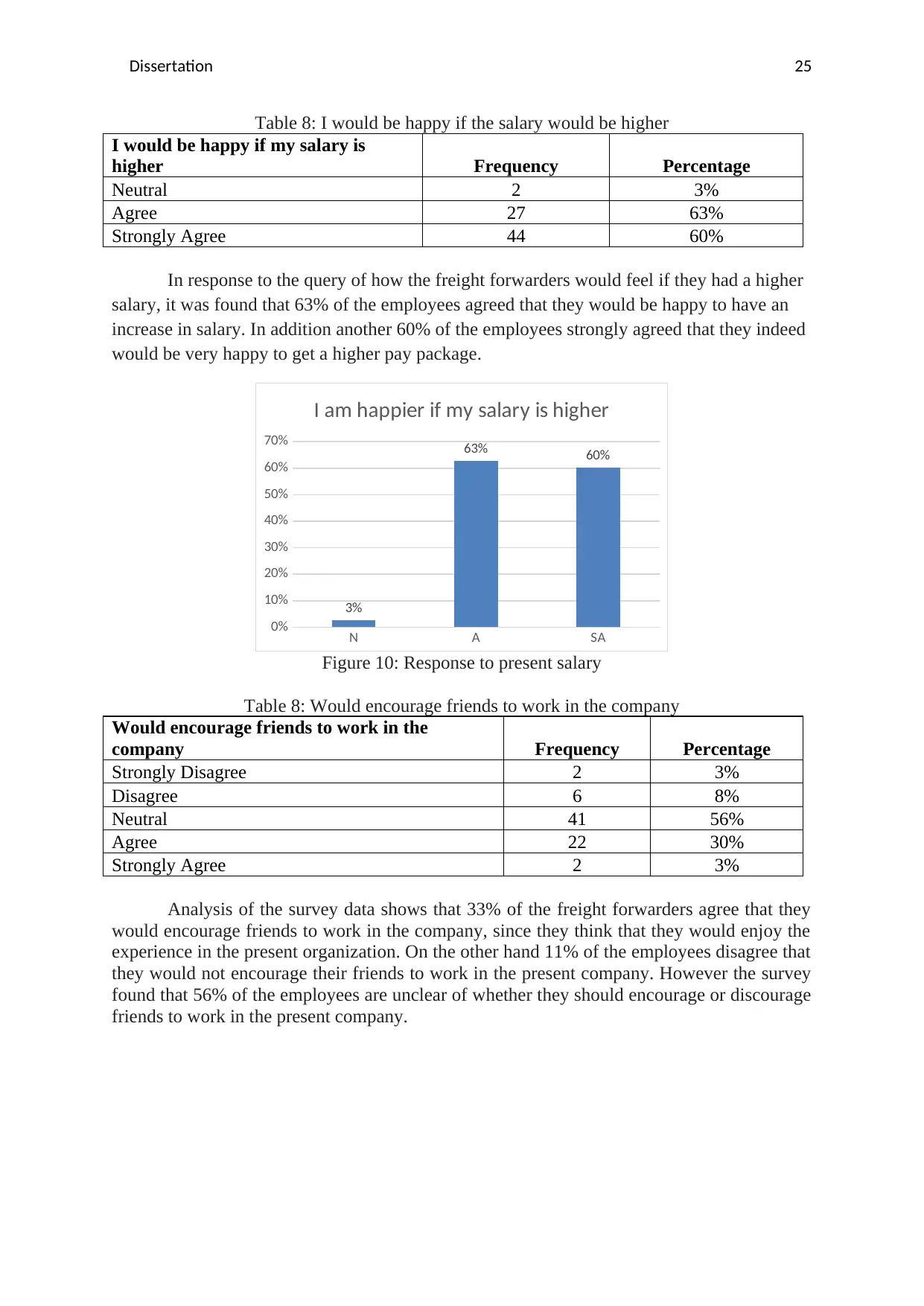
Dissertation 25
Table 8: I would be happy if the salary would be higher
I would be happy if my salary is
higher Frequency Percentage
Neutral 2 3%
Agree 27 63%
Strongly Agree 44 60%
In response to the query of how the freight forwarders would feel if they had a higher
salary, it was found that 63% of the employees agreed that they would be happy to have an
increase in salary. In addition another 60% of the employees strongly agreed that they indeed
would be very happy to get a higher pay package.
N A SA
0%
10%
20%
30%
40%
50%
60%
70%
3%
63% 60%
I am happier if my salary is higher
Figure 10: Response to present salary
Table 8: Would encourage friends to work in the company
Would encourage friends to work in the
company Frequency Percentage
Strongly Disagree 2 3%
Disagree 6 8%
Neutral 41 56%
Agree 22 30%
Strongly Agree 2 3%
Analysis of the survey data shows that 33% of the freight forwarders agree that they
would encourage friends to work in the company, since they think that they would enjoy the
experience in the present organization. On the other hand 11% of the employees disagree that
they would not encourage their friends to work in the present company. However the survey
found that 56% of the employees are unclear of whether they should encourage or discourage
friends to work in the present company.
Table 8: I would be happy if the salary would be higher
I would be happy if my salary is
higher Frequency Percentage
Neutral 2 3%
Agree 27 63%
Strongly Agree 44 60%
In response to the query of how the freight forwarders would feel if they had a higher
salary, it was found that 63% of the employees agreed that they would be happy to have an
increase in salary. In addition another 60% of the employees strongly agreed that they indeed
would be very happy to get a higher pay package.
N A SA
0%
10%
20%
30%
40%
50%
60%
70%
3%
63% 60%
I am happier if my salary is higher
Figure 10: Response to present salary
Table 8: Would encourage friends to work in the company
Would encourage friends to work in the
company Frequency Percentage
Strongly Disagree 2 3%
Disagree 6 8%
Neutral 41 56%
Agree 22 30%
Strongly Agree 2 3%
Analysis of the survey data shows that 33% of the freight forwarders agree that they
would encourage friends to work in the company, since they think that they would enjoy the
experience in the present organization. On the other hand 11% of the employees disagree that
they would not encourage their friends to work in the present company. However the survey
found that 56% of the employees are unclear of whether they should encourage or discourage
friends to work in the present company.
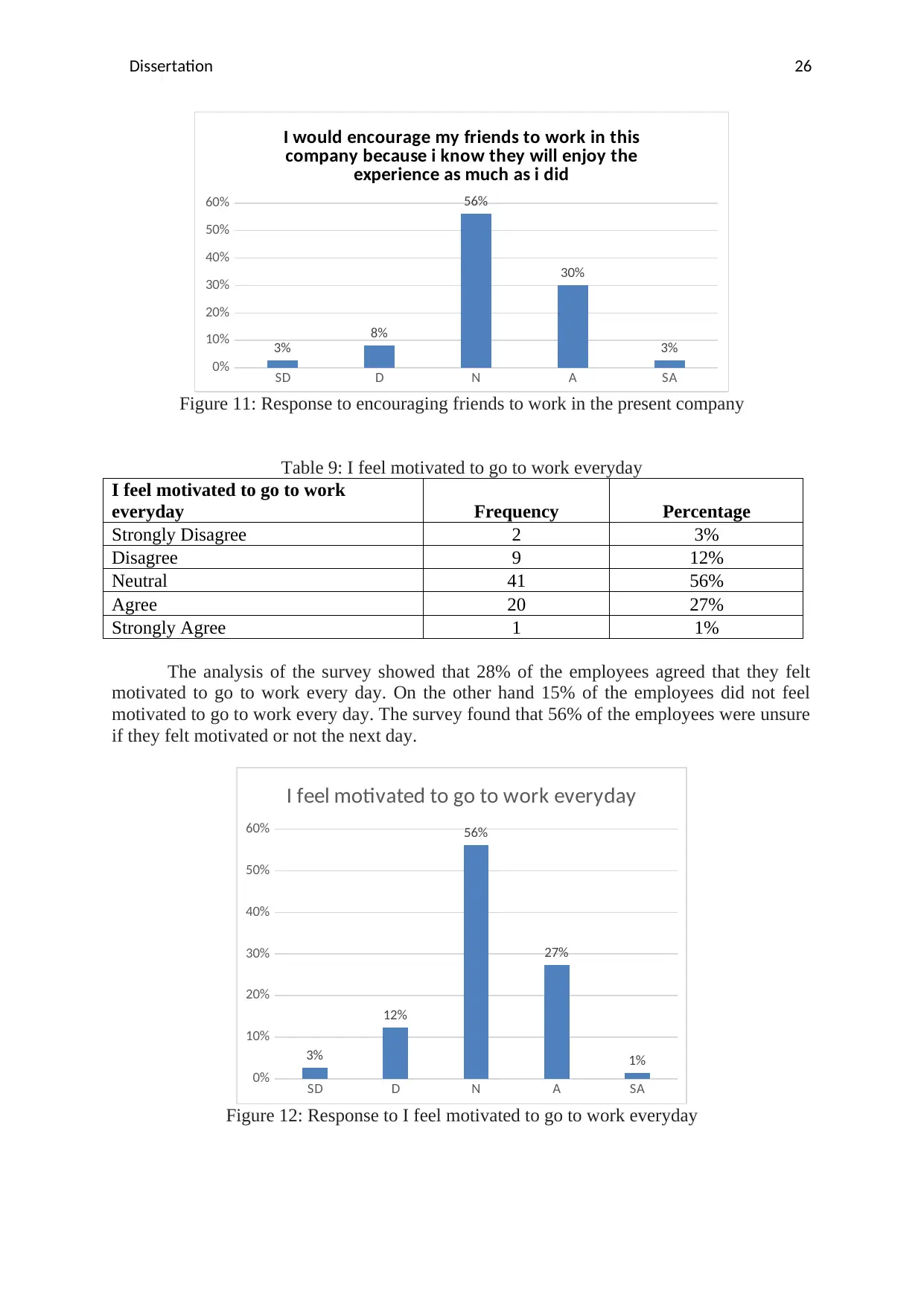
Dissertation 26
SD D N A SA
0%
10%
20%
30%
40%
50%
60%
3%
8%
56%
30%
3%
I would encourage my friends to work in this
company because i know they will enjoy the
experience as much as i did
Figure 11: Response to encouraging friends to work in the present company
Table 9: I feel motivated to go to work everyday
I feel motivated to go to work
everyday Frequency Percentage
Strongly Disagree 2 3%
Disagree 9 12%
Neutral 41 56%
Agree 20 27%
Strongly Agree 1 1%
The analysis of the survey showed that 28% of the employees agreed that they felt
motivated to go to work every day. On the other hand 15% of the employees did not feel
motivated to go to work every day. The survey found that 56% of the employees were unsure
if they felt motivated or not the next day.
SD D N A SA
0%
10%
20%
30%
40%
50%
60%
3%
12%
56%
27%
1%
I feel motivated to go to work everyday
Figure 12: Response to I feel motivated to go to work everyday
SD D N A SA
0%
10%
20%
30%
40%
50%
60%
3%
8%
56%
30%
3%
I would encourage my friends to work in this
company because i know they will enjoy the
experience as much as i did
Figure 11: Response to encouraging friends to work in the present company
Table 9: I feel motivated to go to work everyday
I feel motivated to go to work
everyday Frequency Percentage
Strongly Disagree 2 3%
Disagree 9 12%
Neutral 41 56%
Agree 20 27%
Strongly Agree 1 1%
The analysis of the survey showed that 28% of the employees agreed that they felt
motivated to go to work every day. On the other hand 15% of the employees did not feel
motivated to go to work every day. The survey found that 56% of the employees were unsure
if they felt motivated or not the next day.
SD D N A SA
0%
10%
20%
30%
40%
50%
60%
3%
12%
56%
27%
1%
I feel motivated to go to work everyday
Figure 12: Response to I feel motivated to go to work everyday
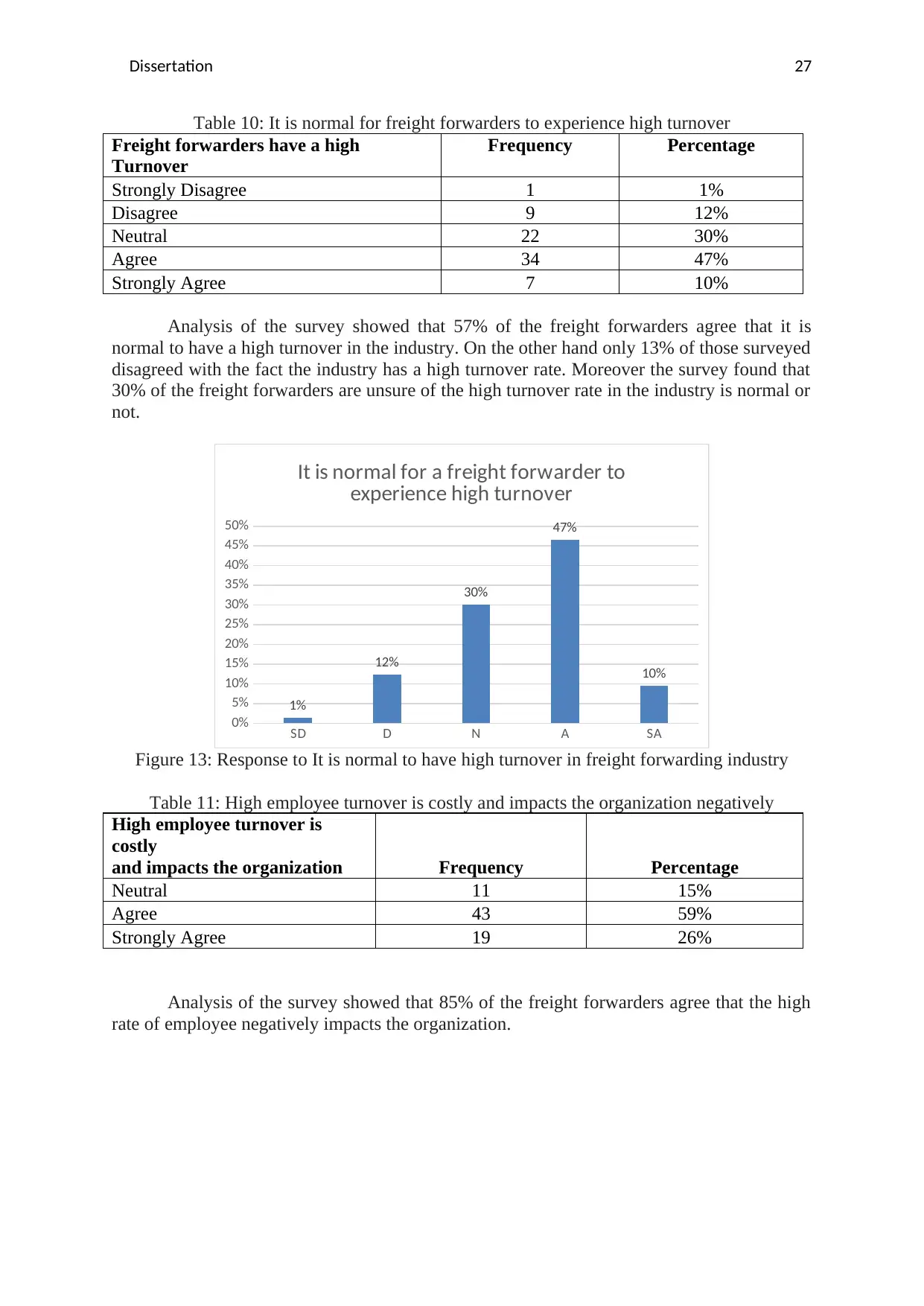
Dissertation 27
Table 10: It is normal for freight forwarders to experience high turnover
Freight forwarders have a high
Turnover
Frequency Percentage
Strongly Disagree 1 1%
Disagree 9 12%
Neutral 22 30%
Agree 34 47%
Strongly Agree 7 10%
Analysis of the survey showed that 57% of the freight forwarders agree that it is
normal to have a high turnover in the industry. On the other hand only 13% of those surveyed
disagreed with the fact the industry has a high turnover rate. Moreover the survey found that
30% of the freight forwarders are unsure of the high turnover rate in the industry is normal or
not.
SD D N A SA
0%
5%
10%
15%
20%
25%
30%
35%
40%
45%
50%
1%
12%
30%
47%
10%
It is normal for a freight forwarder to
experience high turnover
Figure 13: Response to It is normal to have high turnover in freight forwarding industry
Table 11: High employee turnover is costly and impacts the organization negatively
High employee turnover is
costly
and impacts the organization Frequency Percentage
Neutral 11 15%
Agree 43 59%
Strongly Agree 19 26%
Analysis of the survey showed that 85% of the freight forwarders agree that the high
rate of employee negatively impacts the organization.
Table 10: It is normal for freight forwarders to experience high turnover
Freight forwarders have a high
Turnover
Frequency Percentage
Strongly Disagree 1 1%
Disagree 9 12%
Neutral 22 30%
Agree 34 47%
Strongly Agree 7 10%
Analysis of the survey showed that 57% of the freight forwarders agree that it is
normal to have a high turnover in the industry. On the other hand only 13% of those surveyed
disagreed with the fact the industry has a high turnover rate. Moreover the survey found that
30% of the freight forwarders are unsure of the high turnover rate in the industry is normal or
not.
SD D N A SA
0%
5%
10%
15%
20%
25%
30%
35%
40%
45%
50%
1%
12%
30%
47%
10%
It is normal for a freight forwarder to
experience high turnover
Figure 13: Response to It is normal to have high turnover in freight forwarding industry
Table 11: High employee turnover is costly and impacts the organization negatively
High employee turnover is
costly
and impacts the organization Frequency Percentage
Neutral 11 15%
Agree 43 59%
Strongly Agree 19 26%
Analysis of the survey showed that 85% of the freight forwarders agree that the high
rate of employee negatively impacts the organization.
Secure Best Marks with AI Grader
Need help grading? Try our AI Grader for instant feedback on your assignments.
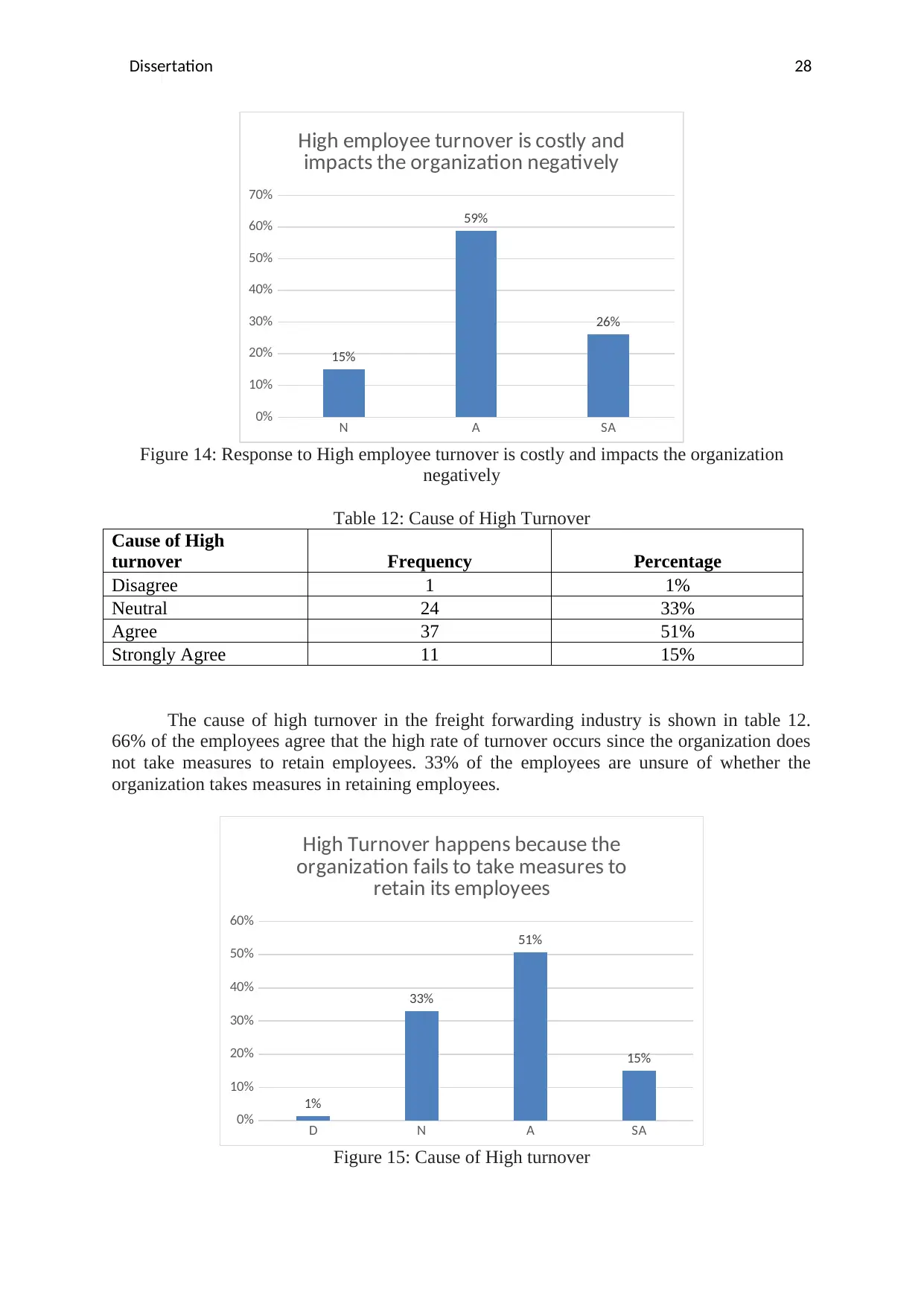
Dissertation 28
N A SA
0%
10%
20%
30%
40%
50%
60%
70%
15%
59%
26%
High employee turnover is costly and
impacts the organization negatively
Figure 14: Response to High employee turnover is costly and impacts the organization
negatively
Table 12: Cause of High Turnover
Cause of High
turnover Frequency Percentage
Disagree 1 1%
Neutral 24 33%
Agree 37 51%
Strongly Agree 11 15%
The cause of high turnover in the freight forwarding industry is shown in table 12.
66% of the employees agree that the high rate of turnover occurs since the organization does
not take measures to retain employees. 33% of the employees are unsure of whether the
organization takes measures in retaining employees.
D N A SA
0%
10%
20%
30%
40%
50%
60%
1%
33%
51%
15%
High Turnover happens because the
organization fails to take measures to
retain its employees
Figure 15: Cause of High turnover
N A SA
0%
10%
20%
30%
40%
50%
60%
70%
15%
59%
26%
High employee turnover is costly and
impacts the organization negatively
Figure 14: Response to High employee turnover is costly and impacts the organization
negatively
Table 12: Cause of High Turnover
Cause of High
turnover Frequency Percentage
Disagree 1 1%
Neutral 24 33%
Agree 37 51%
Strongly Agree 11 15%
The cause of high turnover in the freight forwarding industry is shown in table 12.
66% of the employees agree that the high rate of turnover occurs since the organization does
not take measures to retain employees. 33% of the employees are unsure of whether the
organization takes measures in retaining employees.
D N A SA
0%
10%
20%
30%
40%
50%
60%
1%
33%
51%
15%
High Turnover happens because the
organization fails to take measures to
retain its employees
Figure 15: Cause of High turnover
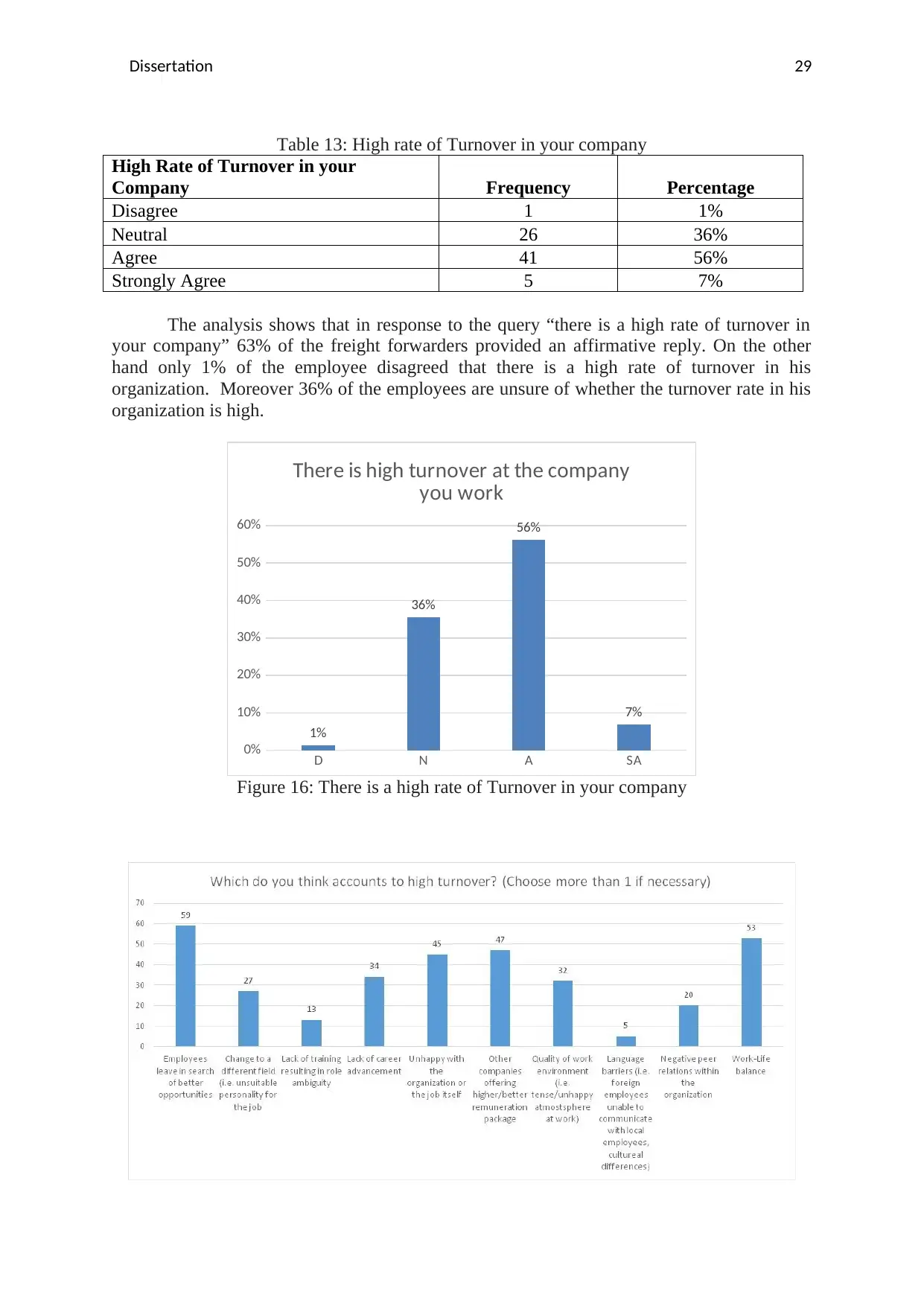
Dissertation 29
Table 13: High rate of Turnover in your company
High Rate of Turnover in your
Company Frequency Percentage
Disagree 1 1%
Neutral 26 36%
Agree 41 56%
Strongly Agree 5 7%
The analysis shows that in response to the query “there is a high rate of turnover in
your company” 63% of the freight forwarders provided an affirmative reply. On the other
hand only 1% of the employee disagreed that there is a high rate of turnover in his
organization. Moreover 36% of the employees are unsure of whether the turnover rate in his
organization is high.
D N A SA
0%
10%
20%
30%
40%
50%
60%
1%
36%
56%
7%
There is high turnover at the company
you work
Figure 16: There is a high rate of Turnover in your company
Table 13: High rate of Turnover in your company
High Rate of Turnover in your
Company Frequency Percentage
Disagree 1 1%
Neutral 26 36%
Agree 41 56%
Strongly Agree 5 7%
The analysis shows that in response to the query “there is a high rate of turnover in
your company” 63% of the freight forwarders provided an affirmative reply. On the other
hand only 1% of the employee disagreed that there is a high rate of turnover in his
organization. Moreover 36% of the employees are unsure of whether the turnover rate in his
organization is high.
D N A SA
0%
10%
20%
30%
40%
50%
60%
1%
36%
56%
7%
There is high turnover at the company
you work
Figure 16: There is a high rate of Turnover in your company
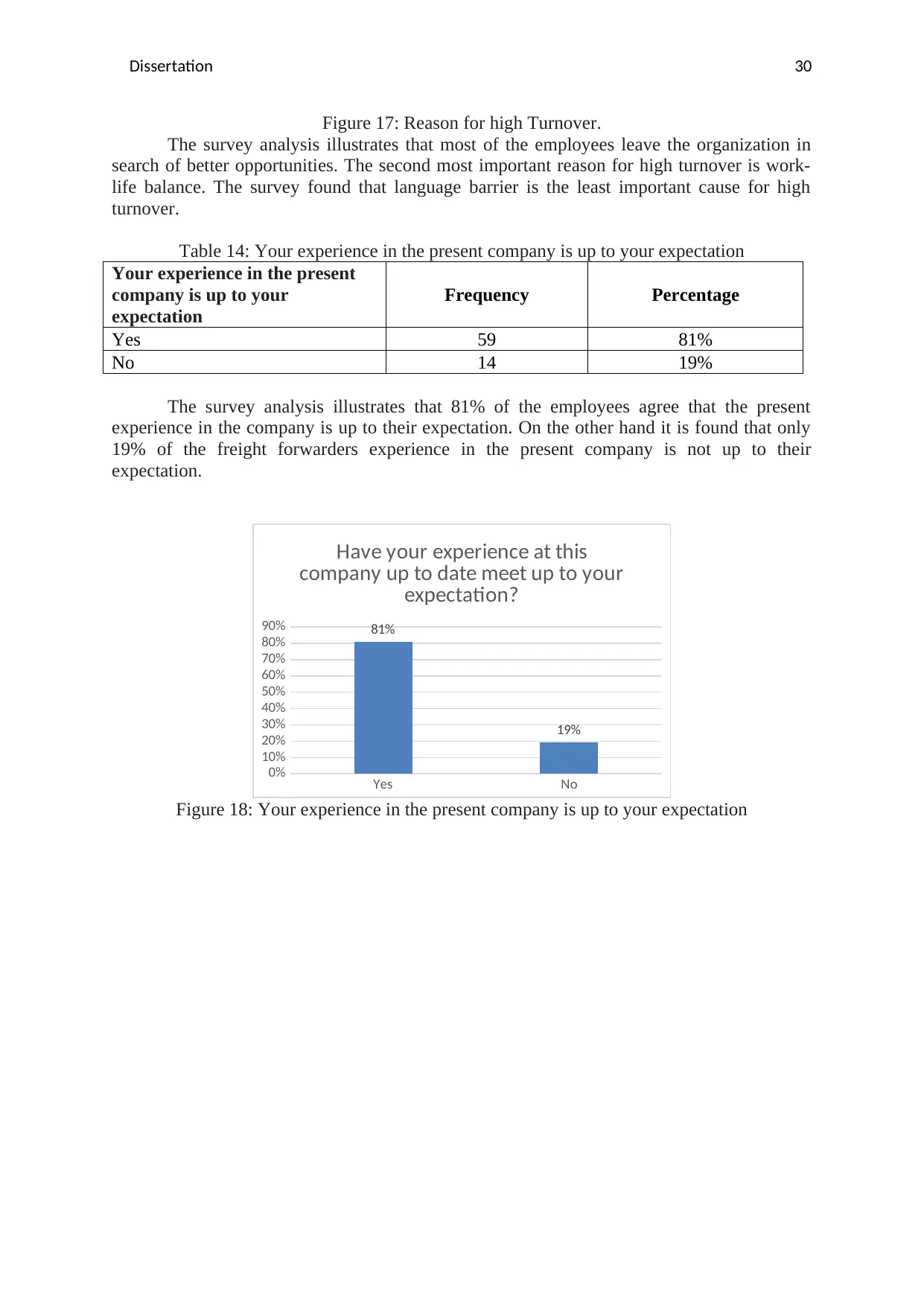
Dissertation 30
Figure 17: Reason for high Turnover.
The survey analysis illustrates that most of the employees leave the organization in
search of better opportunities. The second most important reason for high turnover is work-
life balance. The survey found that language barrier is the least important cause for high
turnover.
Table 14: Your experience in the present company is up to your expectation
Your experience in the present
company is up to your
expectation
Frequency Percentage
Yes 59 81%
No 14 19%
The survey analysis illustrates that 81% of the employees agree that the present
experience in the company is up to their expectation. On the other hand it is found that only
19% of the freight forwarders experience in the present company is not up to their
expectation.
Yes No
0%
10%
20%
30%
40%
50%
60%
70%
80%
90% 81%
19%
Have your experience at this
company up to date meet up to your
expectation?
Figure 18: Your experience in the present company is up to your expectation
Figure 17: Reason for high Turnover.
The survey analysis illustrates that most of the employees leave the organization in
search of better opportunities. The second most important reason for high turnover is work-
life balance. The survey found that language barrier is the least important cause for high
turnover.
Table 14: Your experience in the present company is up to your expectation
Your experience in the present
company is up to your
expectation
Frequency Percentage
Yes 59 81%
No 14 19%
The survey analysis illustrates that 81% of the employees agree that the present
experience in the company is up to their expectation. On the other hand it is found that only
19% of the freight forwarders experience in the present company is not up to their
expectation.
Yes No
0%
10%
20%
30%
40%
50%
60%
70%
80%
90% 81%
19%
Have your experience at this
company up to date meet up to your
expectation?
Figure 18: Your experience in the present company is up to your expectation
Paraphrase This Document
Need a fresh take? Get an instant paraphrase of this document with our AI Paraphraser
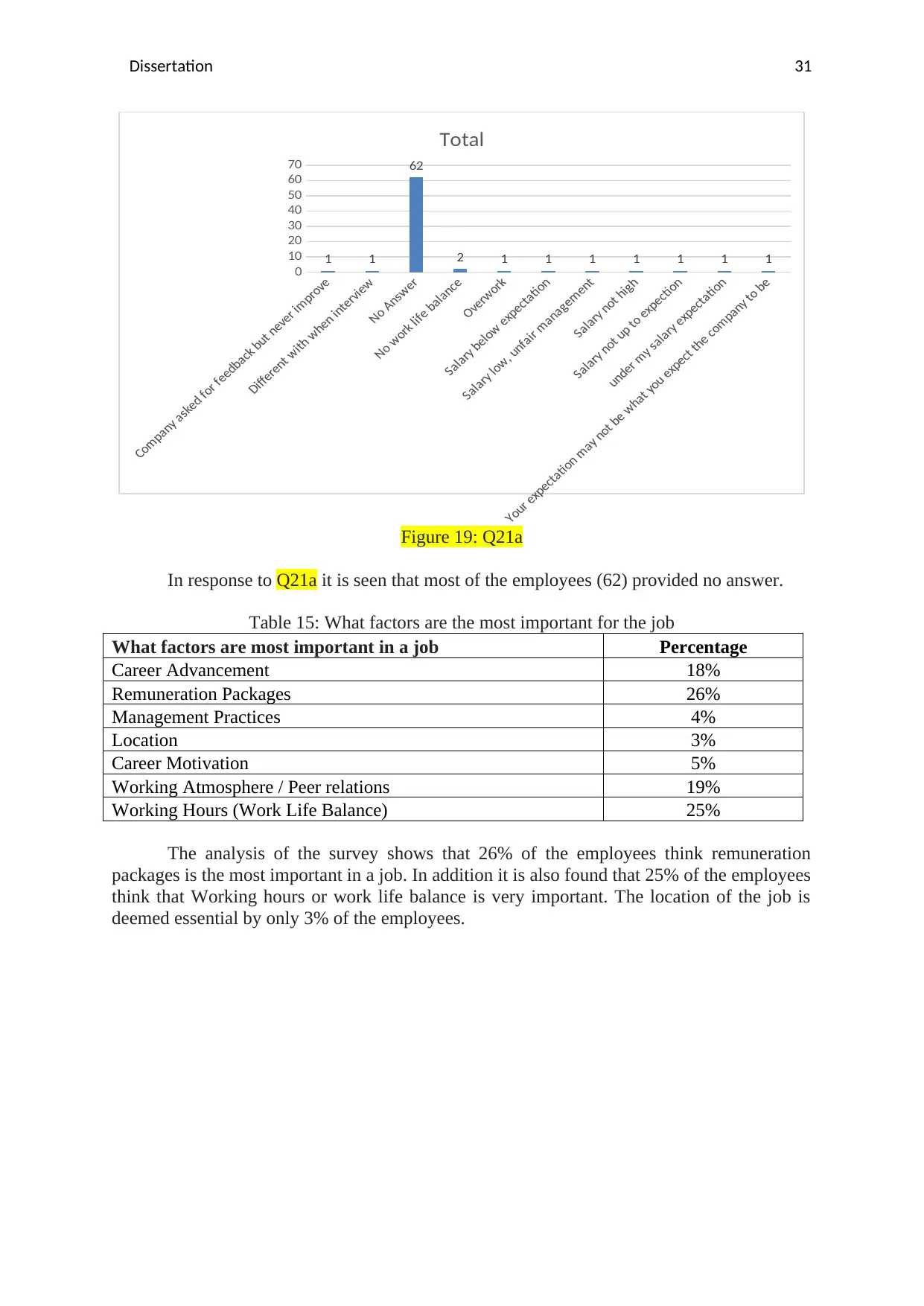
Dissertation 31
0
10
20
30
40
50
60
70
1 1
62
2 1 1 1 1 1 1 1
Total
Figure 19: Q21a
In response to Q21a it is seen that most of the employees (62) provided no answer.
Table 15: What factors are the most important for the job
What factors are most important in a job Percentage
Career Advancement 18%
Remuneration Packages 26%
Management Practices 4%
Location 3%
Career Motivation 5%
Working Atmosphere / Peer relations 19%
Working Hours (Work Life Balance) 25%
The analysis of the survey shows that 26% of the employees think remuneration
packages is the most important in a job. In addition it is also found that 25% of the employees
think that Working hours or work life balance is very important. The location of the job is
deemed essential by only 3% of the employees.
0
10
20
30
40
50
60
70
1 1
62
2 1 1 1 1 1 1 1
Total
Figure 19: Q21a
In response to Q21a it is seen that most of the employees (62) provided no answer.
Table 15: What factors are the most important for the job
What factors are most important in a job Percentage
Career Advancement 18%
Remuneration Packages 26%
Management Practices 4%
Location 3%
Career Motivation 5%
Working Atmosphere / Peer relations 19%
Working Hours (Work Life Balance) 25%
The analysis of the survey shows that 26% of the employees think remuneration
packages is the most important in a job. In addition it is also found that 25% of the employees
think that Working hours or work life balance is very important. The location of the job is
deemed essential by only 3% of the employees.
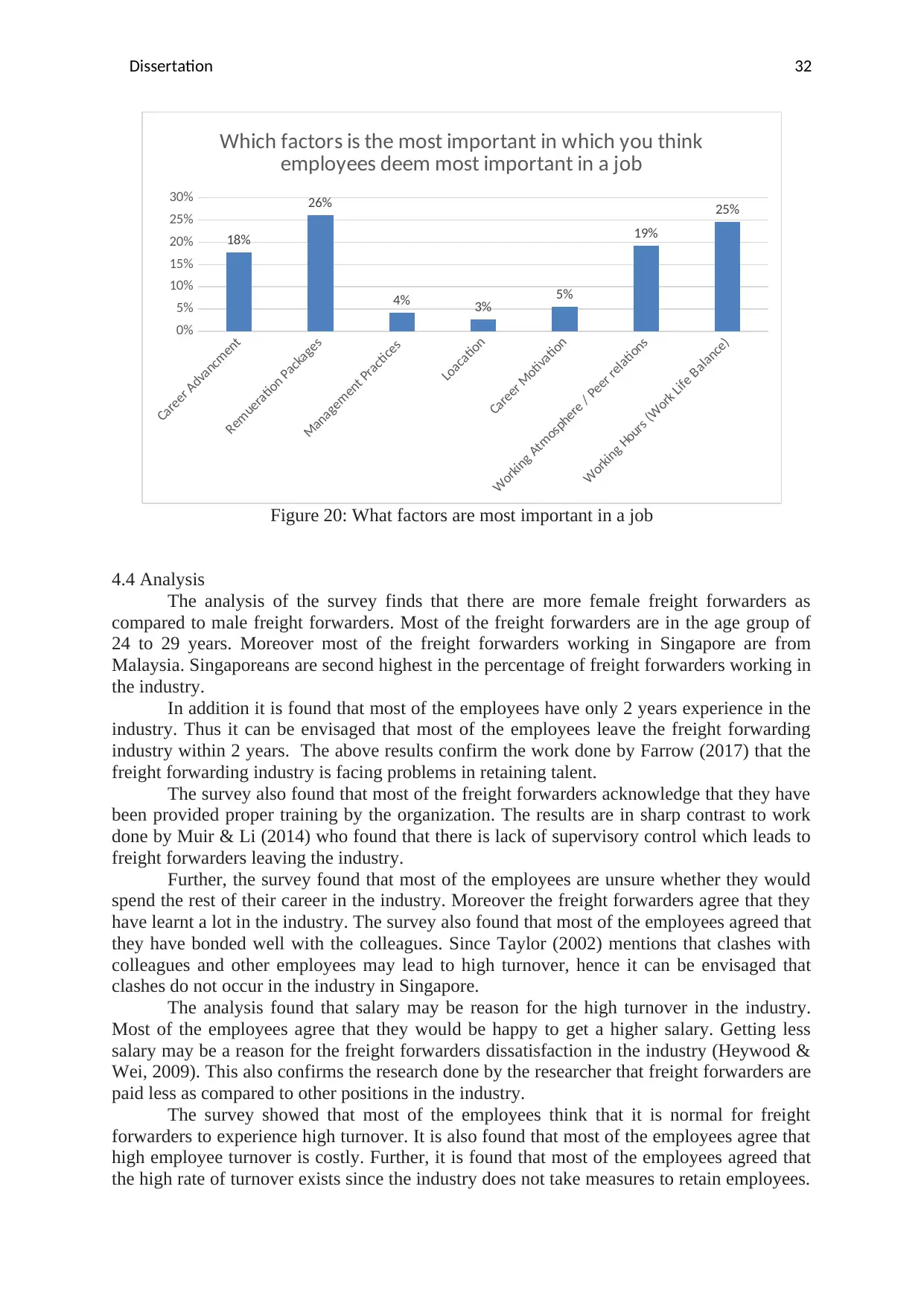
Dissertation 32
Career Advancment
Remueration Packages
Management Practices
Loacation
Career Motivation
Working Atmosphere / Peer relations
Working Hours (Work Life Balance)
0%
5%
10%
15%
20%
25%
30%
18%
26%
4% 3% 5%
19%
25%
Which factors is the most important in which you think
employees deem most important in a job
Figure 20: What factors are most important in a job
4.4 Analysis
The analysis of the survey finds that there are more female freight forwarders as
compared to male freight forwarders. Most of the freight forwarders are in the age group of
24 to 29 years. Moreover most of the freight forwarders working in Singapore are from
Malaysia. Singaporeans are second highest in the percentage of freight forwarders working in
the industry.
In addition it is found that most of the employees have only 2 years experience in the
industry. Thus it can be envisaged that most of the employees leave the freight forwarding
industry within 2 years. The above results confirm the work done by Farrow (2017) that the
freight forwarding industry is facing problems in retaining talent.
The survey also found that most of the freight forwarders acknowledge that they have
been provided proper training by the organization. The results are in sharp contrast to work
done by Muir & Li (2014) who found that there is lack of supervisory control which leads to
freight forwarders leaving the industry.
Further, the survey found that most of the employees are unsure whether they would
spend the rest of their career in the industry. Moreover the freight forwarders agree that they
have learnt a lot in the industry. The survey also found that most of the employees agreed that
they have bonded well with the colleagues. Since Taylor (2002) mentions that clashes with
colleagues and other employees may lead to high turnover, hence it can be envisaged that
clashes do not occur in the industry in Singapore.
The analysis found that salary may be reason for the high turnover in the industry.
Most of the employees agree that they would be happy to get a higher salary. Getting less
salary may be a reason for the freight forwarders dissatisfaction in the industry (Heywood &
Wei, 2009). This also confirms the research done by the researcher that freight forwarders are
paid less as compared to other positions in the industry.
The survey showed that most of the employees think that it is normal for freight
forwarders to experience high turnover. It is also found that most of the employees agree that
high employee turnover is costly. Further, it is found that most of the employees agreed that
the high rate of turnover exists since the industry does not take measures to retain employees.
Career Advancment
Remueration Packages
Management Practices
Loacation
Career Motivation
Working Atmosphere / Peer relations
Working Hours (Work Life Balance)
0%
5%
10%
15%
20%
25%
30%
18%
26%
4% 3% 5%
19%
25%
Which factors is the most important in which you think
employees deem most important in a job
Figure 20: What factors are most important in a job
4.4 Analysis
The analysis of the survey finds that there are more female freight forwarders as
compared to male freight forwarders. Most of the freight forwarders are in the age group of
24 to 29 years. Moreover most of the freight forwarders working in Singapore are from
Malaysia. Singaporeans are second highest in the percentage of freight forwarders working in
the industry.
In addition it is found that most of the employees have only 2 years experience in the
industry. Thus it can be envisaged that most of the employees leave the freight forwarding
industry within 2 years. The above results confirm the work done by Farrow (2017) that the
freight forwarding industry is facing problems in retaining talent.
The survey also found that most of the freight forwarders acknowledge that they have
been provided proper training by the organization. The results are in sharp contrast to work
done by Muir & Li (2014) who found that there is lack of supervisory control which leads to
freight forwarders leaving the industry.
Further, the survey found that most of the employees are unsure whether they would
spend the rest of their career in the industry. Moreover the freight forwarders agree that they
have learnt a lot in the industry. The survey also found that most of the employees agreed that
they have bonded well with the colleagues. Since Taylor (2002) mentions that clashes with
colleagues and other employees may lead to high turnover, hence it can be envisaged that
clashes do not occur in the industry in Singapore.
The analysis found that salary may be reason for the high turnover in the industry.
Most of the employees agree that they would be happy to get a higher salary. Getting less
salary may be a reason for the freight forwarders dissatisfaction in the industry (Heywood &
Wei, 2009). This also confirms the research done by the researcher that freight forwarders are
paid less as compared to other positions in the industry.
The survey showed that most of the employees think that it is normal for freight
forwarders to experience high turnover. It is also found that most of the employees agree that
high employee turnover is costly. Further, it is found that most of the employees agreed that
the high rate of turnover exists since the industry does not take measures to retain employees.

Dissertation 33
As discussed by Liang et al. (2015) various reasons exists for the high turnover rate. Hence, it
can be perceived that the industry does not follow theories as envisaged by Kusluvan (2003).
Thus the industry is unable to retain talent. The analysis also confirms research done by Muir
& Li (2014) who found that poor management practices leads to high turnover.
As discussed by Liang et al. (2015) various reasons exists for the high turnover rate. Hence, it
can be perceived that the industry does not follow theories as envisaged by Kusluvan (2003).
Thus the industry is unable to retain talent. The analysis also confirms research done by Muir
& Li (2014) who found that poor management practices leads to high turnover.
Secure Best Marks with AI Grader
Need help grading? Try our AI Grader for instant feedback on your assignments.
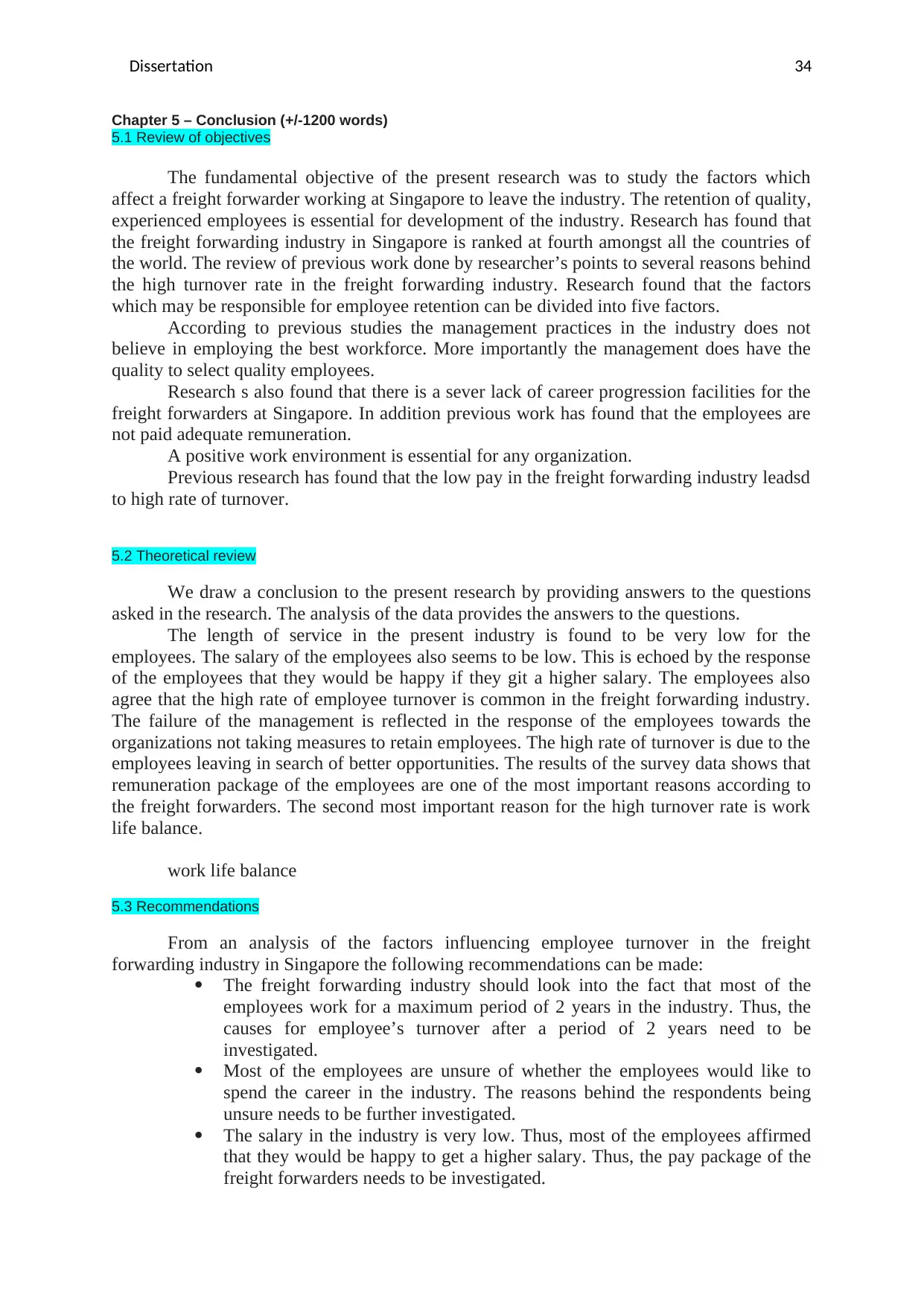
Dissertation 34
Chapter 5 – Conclusion (+/-1200 words)
5.1 Review of objectives
The fundamental objective of the present research was to study the factors which
affect a freight forwarder working at Singapore to leave the industry. The retention of quality,
experienced employees is essential for development of the industry. Research has found that
the freight forwarding industry in Singapore is ranked at fourth amongst all the countries of
the world. The review of previous work done by researcher’s points to several reasons behind
the high turnover rate in the freight forwarding industry. Research found that the factors
which may be responsible for employee retention can be divided into five factors.
According to previous studies the management practices in the industry does not
believe in employing the best workforce. More importantly the management does have the
quality to select quality employees.
Research s also found that there is a sever lack of career progression facilities for the
freight forwarders at Singapore. In addition previous work has found that the employees are
not paid adequate remuneration.
A positive work environment is essential for any organization.
Previous research has found that the low pay in the freight forwarding industry leadsd
to high rate of turnover.
5.2 Theoretical review
We draw a conclusion to the present research by providing answers to the questions
asked in the research. The analysis of the data provides the answers to the questions.
The length of service in the present industry is found to be very low for the
employees. The salary of the employees also seems to be low. This is echoed by the response
of the employees that they would be happy if they git a higher salary. The employees also
agree that the high rate of employee turnover is common in the freight forwarding industry.
The failure of the management is reflected in the response of the employees towards the
organizations not taking measures to retain employees. The high rate of turnover is due to the
employees leaving in search of better opportunities. The results of the survey data shows that
remuneration package of the employees are one of the most important reasons according to
the freight forwarders. The second most important reason for the high turnover rate is work
life balance.
work life balance
5.3 Recommendations
From an analysis of the factors influencing employee turnover in the freight
forwarding industry in Singapore the following recommendations can be made:
The freight forwarding industry should look into the fact that most of the
employees work for a maximum period of 2 years in the industry. Thus, the
causes for employee’s turnover after a period of 2 years need to be
investigated.
Most of the employees are unsure of whether the employees would like to
spend the career in the industry. The reasons behind the respondents being
unsure needs to be further investigated.
The salary in the industry is very low. Thus, most of the employees affirmed
that they would be happy to get a higher salary. Thus, the pay package of the
freight forwarders needs to be investigated.
Chapter 5 – Conclusion (+/-1200 words)
5.1 Review of objectives
The fundamental objective of the present research was to study the factors which
affect a freight forwarder working at Singapore to leave the industry. The retention of quality,
experienced employees is essential for development of the industry. Research has found that
the freight forwarding industry in Singapore is ranked at fourth amongst all the countries of
the world. The review of previous work done by researcher’s points to several reasons behind
the high turnover rate in the freight forwarding industry. Research found that the factors
which may be responsible for employee retention can be divided into five factors.
According to previous studies the management practices in the industry does not
believe in employing the best workforce. More importantly the management does have the
quality to select quality employees.
Research s also found that there is a sever lack of career progression facilities for the
freight forwarders at Singapore. In addition previous work has found that the employees are
not paid adequate remuneration.
A positive work environment is essential for any organization.
Previous research has found that the low pay in the freight forwarding industry leadsd
to high rate of turnover.
5.2 Theoretical review
We draw a conclusion to the present research by providing answers to the questions
asked in the research. The analysis of the data provides the answers to the questions.
The length of service in the present industry is found to be very low for the
employees. The salary of the employees also seems to be low. This is echoed by the response
of the employees that they would be happy if they git a higher salary. The employees also
agree that the high rate of employee turnover is common in the freight forwarding industry.
The failure of the management is reflected in the response of the employees towards the
organizations not taking measures to retain employees. The high rate of turnover is due to the
employees leaving in search of better opportunities. The results of the survey data shows that
remuneration package of the employees are one of the most important reasons according to
the freight forwarders. The second most important reason for the high turnover rate is work
life balance.
work life balance
5.3 Recommendations
From an analysis of the factors influencing employee turnover in the freight
forwarding industry in Singapore the following recommendations can be made:
The freight forwarding industry should look into the fact that most of the
employees work for a maximum period of 2 years in the industry. Thus, the
causes for employee’s turnover after a period of 2 years need to be
investigated.
Most of the employees are unsure of whether the employees would like to
spend the career in the industry. The reasons behind the respondents being
unsure needs to be further investigated.
The salary in the industry is very low. Thus, most of the employees affirmed
that they would be happy to get a higher salary. Thus, the pay package of the
freight forwarders needs to be investigated.
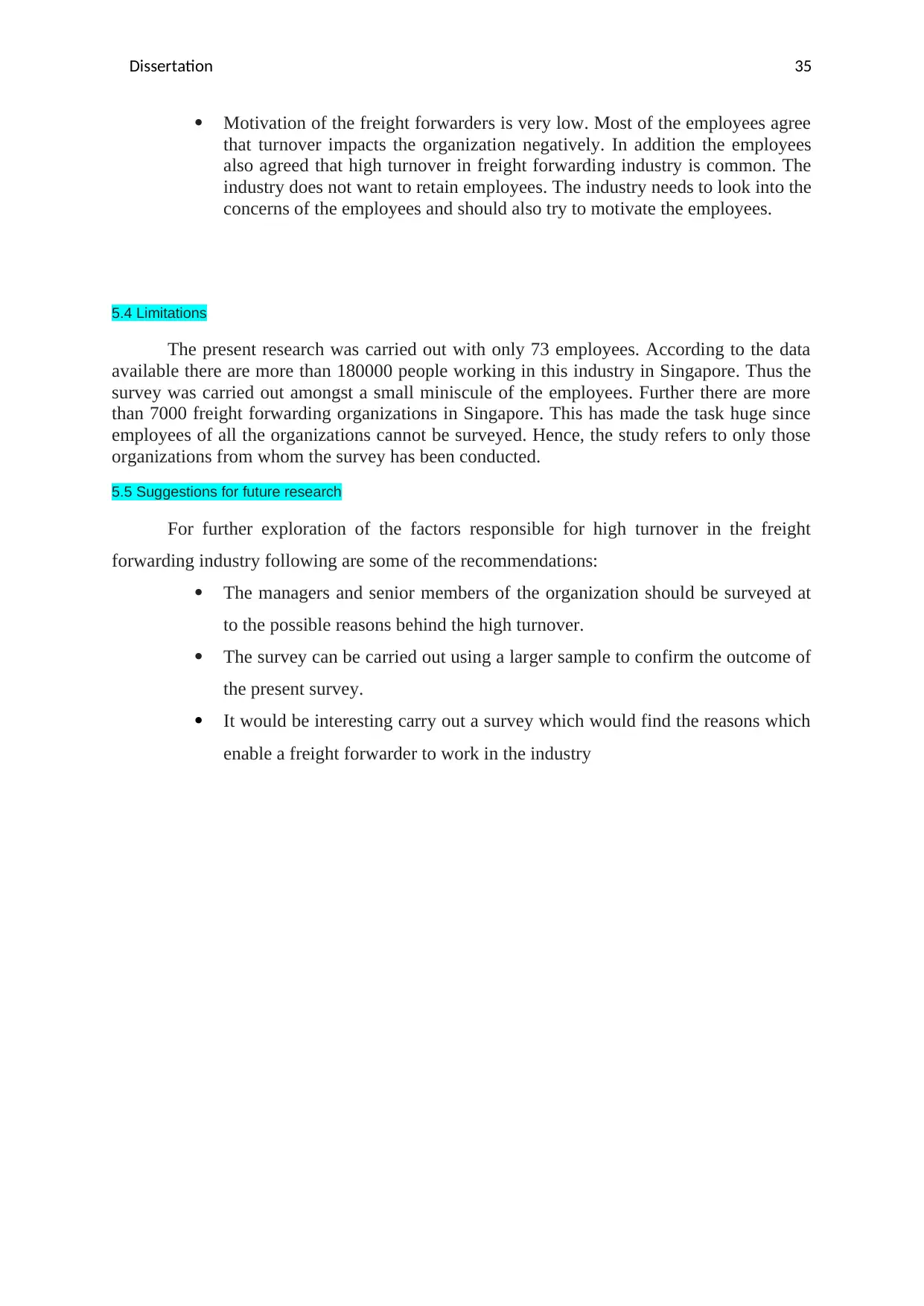
Dissertation 35
Motivation of the freight forwarders is very low. Most of the employees agree
that turnover impacts the organization negatively. In addition the employees
also agreed that high turnover in freight forwarding industry is common. The
industry does not want to retain employees. The industry needs to look into the
concerns of the employees and should also try to motivate the employees.
5.4 Limitations
The present research was carried out with only 73 employees. According to the data
available there are more than 180000 people working in this industry in Singapore. Thus the
survey was carried out amongst a small miniscule of the employees. Further there are more
than 7000 freight forwarding organizations in Singapore. This has made the task huge since
employees of all the organizations cannot be surveyed. Hence, the study refers to only those
organizations from whom the survey has been conducted.
5.5 Suggestions for future research
For further exploration of the factors responsible for high turnover in the freight
forwarding industry following are some of the recommendations:
The managers and senior members of the organization should be surveyed at
to the possible reasons behind the high turnover.
The survey can be carried out using a larger sample to confirm the outcome of
the present survey.
It would be interesting carry out a survey which would find the reasons which
enable a freight forwarder to work in the industry
Motivation of the freight forwarders is very low. Most of the employees agree
that turnover impacts the organization negatively. In addition the employees
also agreed that high turnover in freight forwarding industry is common. The
industry does not want to retain employees. The industry needs to look into the
concerns of the employees and should also try to motivate the employees.
5.4 Limitations
The present research was carried out with only 73 employees. According to the data
available there are more than 180000 people working in this industry in Singapore. Thus the
survey was carried out amongst a small miniscule of the employees. Further there are more
than 7000 freight forwarding organizations in Singapore. This has made the task huge since
employees of all the organizations cannot be surveyed. Hence, the study refers to only those
organizations from whom the survey has been conducted.
5.5 Suggestions for future research
For further exploration of the factors responsible for high turnover in the freight
forwarding industry following are some of the recommendations:
The managers and senior members of the organization should be surveyed at
to the possible reasons behind the high turnover.
The survey can be carried out using a larger sample to confirm the outcome of
the present survey.
It would be interesting carry out a survey which would find the reasons which
enable a freight forwarder to work in the industry
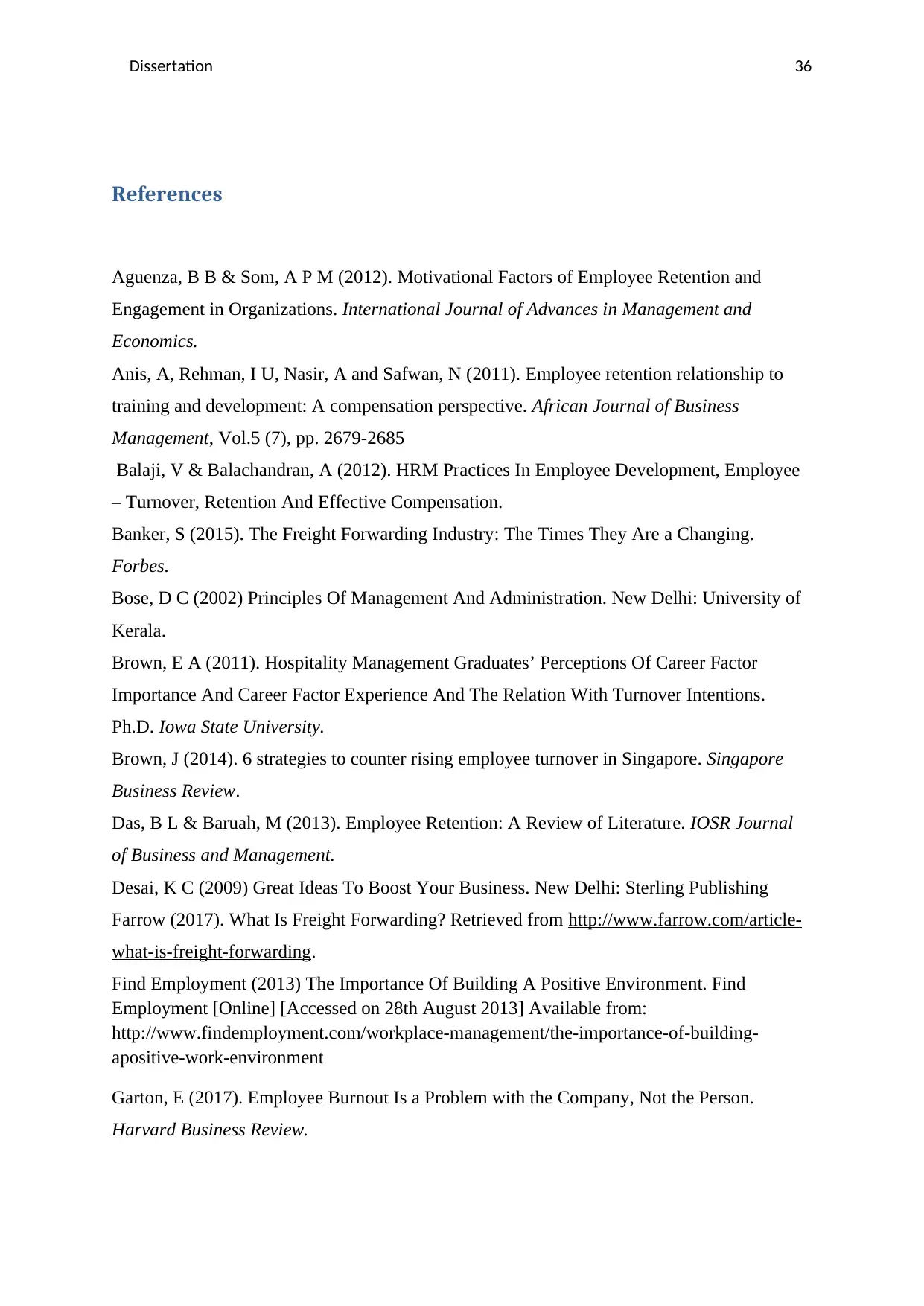
Dissertation 36
References
Aguenza, B B & Som, A P M (2012). Motivational Factors of Employee Retention and
Engagement in Organizations. International Journal of Advances in Management and
Economics.
Anis, A, Rehman, I U, Nasir, A and Safwan, N (2011). Employee retention relationship to
training and development: A compensation perspective. African Journal of Business
Management, Vol.5 (7), pp. 2679-2685
Balaji, V & Balachandran, A (2012). HRM Practices In Employee Development, Employee
– Turnover, Retention And Effective Compensation.
Banker, S (2015). The Freight Forwarding Industry: The Times They Are a Changing.
Forbes.
Bose, D C (2002) Principles Of Management And Administration. New Delhi: University of
Kerala.
Brown, E A (2011). Hospitality Management Graduates’ Perceptions Of Career Factor
Importance And Career Factor Experience And The Relation With Turnover Intentions.
Ph.D. Iowa State University.
Brown, J (2014). 6 strategies to counter rising employee turnover in Singapore. Singapore
Business Review.
Das, B L & Baruah, M (2013). Employee Retention: A Review of Literature. IOSR Journal
of Business and Management.
Desai, K C (2009) Great Ideas To Boost Your Business. New Delhi: Sterling Publishing
Farrow (2017). What Is Freight Forwarding? Retrieved from http://www.farrow.com/article-
what-is-freight-forwarding.
Find Employment (2013) The Importance Of Building A Positive Environment. Find
Employment [Online] [Accessed on 28th August 2013] Available from:
http://www.findemployment.com/workplace-management/the-importance-of-building-
apositive-work-environment
Garton, E (2017). Employee Burnout Is a Problem with the Company, Not the Person.
Harvard Business Review.
References
Aguenza, B B & Som, A P M (2012). Motivational Factors of Employee Retention and
Engagement in Organizations. International Journal of Advances in Management and
Economics.
Anis, A, Rehman, I U, Nasir, A and Safwan, N (2011). Employee retention relationship to
training and development: A compensation perspective. African Journal of Business
Management, Vol.5 (7), pp. 2679-2685
Balaji, V & Balachandran, A (2012). HRM Practices In Employee Development, Employee
– Turnover, Retention And Effective Compensation.
Banker, S (2015). The Freight Forwarding Industry: The Times They Are a Changing.
Forbes.
Bose, D C (2002) Principles Of Management And Administration. New Delhi: University of
Kerala.
Brown, E A (2011). Hospitality Management Graduates’ Perceptions Of Career Factor
Importance And Career Factor Experience And The Relation With Turnover Intentions.
Ph.D. Iowa State University.
Brown, J (2014). 6 strategies to counter rising employee turnover in Singapore. Singapore
Business Review.
Das, B L & Baruah, M (2013). Employee Retention: A Review of Literature. IOSR Journal
of Business and Management.
Desai, K C (2009) Great Ideas To Boost Your Business. New Delhi: Sterling Publishing
Farrow (2017). What Is Freight Forwarding? Retrieved from http://www.farrow.com/article-
what-is-freight-forwarding.
Find Employment (2013) The Importance Of Building A Positive Environment. Find
Employment [Online] [Accessed on 28th August 2013] Available from:
http://www.findemployment.com/workplace-management/the-importance-of-building-
apositive-work-environment
Garton, E (2017). Employee Burnout Is a Problem with the Company, Not the Person.
Harvard Business Review.
Paraphrase This Document
Need a fresh take? Get an instant paraphrase of this document with our AI Paraphraser
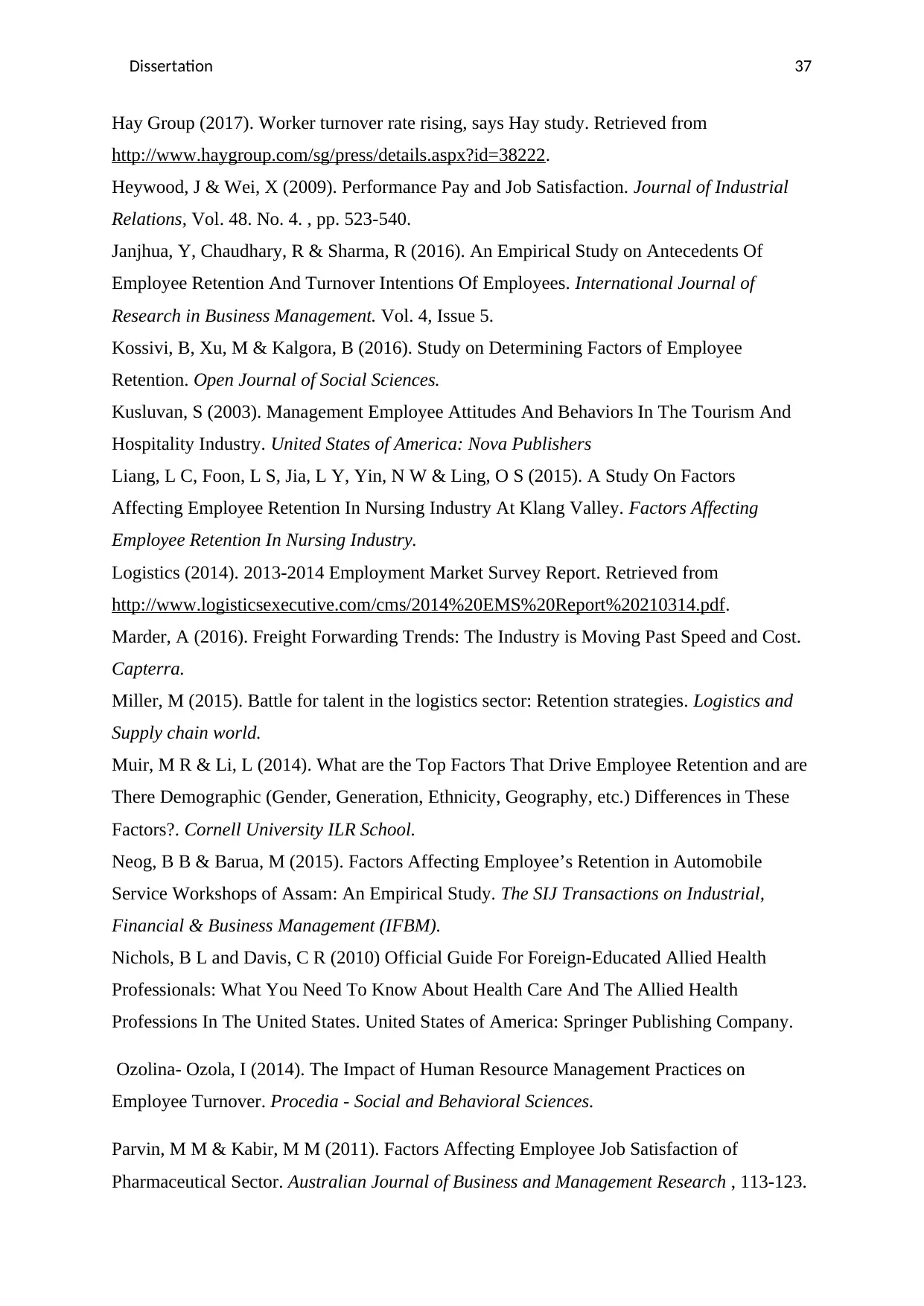
Dissertation 37
Hay Group (2017). Worker turnover rate rising, says Hay study. Retrieved from
http://www.haygroup.com/sg/press/details.aspx?id=38222.
Heywood, J & Wei, X (2009). Performance Pay and Job Satisfaction. Journal of Industrial
Relations, Vol. 48. No. 4. , pp. 523-540.
Janjhua, Y, Chaudhary, R & Sharma, R (2016). An Empirical Study on Antecedents Of
Employee Retention And Turnover Intentions Of Employees. International Journal of
Research in Business Management. Vol. 4, Issue 5.
Kossivi, B, Xu, M & Kalgora, B (2016). Study on Determining Factors of Employee
Retention. Open Journal of Social Sciences.
Kusluvan, S (2003). Management Employee Attitudes And Behaviors In The Tourism And
Hospitality Industry. United States of America: Nova Publishers
Liang, L C, Foon, L S, Jia, L Y, Yin, N W & Ling, O S (2015). A Study On Factors
Affecting Employee Retention In Nursing Industry At Klang Valley. Factors Affecting
Employee Retention In Nursing Industry.
Logistics (2014). 2013-2014 Employment Market Survey Report. Retrieved from
http://www.logisticsexecutive.com/cms/2014%20EMS%20Report%20210314.pdf.
Marder, A (2016). Freight Forwarding Trends: The Industry is Moving Past Speed and Cost.
Capterra.
Miller, M (2015). Battle for talent in the logistics sector: Retention strategies. Logistics and
Supply chain world.
Muir, M R & Li, L (2014). What are the Top Factors That Drive Employee Retention and are
There Demographic (Gender, Generation, Ethnicity, Geography, etc.) Differences in These
Factors?. Cornell University ILR School.
Neog, B B & Barua, M (2015). Factors Affecting Employee’s Retention in Automobile
Service Workshops of Assam: An Empirical Study. The SIJ Transactions on Industrial,
Financial & Business Management (IFBM).
Nichols, B L and Davis, C R (2010) Official Guide For Foreign-Educated Allied Health
Professionals: What You Need To Know About Health Care And The Allied Health
Professions In The United States. United States of America: Springer Publishing Company.
Ozolina- Ozola, I (2014). The Impact of Human Resource Management Practices on
Employee Turnover. Procedia - Social and Behavioral Sciences.
Parvin, M M & Kabir, M M (2011). Factors Affecting Employee Job Satisfaction of
Pharmaceutical Sector. Australian Journal of Business and Management Research , 113-123.
Hay Group (2017). Worker turnover rate rising, says Hay study. Retrieved from
http://www.haygroup.com/sg/press/details.aspx?id=38222.
Heywood, J & Wei, X (2009). Performance Pay and Job Satisfaction. Journal of Industrial
Relations, Vol. 48. No. 4. , pp. 523-540.
Janjhua, Y, Chaudhary, R & Sharma, R (2016). An Empirical Study on Antecedents Of
Employee Retention And Turnover Intentions Of Employees. International Journal of
Research in Business Management. Vol. 4, Issue 5.
Kossivi, B, Xu, M & Kalgora, B (2016). Study on Determining Factors of Employee
Retention. Open Journal of Social Sciences.
Kusluvan, S (2003). Management Employee Attitudes And Behaviors In The Tourism And
Hospitality Industry. United States of America: Nova Publishers
Liang, L C, Foon, L S, Jia, L Y, Yin, N W & Ling, O S (2015). A Study On Factors
Affecting Employee Retention In Nursing Industry At Klang Valley. Factors Affecting
Employee Retention In Nursing Industry.
Logistics (2014). 2013-2014 Employment Market Survey Report. Retrieved from
http://www.logisticsexecutive.com/cms/2014%20EMS%20Report%20210314.pdf.
Marder, A (2016). Freight Forwarding Trends: The Industry is Moving Past Speed and Cost.
Capterra.
Miller, M (2015). Battle for talent in the logistics sector: Retention strategies. Logistics and
Supply chain world.
Muir, M R & Li, L (2014). What are the Top Factors That Drive Employee Retention and are
There Demographic (Gender, Generation, Ethnicity, Geography, etc.) Differences in These
Factors?. Cornell University ILR School.
Neog, B B & Barua, M (2015). Factors Affecting Employee’s Retention in Automobile
Service Workshops of Assam: An Empirical Study. The SIJ Transactions on Industrial,
Financial & Business Management (IFBM).
Nichols, B L and Davis, C R (2010) Official Guide For Foreign-Educated Allied Health
Professionals: What You Need To Know About Health Care And The Allied Health
Professions In The United States. United States of America: Springer Publishing Company.
Ozolina- Ozola, I (2014). The Impact of Human Resource Management Practices on
Employee Turnover. Procedia - Social and Behavioral Sciences.
Parvin, M M & Kabir, M M (2011). Factors Affecting Employee Job Satisfaction of
Pharmaceutical Sector. Australian Journal of Business and Management Research , 113-123.
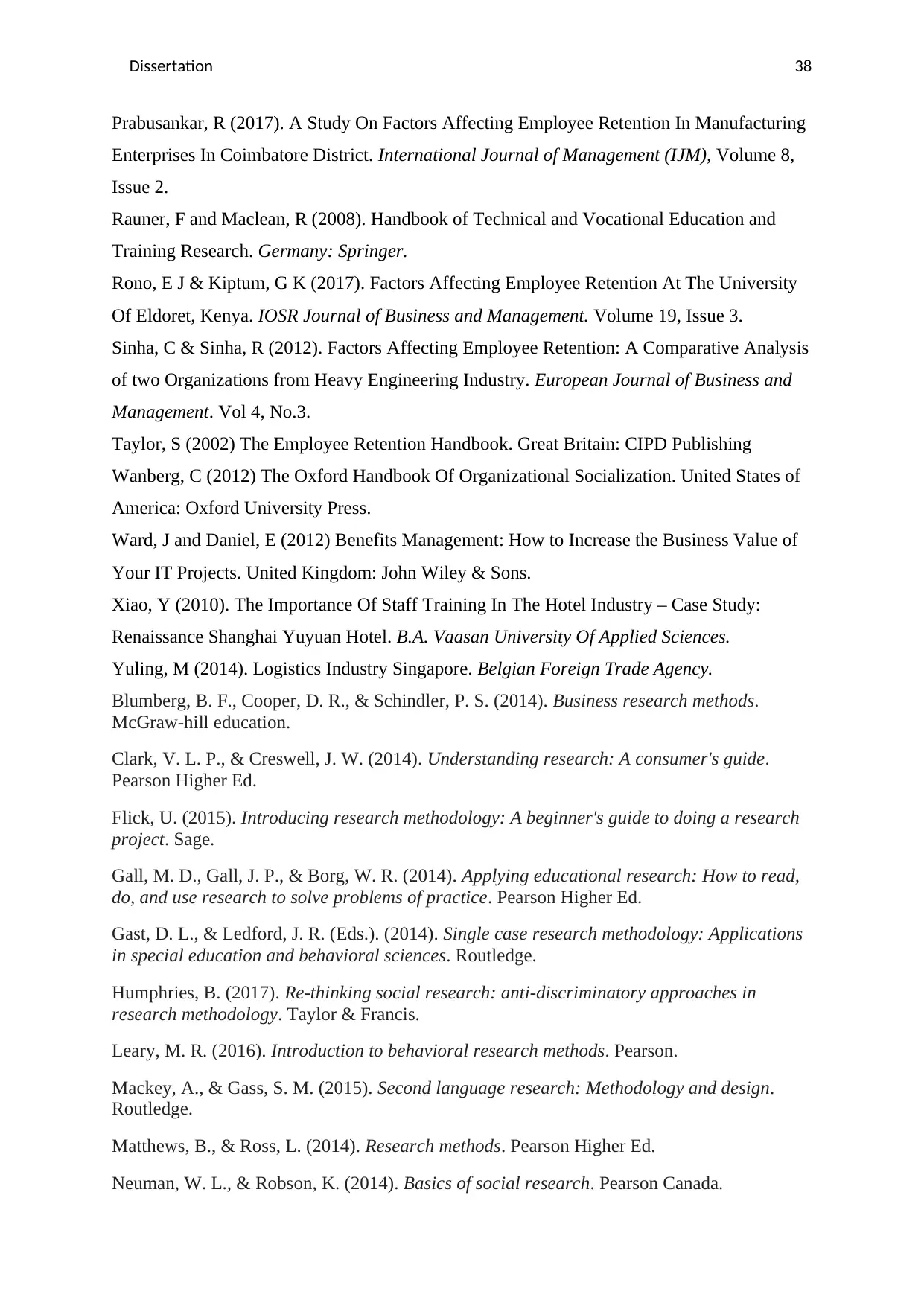
Dissertation 38
Prabusankar, R (2017). A Study On Factors Affecting Employee Retention In Manufacturing
Enterprises In Coimbatore District. International Journal of Management (IJM), Volume 8,
Issue 2.
Rauner, F and Maclean, R (2008). Handbook of Technical and Vocational Education and
Training Research. Germany: Springer.
Rono, E J & Kiptum, G K (2017). Factors Affecting Employee Retention At The University
Of Eldoret, Kenya. IOSR Journal of Business and Management. Volume 19, Issue 3.
Sinha, C & Sinha, R (2012). Factors Affecting Employee Retention: A Comparative Analysis
of two Organizations from Heavy Engineering Industry. European Journal of Business and
Management. Vol 4, No.3.
Taylor, S (2002) The Employee Retention Handbook. Great Britain: CIPD Publishing
Wanberg, C (2012) The Oxford Handbook Of Organizational Socialization. United States of
America: Oxford University Press.
Ward, J and Daniel, E (2012) Benefits Management: How to Increase the Business Value of
Your IT Projects. United Kingdom: John Wiley & Sons.
Xiao, Y (2010). The Importance Of Staff Training In The Hotel Industry – Case Study:
Renaissance Shanghai Yuyuan Hotel. B.A. Vaasan University Of Applied Sciences.
Yuling, M (2014). Logistics Industry Singapore. Belgian Foreign Trade Agency.
Blumberg, B. F., Cooper, D. R., & Schindler, P. S. (2014). Business research methods.
McGraw-hill education.
Clark, V. L. P., & Creswell, J. W. (2014). Understanding research: A consumer's guide.
Pearson Higher Ed.
Flick, U. (2015). Introducing research methodology: A beginner's guide to doing a research
project. Sage.
Gall, M. D., Gall, J. P., & Borg, W. R. (2014). Applying educational research: How to read,
do, and use research to solve problems of practice. Pearson Higher Ed.
Gast, D. L., & Ledford, J. R. (Eds.). (2014). Single case research methodology: Applications
in special education and behavioral sciences. Routledge.
Humphries, B. (2017). Re-thinking social research: anti-discriminatory approaches in
research methodology. Taylor & Francis.
Leary, M. R. (2016). Introduction to behavioral research methods. Pearson.
Mackey, A., & Gass, S. M. (2015). Second language research: Methodology and design.
Routledge.
Matthews, B., & Ross, L. (2014). Research methods. Pearson Higher Ed.
Neuman, W. L., & Robson, K. (2014). Basics of social research. Pearson Canada.
Prabusankar, R (2017). A Study On Factors Affecting Employee Retention In Manufacturing
Enterprises In Coimbatore District. International Journal of Management (IJM), Volume 8,
Issue 2.
Rauner, F and Maclean, R (2008). Handbook of Technical and Vocational Education and
Training Research. Germany: Springer.
Rono, E J & Kiptum, G K (2017). Factors Affecting Employee Retention At The University
Of Eldoret, Kenya. IOSR Journal of Business and Management. Volume 19, Issue 3.
Sinha, C & Sinha, R (2012). Factors Affecting Employee Retention: A Comparative Analysis
of two Organizations from Heavy Engineering Industry. European Journal of Business and
Management. Vol 4, No.3.
Taylor, S (2002) The Employee Retention Handbook. Great Britain: CIPD Publishing
Wanberg, C (2012) The Oxford Handbook Of Organizational Socialization. United States of
America: Oxford University Press.
Ward, J and Daniel, E (2012) Benefits Management: How to Increase the Business Value of
Your IT Projects. United Kingdom: John Wiley & Sons.
Xiao, Y (2010). The Importance Of Staff Training In The Hotel Industry – Case Study:
Renaissance Shanghai Yuyuan Hotel. B.A. Vaasan University Of Applied Sciences.
Yuling, M (2014). Logistics Industry Singapore. Belgian Foreign Trade Agency.
Blumberg, B. F., Cooper, D. R., & Schindler, P. S. (2014). Business research methods.
McGraw-hill education.
Clark, V. L. P., & Creswell, J. W. (2014). Understanding research: A consumer's guide.
Pearson Higher Ed.
Flick, U. (2015). Introducing research methodology: A beginner's guide to doing a research
project. Sage.
Gall, M. D., Gall, J. P., & Borg, W. R. (2014). Applying educational research: How to read,
do, and use research to solve problems of practice. Pearson Higher Ed.
Gast, D. L., & Ledford, J. R. (Eds.). (2014). Single case research methodology: Applications
in special education and behavioral sciences. Routledge.
Humphries, B. (2017). Re-thinking social research: anti-discriminatory approaches in
research methodology. Taylor & Francis.
Leary, M. R. (2016). Introduction to behavioral research methods. Pearson.
Mackey, A., & Gass, S. M. (2015). Second language research: Methodology and design.
Routledge.
Matthews, B., & Ross, L. (2014). Research methods. Pearson Higher Ed.
Neuman, W. L., & Robson, K. (2014). Basics of social research. Pearson Canada.
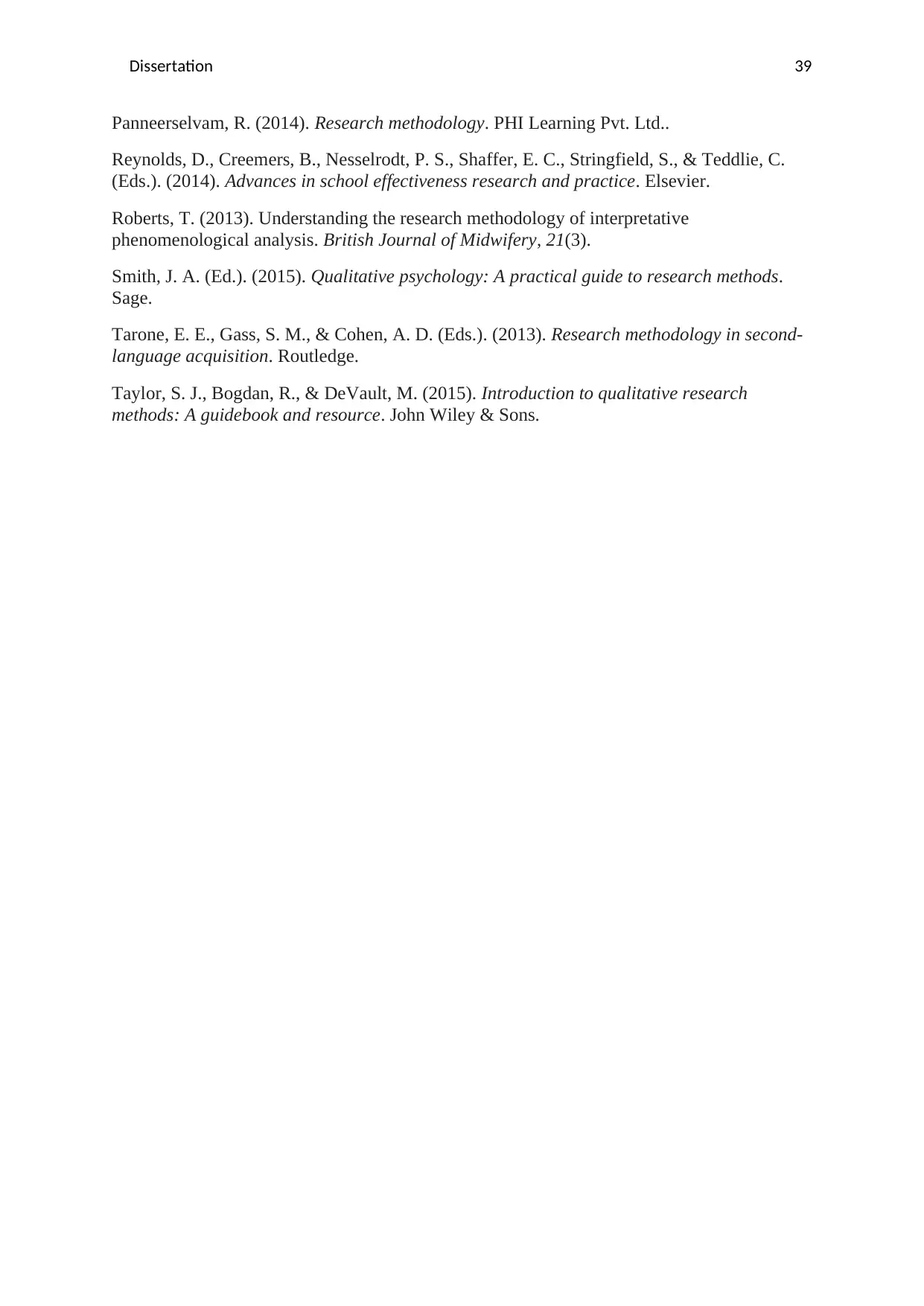
Dissertation 39
Panneerselvam, R. (2014). Research methodology. PHI Learning Pvt. Ltd..
Reynolds, D., Creemers, B., Nesselrodt, P. S., Shaffer, E. C., Stringfield, S., & Teddlie, C.
(Eds.). (2014). Advances in school effectiveness research and practice. Elsevier.
Roberts, T. (2013). Understanding the research methodology of interpretative
phenomenological analysis. British Journal of Midwifery, 21(3).
Smith, J. A. (Ed.). (2015). Qualitative psychology: A practical guide to research methods.
Sage.
Tarone, E. E., Gass, S. M., & Cohen, A. D. (Eds.). (2013). Research methodology in second-
language acquisition. Routledge.
Taylor, S. J., Bogdan, R., & DeVault, M. (2015). Introduction to qualitative research
methods: A guidebook and resource. John Wiley & Sons.
Panneerselvam, R. (2014). Research methodology. PHI Learning Pvt. Ltd..
Reynolds, D., Creemers, B., Nesselrodt, P. S., Shaffer, E. C., Stringfield, S., & Teddlie, C.
(Eds.). (2014). Advances in school effectiveness research and practice. Elsevier.
Roberts, T. (2013). Understanding the research methodology of interpretative
phenomenological analysis. British Journal of Midwifery, 21(3).
Smith, J. A. (Ed.). (2015). Qualitative psychology: A practical guide to research methods.
Sage.
Tarone, E. E., Gass, S. M., & Cohen, A. D. (Eds.). (2013). Research methodology in second-
language acquisition. Routledge.
Taylor, S. J., Bogdan, R., & DeVault, M. (2015). Introduction to qualitative research
methods: A guidebook and resource. John Wiley & Sons.
1 out of 40
Related Documents
Your All-in-One AI-Powered Toolkit for Academic Success.
+13062052269
info@desklib.com
Available 24*7 on WhatsApp / Email
![[object Object]](/_next/static/media/star-bottom.7253800d.svg)
Unlock your academic potential
© 2024 | Zucol Services PVT LTD | All rights reserved.





